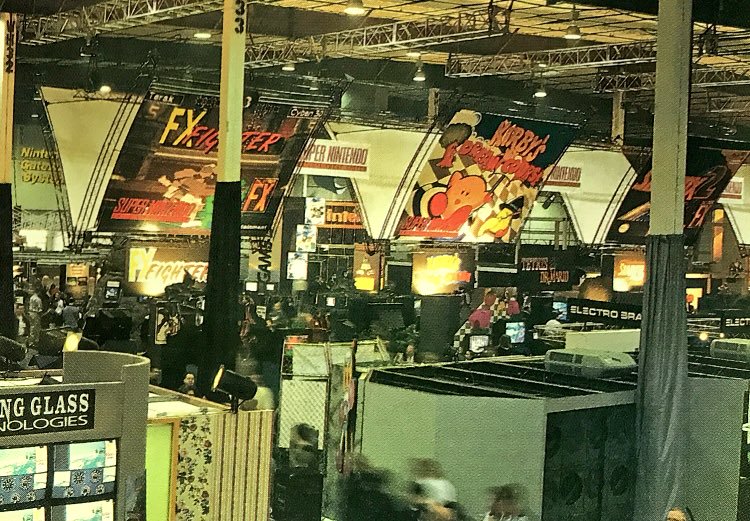Hey, Frank Cifaldi from the VGHF here. Before we kick things over to Clyde Mandelin for our main feature, I wanted to talk briefly about not only how we managed to recover development data from Nintendo’s EarthBound, but how fickle and volatile this material can be.
When we talk about video game source material, we’re talking about many different types of objects, including concept art, design documentation, letters of correspondence, and of course the source code itself. We feel that any surviving artifact that went into making a game could be of historical interest to the right person.
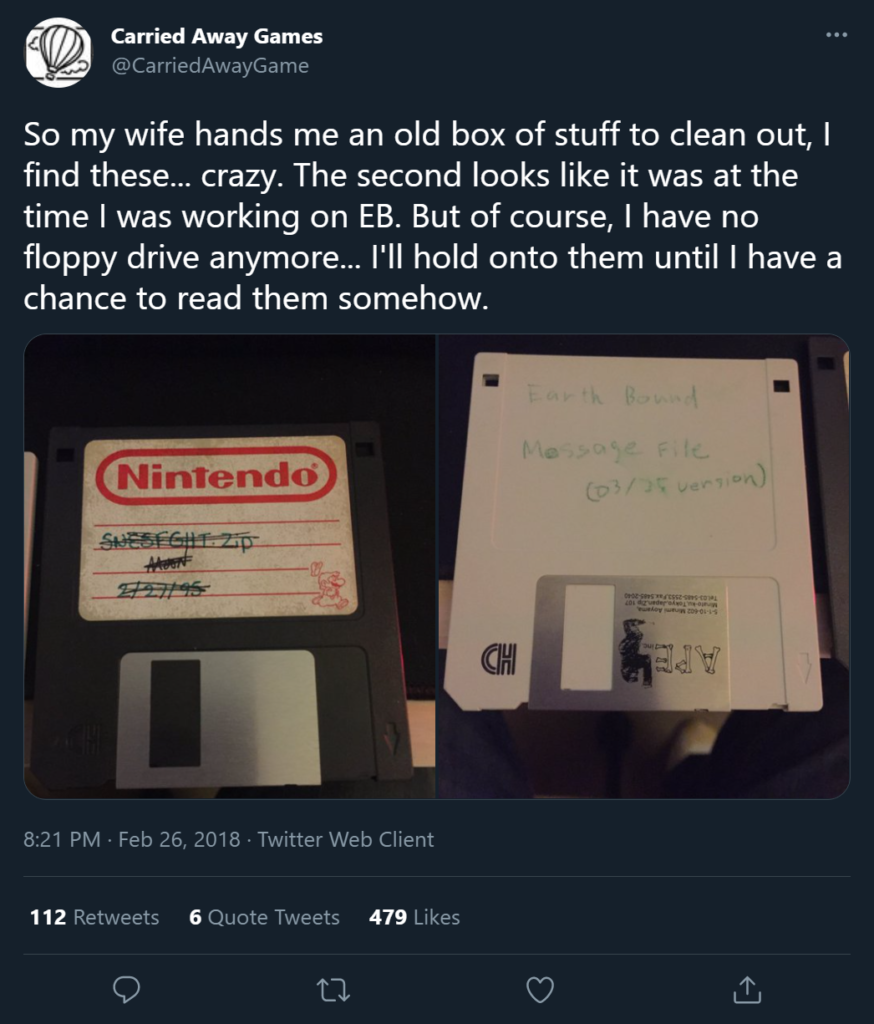
The artifact we’re talking about today is a great example of this. Former Nintendo of America employee Marcus Lindblom was the man mainly responsible for the English-language script for EarthBound, a localization so revered that there’s a book about it. In 2018, Lindblom and his wife re-discovered floppy disks from his time at Nintendo, including the raw scripting files used during the creation of the game!
After putting the disk in a floppy drive, Lindblom was dismayed to find that he had deleted the EarthBound files long ago, and had reused the disk for some unrelated work. He ended up donating the disk to us, the hope being that we could do some digital forensics and possibly recover some EarthBound data from the disk, and if not, well, at least we’d have a curious little display piece with the disk itself.
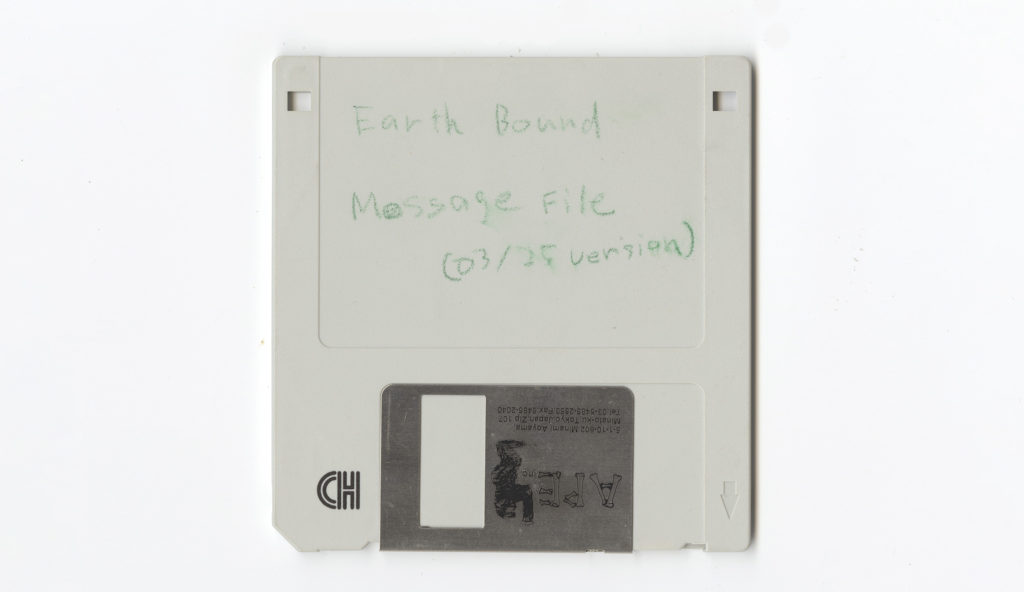
Did you know that when you delete data from a disk, or even your hard drive, it doesn’t automatically disappear? The data sits in limbo, waiting to be overwritten by new files. Until that happens, it’s all still there, it’s just missing the reference info needed for your computer to understand it.
In the case of Lindblom’s disk, the only new file he had written after deleting the EarthBound files was a tiny text document, barely a paragraph long. Miraculously, since that new data was so miniscule, we were able to forensically recover all of the deleted EarthBound data, with high confidence that none of the data had been compromised! It appears to be the entirety of EarthBound’s scripting files, in the original scripting language that was likely used by the game’s development team, Ape, in Japan.
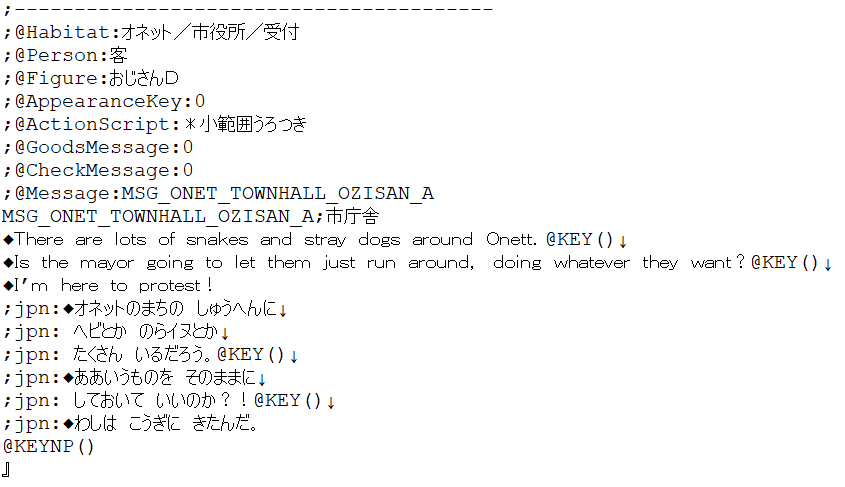
While it’s tempting to dismiss this data as not being historically interesting (after all, if it’s just the script, isn’t it all in the game?), a closer examination reveals many things hidden to an EarthBound player, including character names, unused dialogue and cutscenes, and even developer notes!
We’re big believers at the VGHF that data in the right historian’s hands can lift the veil on some amazing video game development secrets. So we were thrilled when Clyde Mandelin, who literally wrote the book on this game’s localization, agreed to look through the files and share his findings with us!
The following is mirrored from Mandelin’s Legends of Localization website, with minor omissions. The scripting files are hosted on The Internet Archive.
A brief interruption.
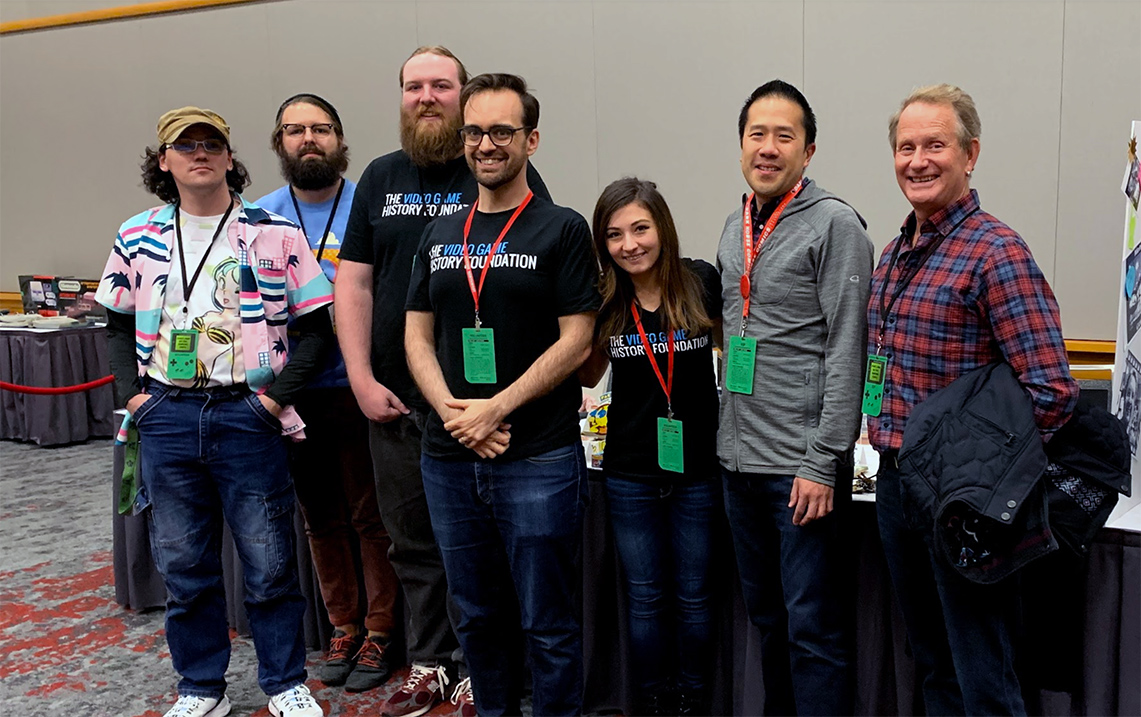
Your generous donations are what keep us going! We are a 501(c)3 charity dedicated to preserving and teaching the history of video games. If you’re able, please consider becoming a sustaining member today, either by credit card, Paypal, or better yet, by joining our Patreon community.
New Discoveries About EarthBound’s Development and Localization
In 1994, Nintendo released the cult hit MOTHER 2 in Japan. In 1995, the game was localized into English and released in North America as EarthBound.
During its jump from Japanese to English, EarthBound changed in many ways. I started documenting these differences twenty years ago, and more recently wrote a 400-page book about the game’s localization.
But just when I thought there was nothing left to write about, the Video Game History Foundation somehow unearthed old development files from about halfway through EarthBound’s English localization.
Naturally, these pre-release files let us see how things looked during EarthBound’s localization, which is fascinating in itself. But, because the game’s script is deeply intertwined with the game’s programming, these files also provide glimpses of:
- Unused scenes
- Unused text
- Early gameplay ideas that were scrapped
- Game details never revealed before
- Comments from the writers, developers, and translators
Basically, even after playing, documenting, and reverse engineering EarthBound for 25 years, I was amazed by what these files contained. The files contain so much new information and so many answers to old questions that I wasn’t really sure what to do with it all. So, for now, I thought I’d share a few of my favorite discoveries in this article, which covers maybe 15% of what I found.
These files are a genuinely fascinating piece of video game history. Even if you’re not a big EarthBound fan, I think you’ll find some of the stuff below interesting!
Gameplay Discoveries
Some of the EarthBound development files refer to story events and gameplay mechanics that didn’t make it into the final Japanese and English games. Below are some good examples.
Fighting the Police
In the final version of the game, five police officers attack you one after the other – but once you’ve defeated the fourth one, the fifth one gets scared and runs away. Developer notes suggest that you would’ve originally been able to fight all five police officers, and in any order of your choosing.
Here’s what the fifth police officer would’ve said before battle:
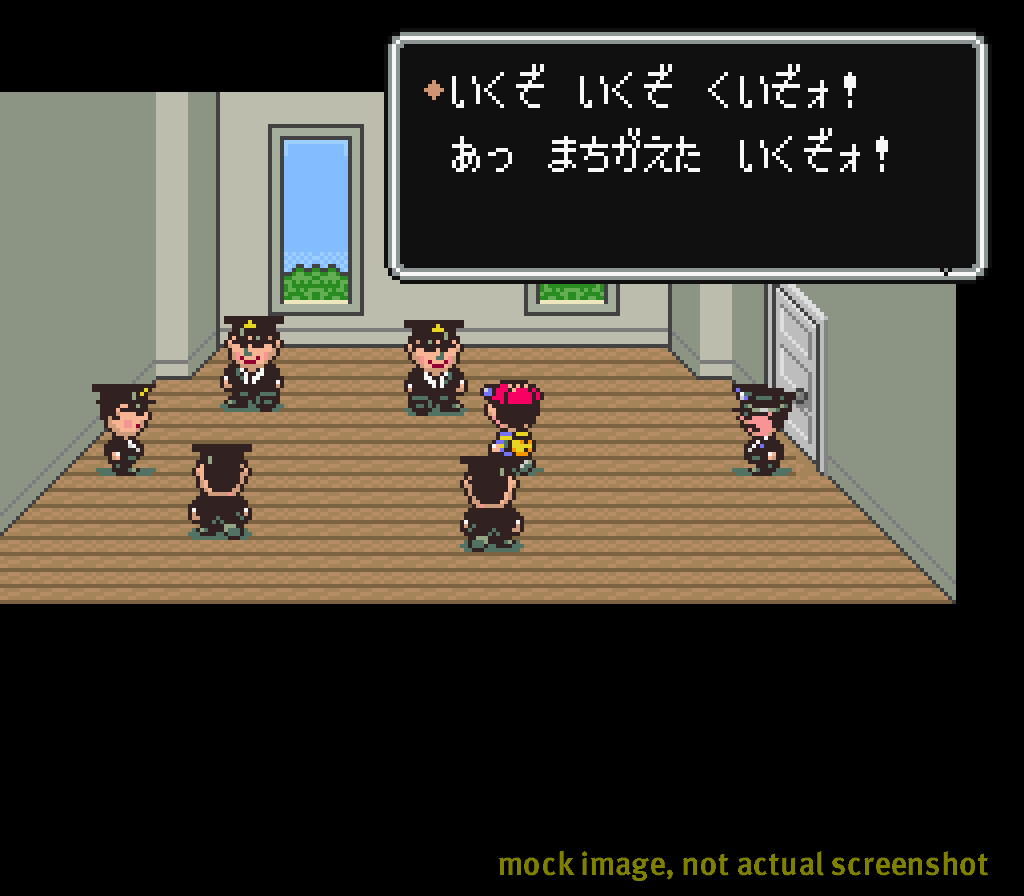
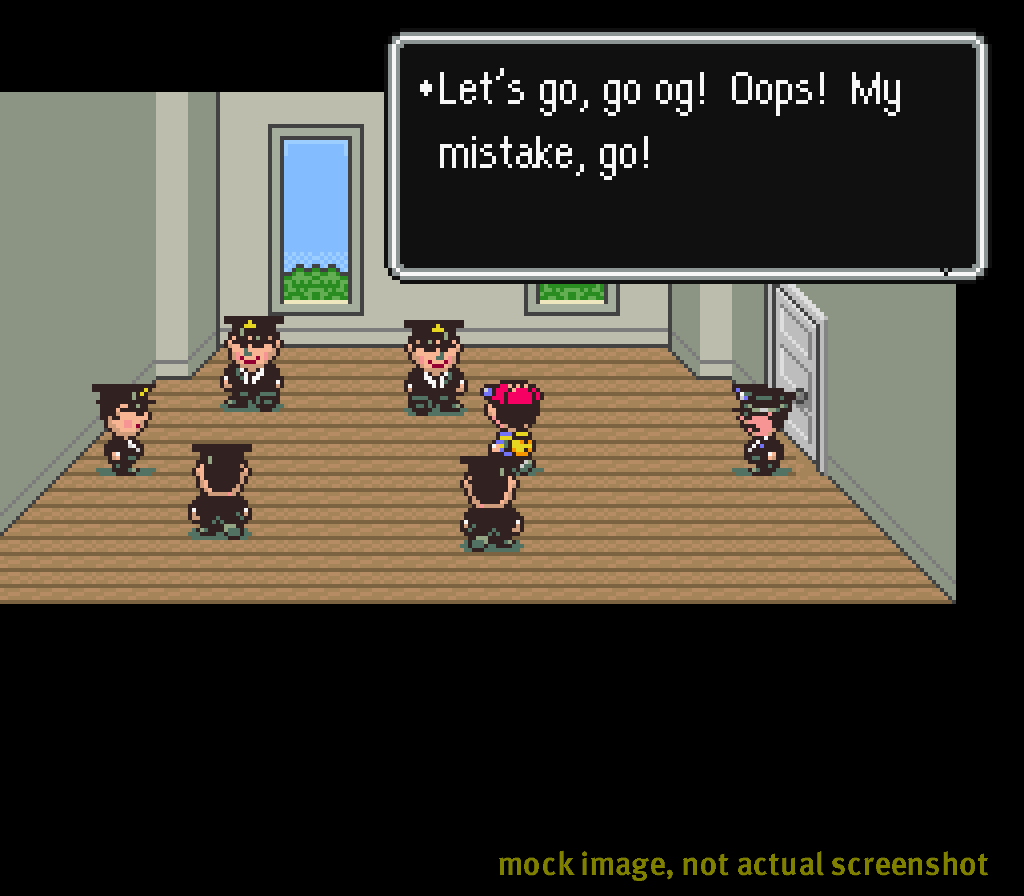
| Japanese text | Official translation |
|---|---|
| ◆いくぞ いくぞ くいぞォ! あっ まちがえた いくぞォ! | ・Let’s go, go og! Oops! My mistake, go! |
After you won the the battle, the officer would’ve said:
| Japanese text | Official translation |
|---|---|
| ◆どーも しつれいいたしやしたっ! ジャン ジャン。 | ・’scuse me! Uuuuuh… yeah. |
According to the development files, the encounter with the police captain afterward would’ve progressed slightly differently too. It sounds like you’d still have to fight him, but much of the scene would happen elsewhere in the police station and involve the secretary in some way.
Fake Theater Tickets
At some point in the game’s development, there was a character who called himself “the Weakest Man in All of Twoson”. You’d have to fight him, and if you won, you’d receive a ticket to the nearby Chaos Theater.
None of this is in the final game at all, so it’s not clear how it fit into the game. For now, here’s all of the relevant unused text from the developer files. Note that none of this text was translated into English – the translations below are mine.
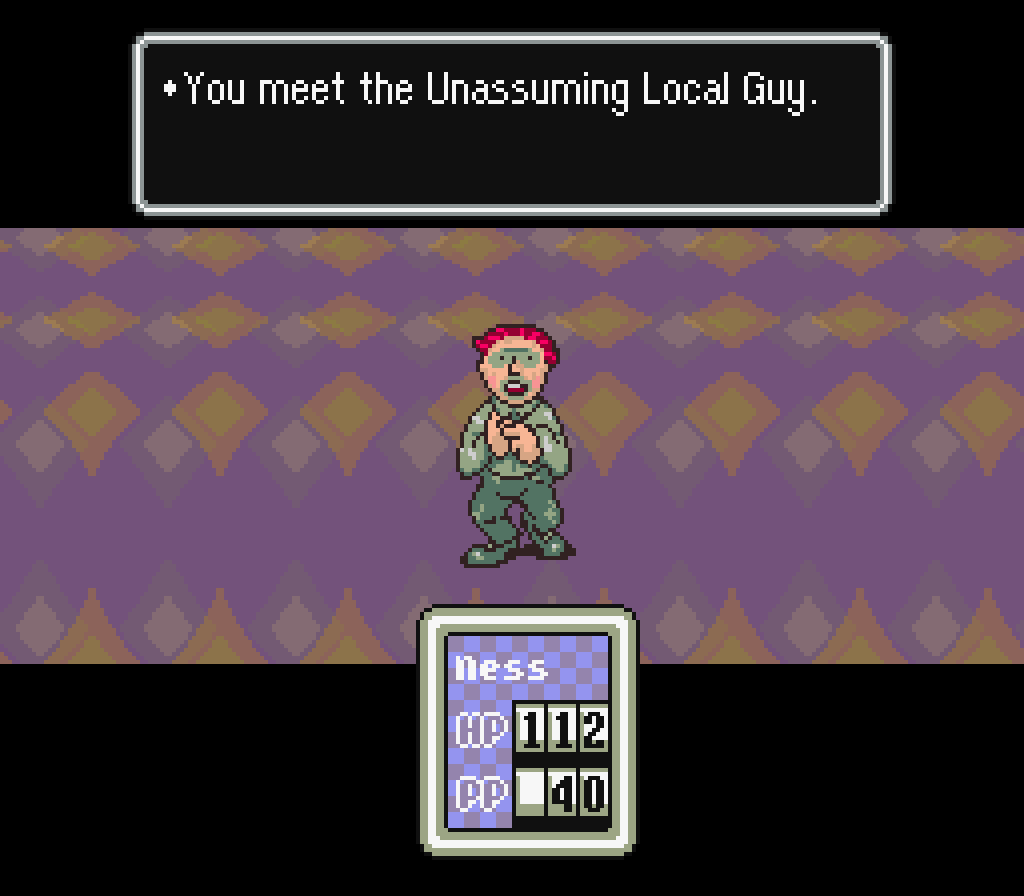
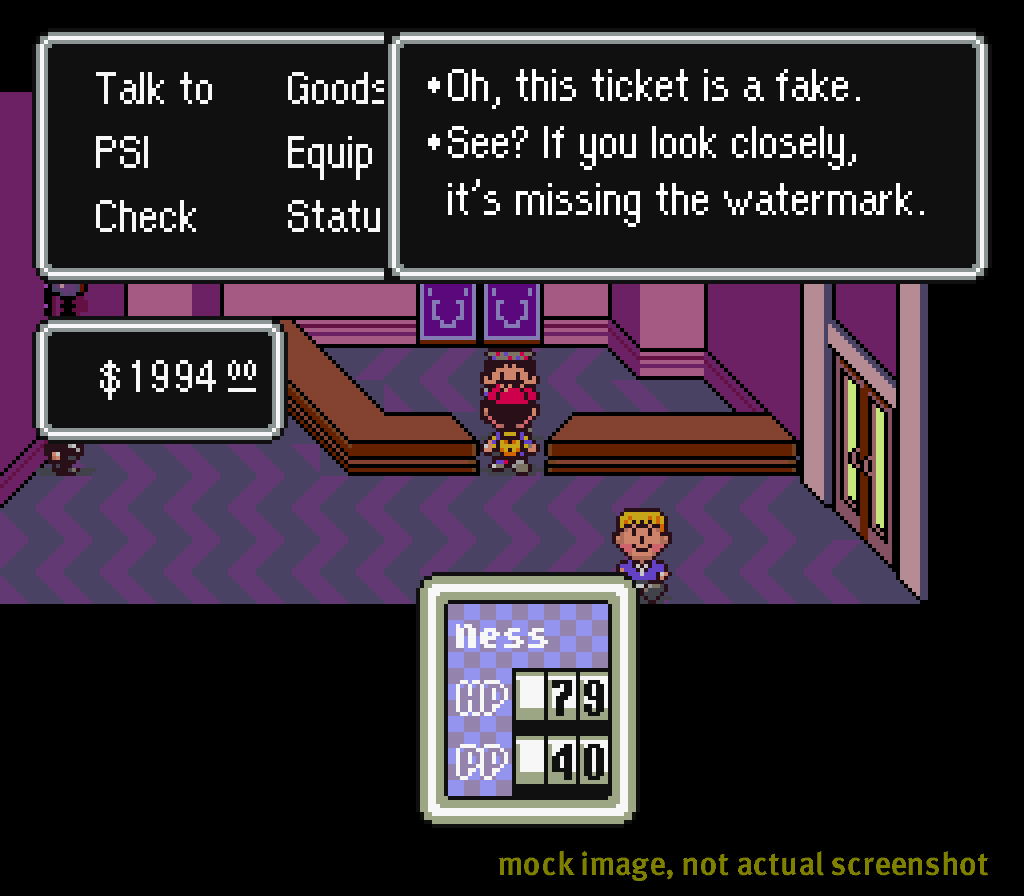
When first meeting the character:
| Japanese text | Official translation |
|---|---|
| ◆おっ おっ おっ ツーソンでいちばんよわいと いわれている おれさまに‥‥ ◆ケンカを うってくるきだな。 ◆こどもあいてなら だいじょうぶだ! いくぞ! | ・Oh, what’s this, now? You wanna pick a fight with ME, the Weakest Man in All of Twoson? ・But you’re just a kid, so this should be no sweat! Get ready! |
After defeating the character:
| Japanese text | Official translation |
|---|---|
| ◆やっぱり まけたか。 ◆まけて‥‥まけて‥‥にんげんは おおきくなっていくのさ。 ◆かんしゃのきもちだ。 カオスげきじょうの「ちけっと」を あげよう。 | ・Huh. I lost after all. But losing again and again is how people grow. ・Take this as a token of my gratitude. It’s a “ticket” to the Chaos Theater. |
At this point, you’d be given a key item. But if your inventory was full, he’d say this:
| Japanese text | Official translation |
|---|---|
| ◆きみは 「ちけっと」をもつ ゆとりがないね。 ◆いらないものを しまつしてから また おいで ◆かならず「ちけっと」は あげるからさ。 | ・You don’t have room to carry the “ticket”. ・Come see me again after you get rid of stuff you don’t need. ・I promise I’ll give you the “ticket” then. |
Upon taking the fake ticket to the theater, the ticket person would say:
| Japanese text | Official translation |
|---|---|
| ◆あらら このチケットは にせものよ。 ほら よくみると スカシがはいってないでしょ。 ◆あなた わるいひとたちの なかまなんじゃないの。 | ・Oh, this ticket is a fake. ・See? If you look closely, it’s missing the watermark. ・You must be friends with bad people or something. |
Then, if you went back to talk to the Weakest Man in Twoson, he’d say:
| Japanese text | Official translation |
|---|---|
| ◆まえに あげた「ちけっと」 にせチケットだったらしいな。 もうしわけなかったね。 | ・Apparently, the “ticket” I gave you earlier was actually fake. Sorry ’bout that. |
At one point in the development files, the character is identified as a “lookout”. Based on this and other unused text in the final game, it sounds like this character would’ve been posted near the back entrance into Burglin Park.
Zero information about this character exists in the final releases of the game, so this is entirely new stuff I had never seen before!
Lots of Junk
In the final Japanese game, there’s a bit of unused text that suggests a specific vendor in Burglin Park used to sell generic piles of junk. Unfortunately, there are no other hidden details about this junk-buying gameplay mechanic.
Luckily, thanks to these development files, we’ve learned that this character with sunglasses did originally sell piles of junk, and that he sold these piles of junk by the kilogram and by the ton. It sounds like you could spend up to $999 for the kilogram option, and up to $9999 for the ton option.
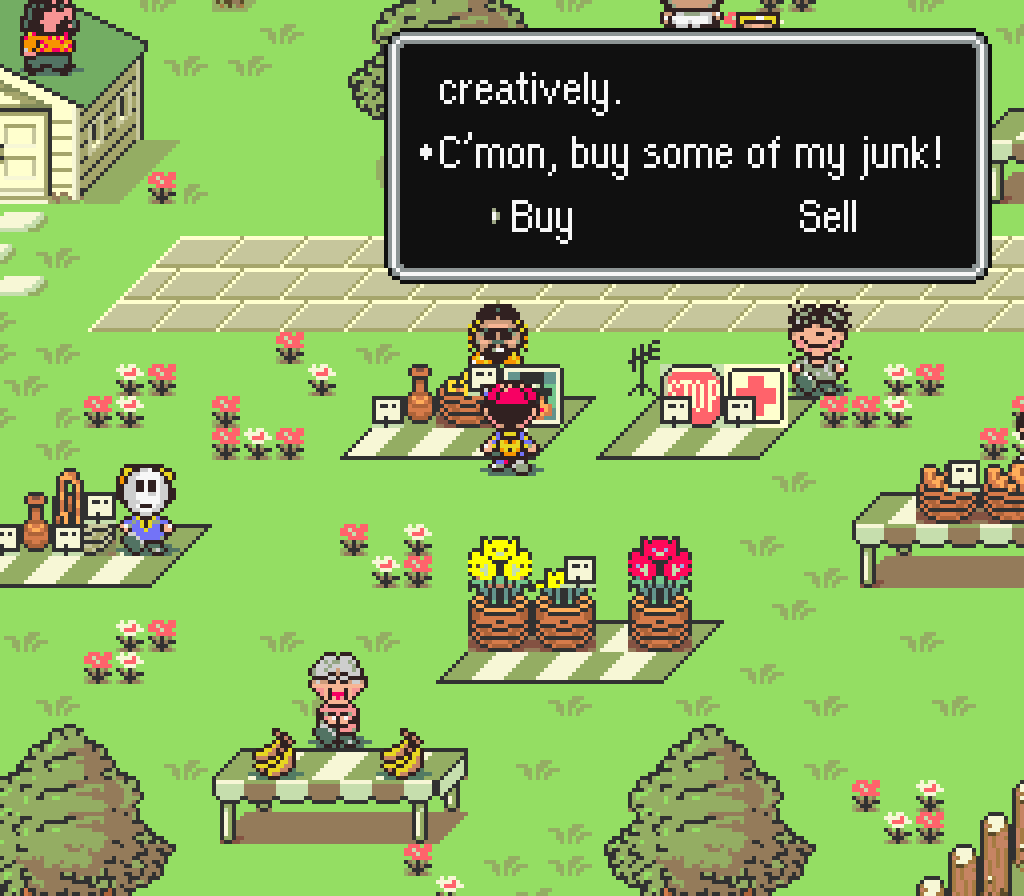
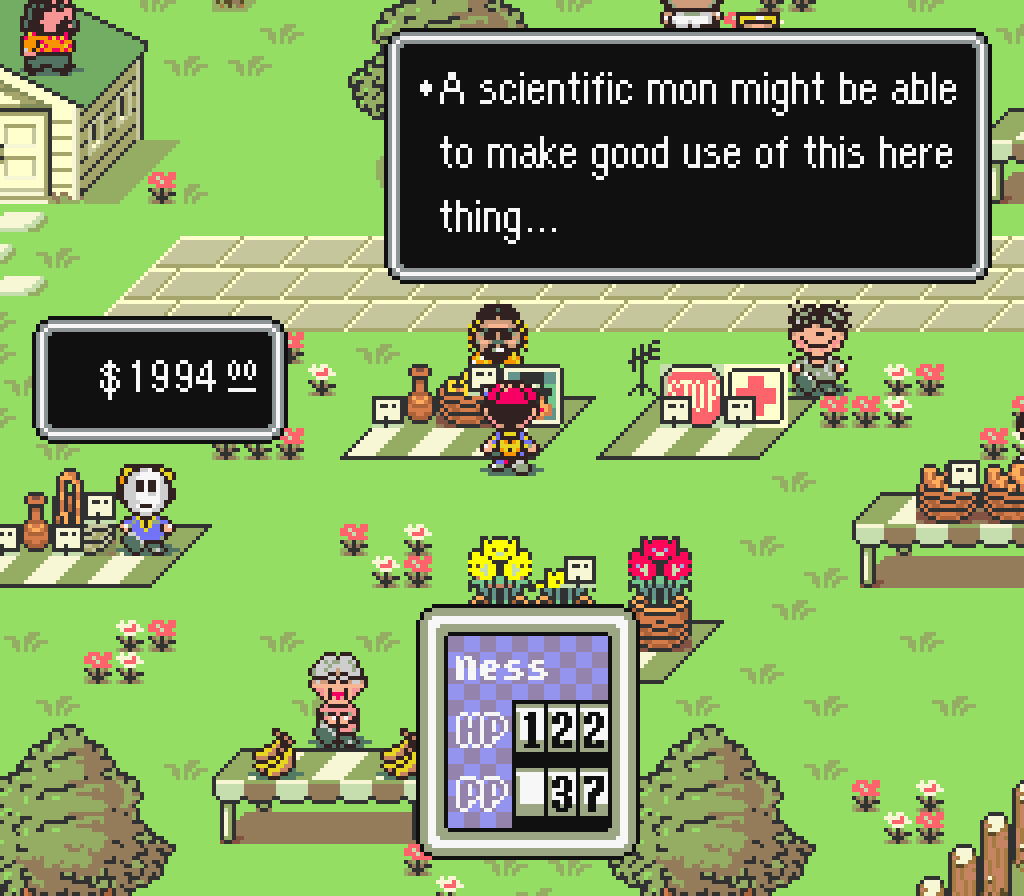
In the final version of the game, this vendor still sells junk, but as individual items that a future party member can repair. The weird thing is that you don’t actually meet this junk-fixing character until much later, in a different area of the game. Maybe this design change is why this vendor always felt strangely out of place to me.
Graveyard Goodies
In early versions of the game, you could check tombstones. Most of the time, nothing would happen if you checked one, but sometimes you’d find an item:
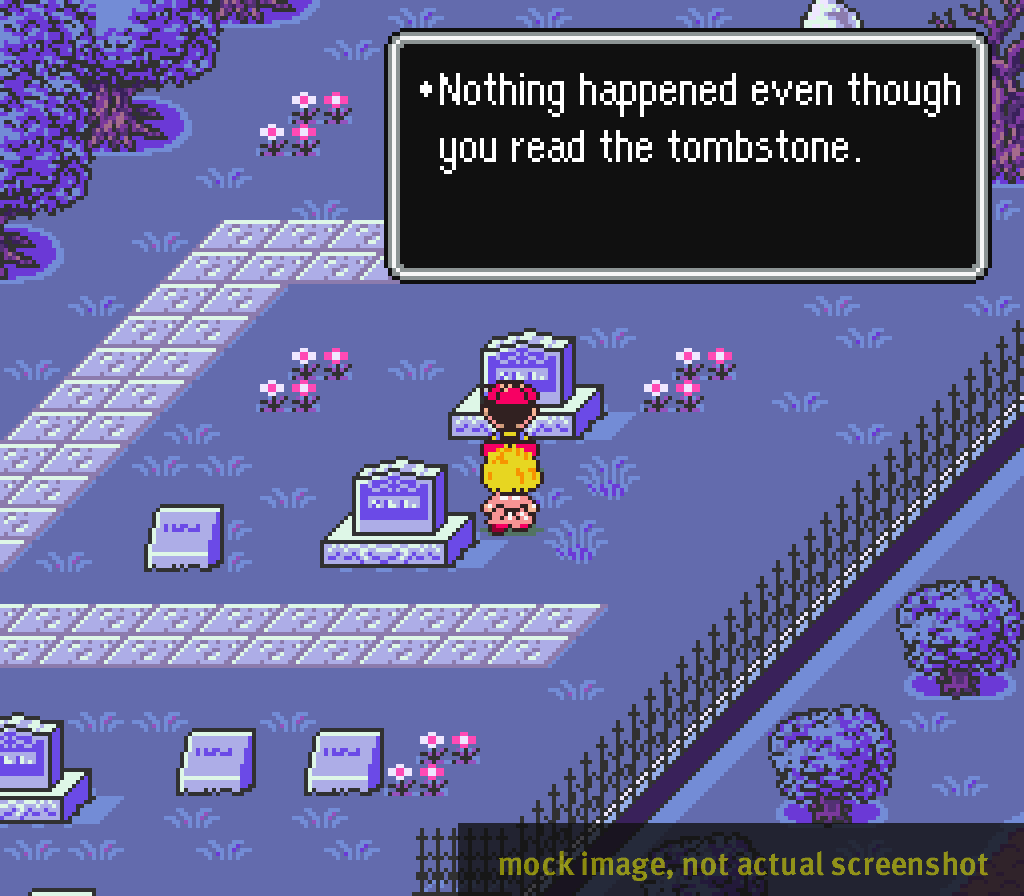
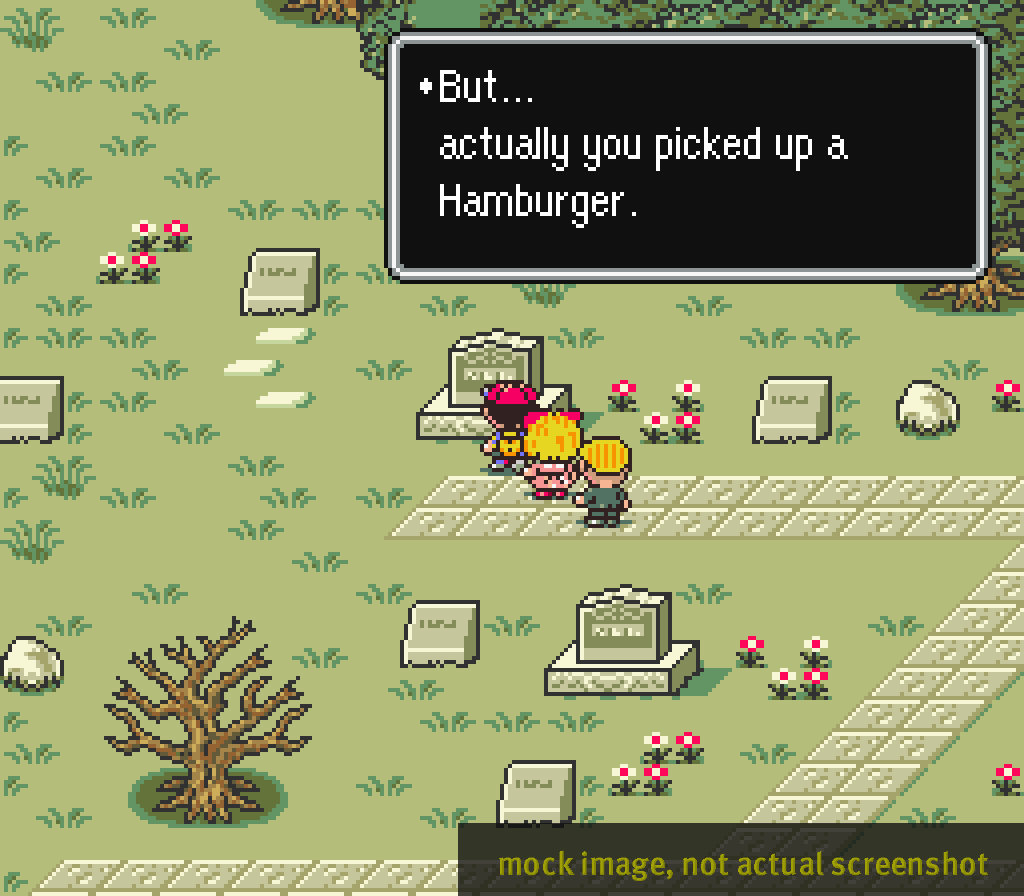
There are actually a few different tombstone-related lines, all of which were translated into English despite being old, unused text. Here’s the default line again:
| Japanese text | Official translation |
|---|---|
| ◆はかいしの もじをよんでも なにもない。 | ・Nothing happened even though you read the tombstone. |
And here’s the text when you would get an item from a tombstone:
| Japanese text | Official translation |
|---|---|
| ◆はかいしの もじをよんでも なにもない‥‥ ◆と おもったら ___を ひろった。 | ・Nothing happened even though you read the tombstone. ・At least that’s what I thought… ・But… actually you picked up a ___. |
But, if your inventory was full, it’d say this:
| Japanese text | Official translation |
|---|---|
| ◆しかし ざんねん。 にもつがいっぱいで もてない。 | ・How unfortunate! ・You can’t carry anything else because your back-pak is full. |
It sounds like there was one last line for the more curious players:
| Japanese text | Official translation |
|---|---|
| ◆はかいしの もじをよんでも なにもない。 ◆しかし むだなことでも してみるもんだ。 ‥‥ただ それだけ。 | ・Nothing happened even though you read the tombstone. ・But you might want to try doing useless things. ・…That’s all I wanna say. |
The second sentence in the translation above is actually a little off – it’s more like “doing pointless stuff (like this) sure can pay off”.
Summers Massage
In the final version of the game, a woman in Summers makes something called “Magic Cake”. As soon as you eat it, the screen start distorting, and you fall unconscious. You then have a vivid dream about a stranger named Poo in a distant land.
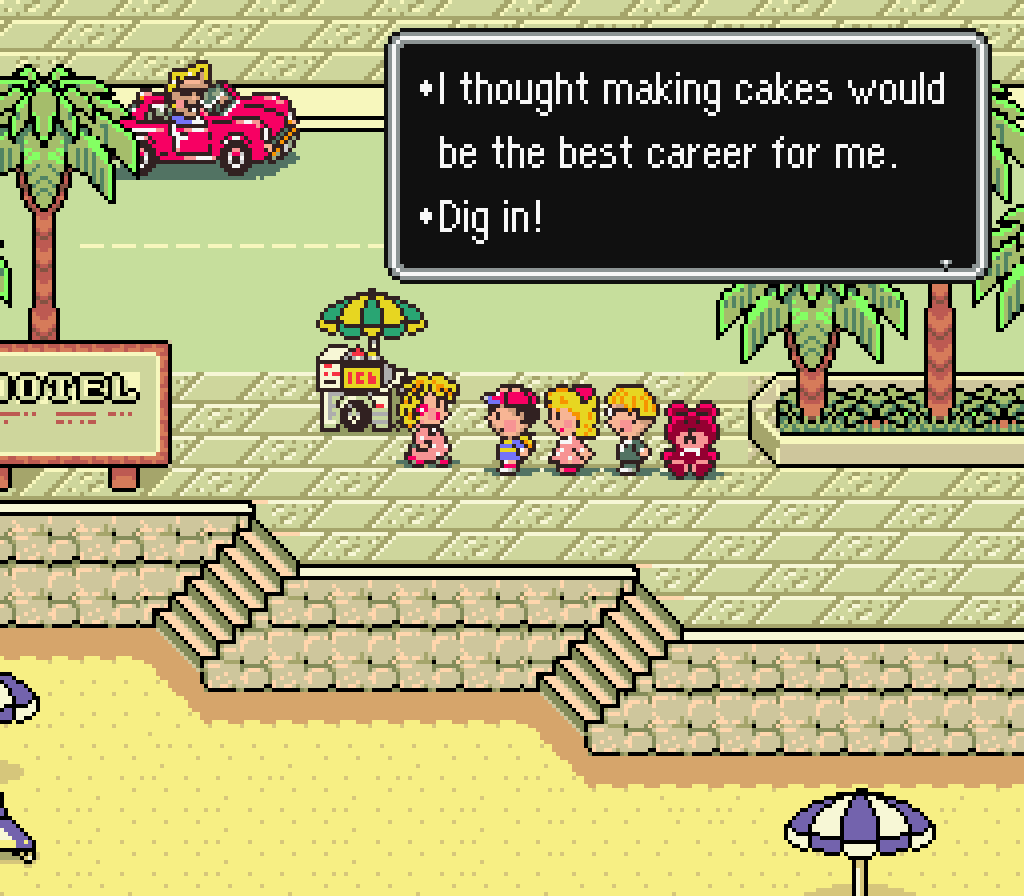

Naturally, fans love to make drug jokes about Magic Cake, but it turns out that Magic Cake wasn’t in the game originally. Instead, the woman was going to give you a special oil massage on the beach, during which you would fall asleep and have the crazy dream.
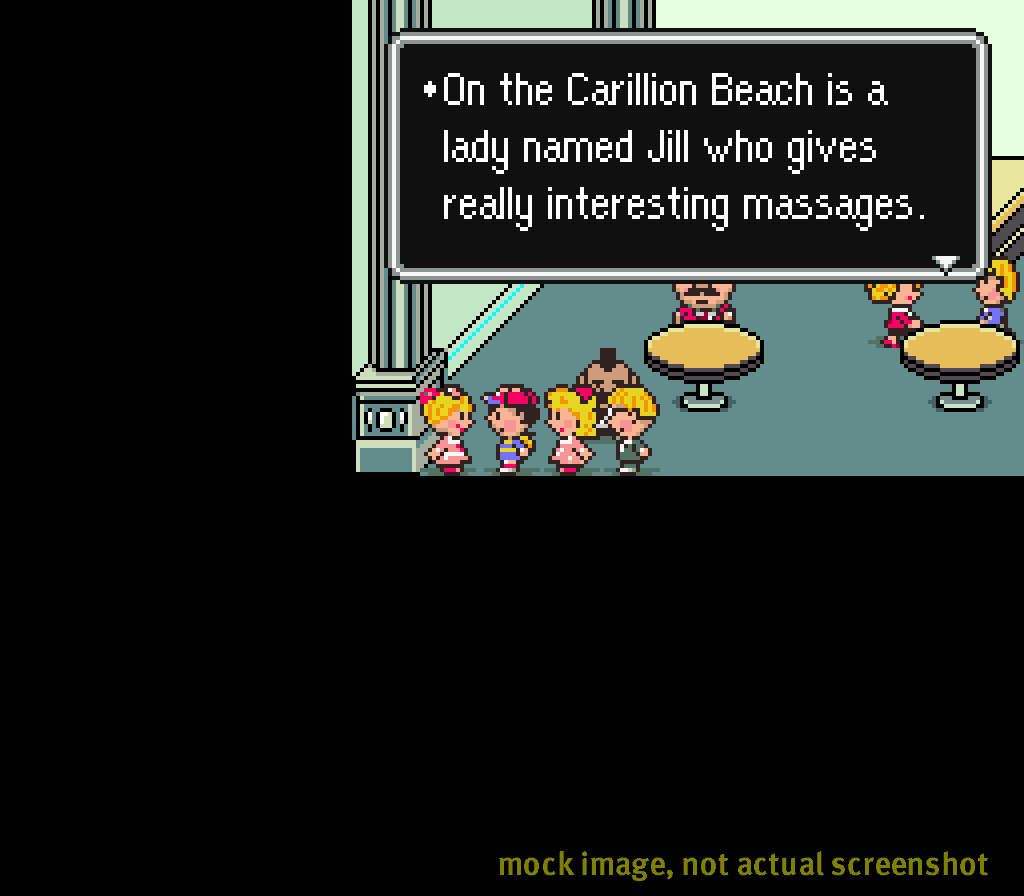
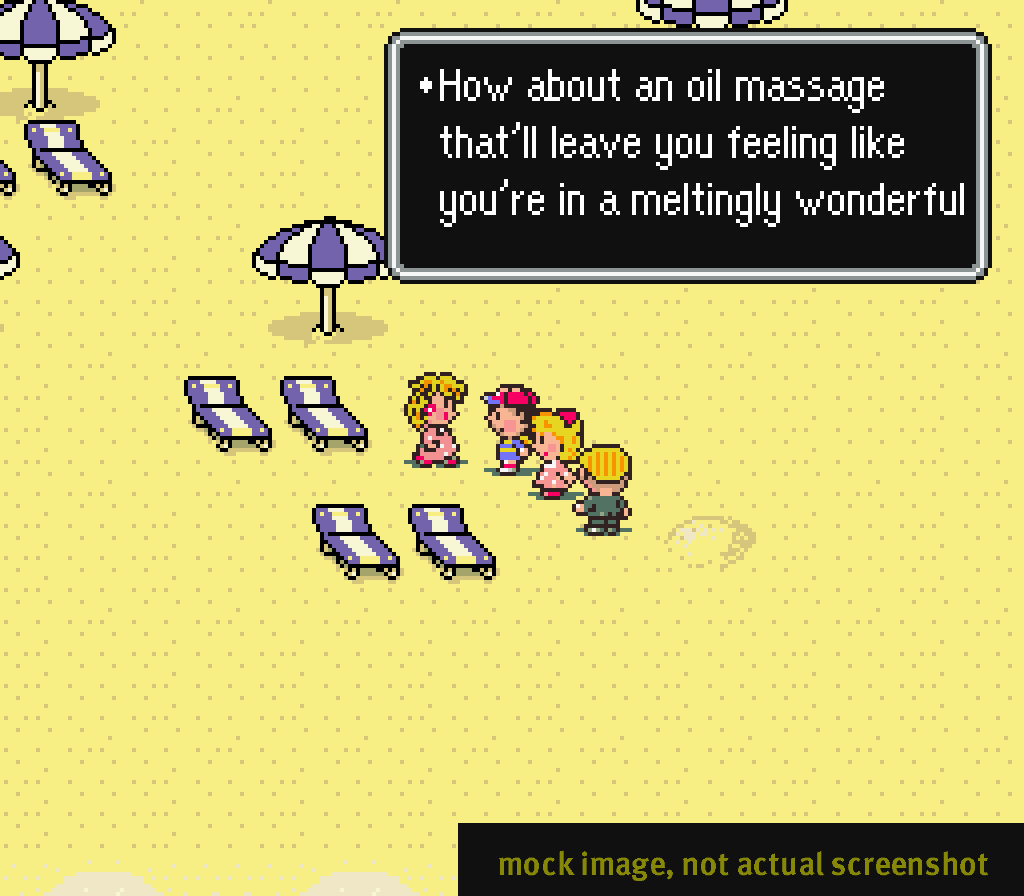
There’s a lot of information about this scattered across the development files, but here’s a summary of the most interesting stuff.
First, here’s an example line from a woman in the Stoic Club that seems to have been written early in the game’s development:
| Original Japanese text | English meaning |
|---|---|
| ◆カリヨンビーチにはねぇ キミ なかなかおもしろい マッサージをしてくれる ◆ジルって じょせいが いてね‥‥ ◆いいゆめを みせてくれるらしい。 いいゆめ‥‥だよ‥‥キミ。 すてきじゃないか‥‥ねぇ。 | ・On the Carillion Beach is a lady named Jill who gives really interesting massages. ・Apparently, they even make you have nice dreams. REALLY nice dreams, you know? Doesn’t that sound great? |
At some point after this line was written, Jill was renamed “Martha” in the development files, presumably as a play on the name マーサ (māsa, “Martha”) and the word マッサージ (massāji, “massage”).
| Original Japanese text | English meaning |
|---|---|
| ;オイルマッサージの女(マーサ) ◆とろけるような ゆめごこち。 オイルマッサージは いかが。 ◆ためしてみる? <はい> <いいえ> | ;Oil Massage Woman (Martha) ・How about an oil massage that will leave you feeling like you’re in a meltingly wonderful dream? ・Will you try it? Yes No |
| If you answer “yes” | |
| ◆じゃ こっちのひかげでね。 | ・Then come over here into the shade. |
| If you answer “no” | |
| ◆じゃ また こんどね。バーイ | ・Oh, some other time, then. Bye! |
A woman in the Summers drugstore also used to mention this massage stuff:
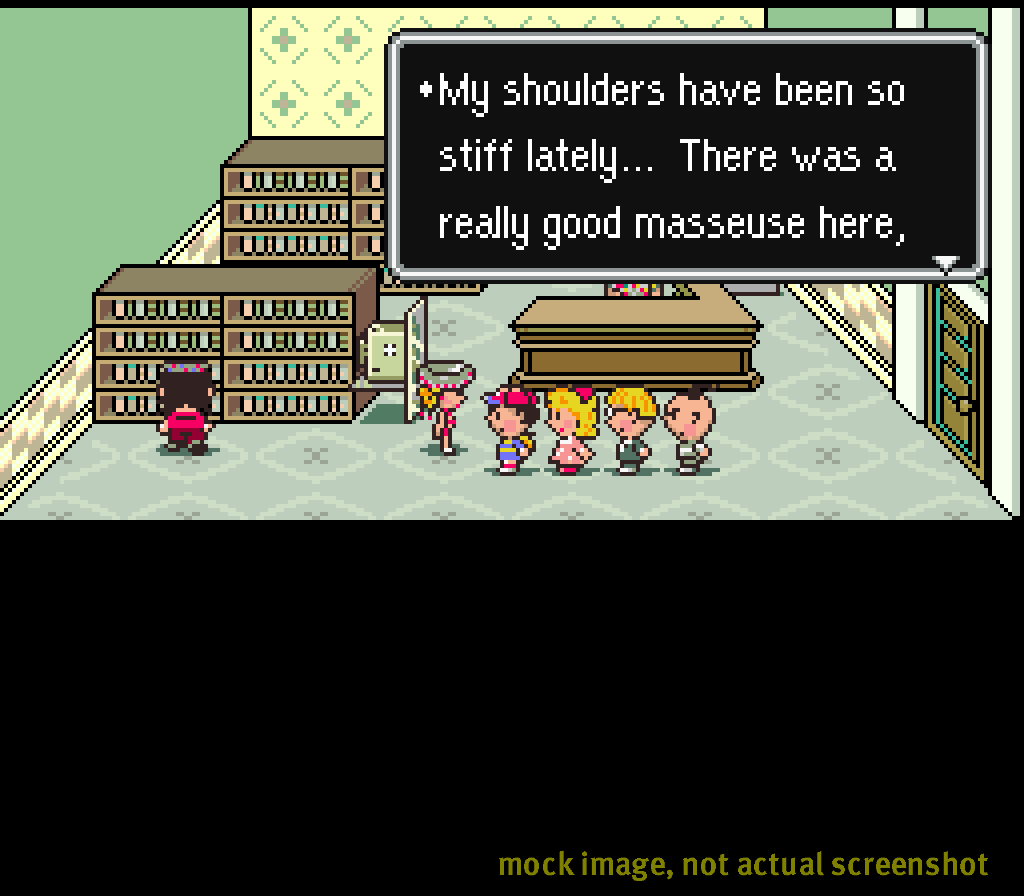
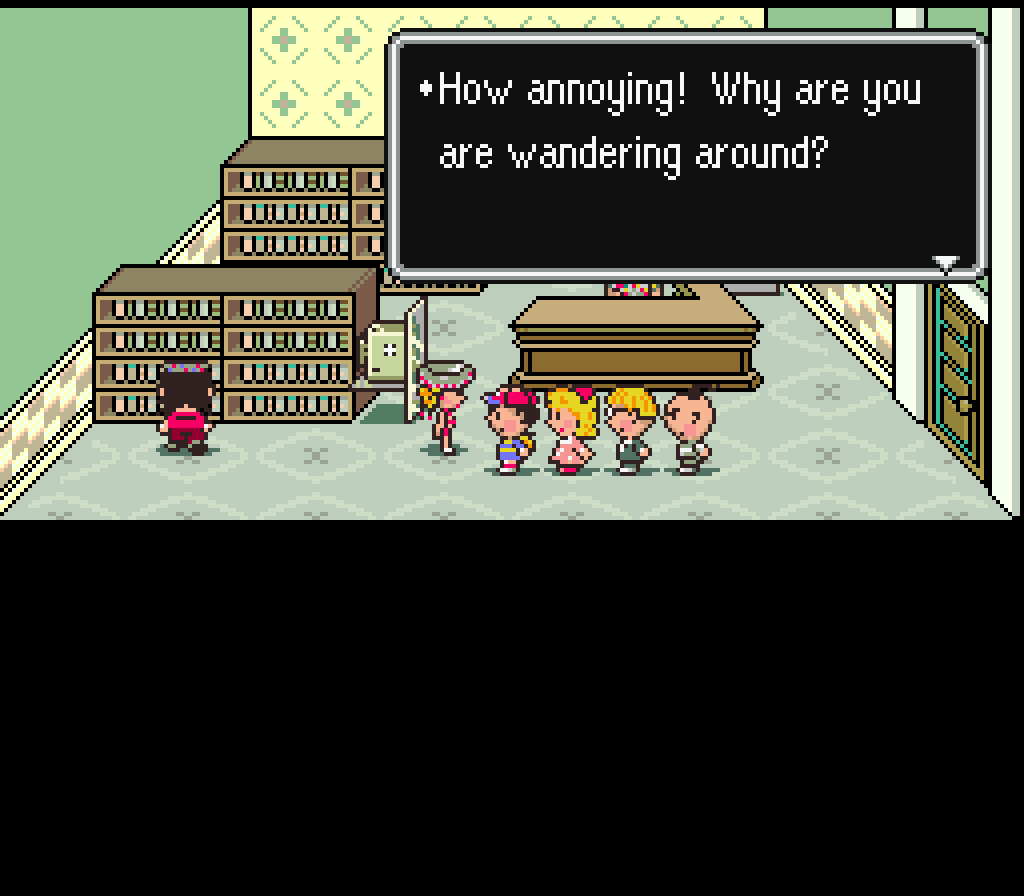
| Japanese text | English meaning |
|---|---|
| ◆ちかごろ かたがこって‥‥。 うでのいいマッサージしが いたんだけど みつからなくて。 | ・My shoulders have been so stiff lately… There was a really good masseuse here, but now I can’t find them. |
And a character in the hotel used to talk about massages too:
| Japanese text | English meaning |
|---|---|
| ◆ビーチにいた マッサージさん すっごく じょうずだったわ。 ゆめごこちよ。 | ・The masseuse on the beach was just wonderful. It felt like I was in a dream. |
At some point in time, the developers changed things around and made Martha offer Magic Cake instead of a massage. But even though they changed her character, a separate pre-final line suggests she was still located on the beach:
| Original Japanese text | English meaning |
|---|---|
| ◆マジックケーキうり が はまべに いるらしいよ。 ◆おじさんも しごとさえなけりゃ たべにいくのになあ。 | ・Apparently there someone selling Magic Cake on the beach. ・I’d go and have some, if I didn’t have work to do. |
For the final release, however, the woman was moved to the city’s sidewalk.
As we can see, this character underwent many changes during development. In fact, the above line was replaced with the final line on a date marked “7/18”. If this is referring July 18, 1994, then this Martha character was still being changed up until weeks before the game’s release!
On a side note, even though this woman’s name never appears named in the actual game, the official Japanese guide refers to her as “Jill”. This suggests that either the guide writers didn’t get informed about her new “Martha” name, or her name was changed back to “Jill” before the game’s release. The former seems more likely to me.
Things about Poo
During the game’s development, many changes were made involving Poo, the fourth party member. Here are some highlights:
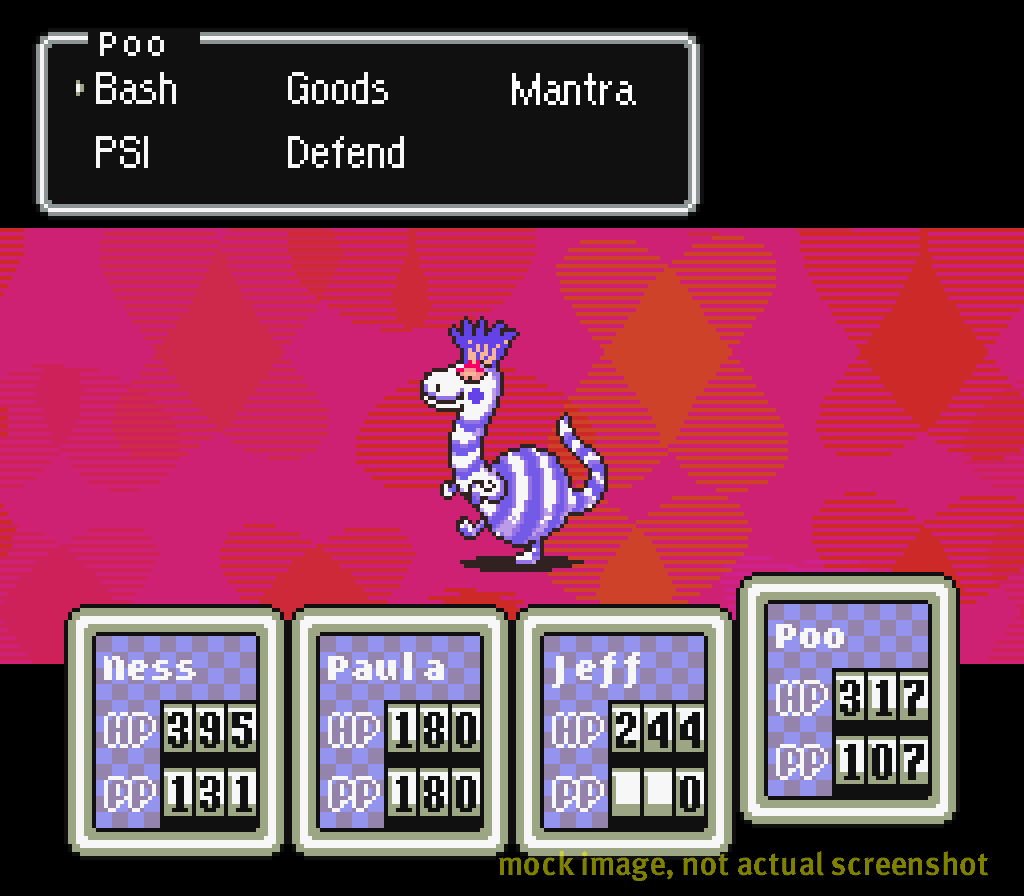
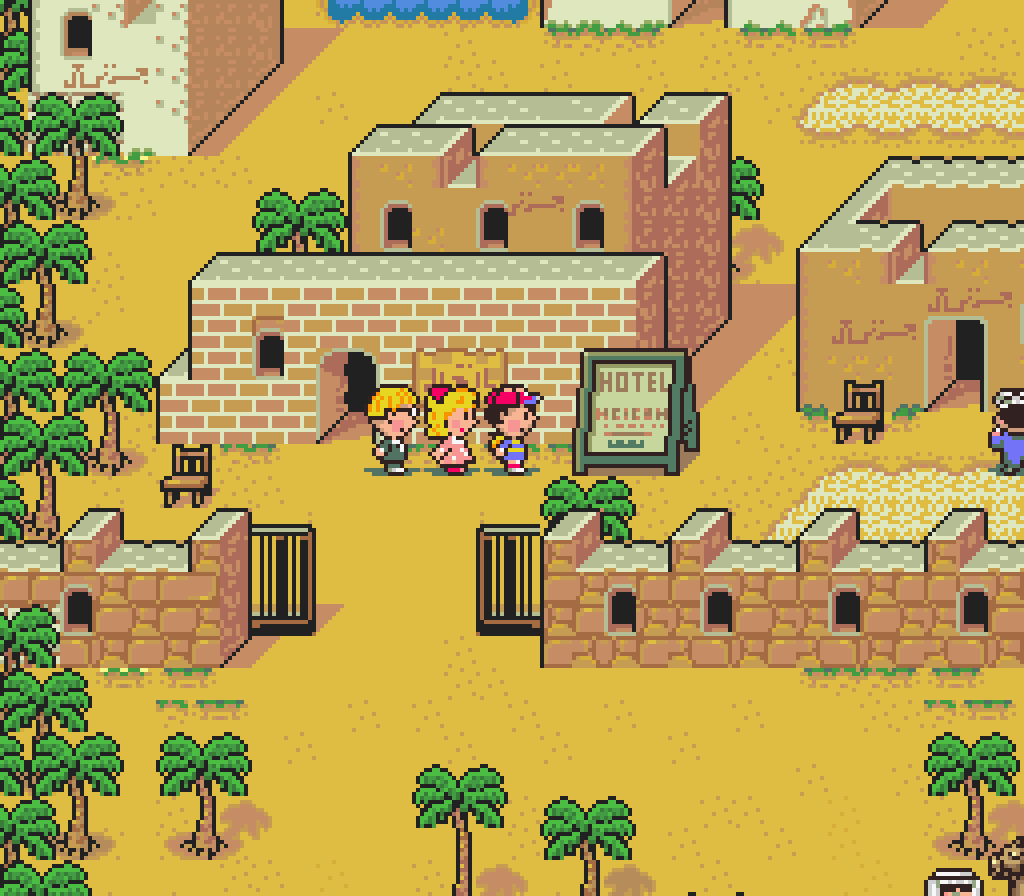

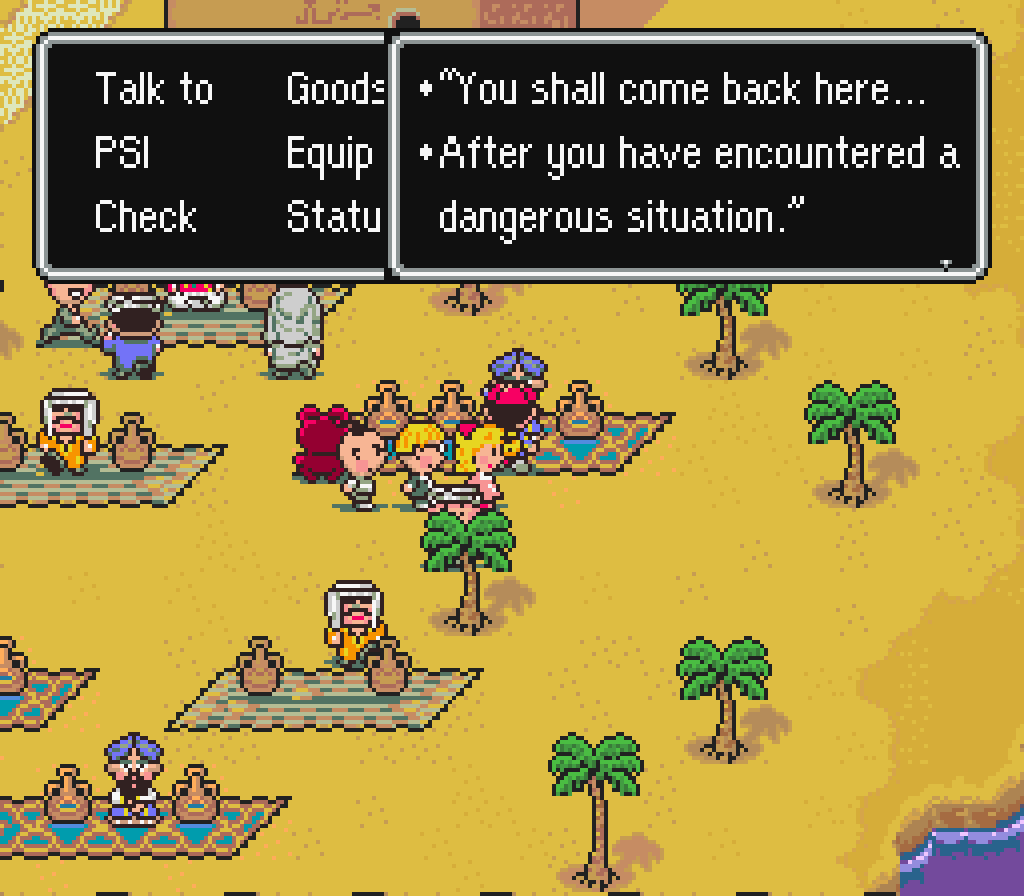
Also, Poo originally used the Japanese pronoun oira, which came as a surprise to me. In the final version, he instead uses the more fitting ore pronoun.
Unused Scene Animations
The developer/translator data files also suggested that certain story scenes had extra bits that were cut for the final release. Using these clues, fellow EarthBound ROM hackers were able to locate the unused content and reactivate it.
There were several of these discoveries – below are two of the more interesting ones.
After the Zombie Attack
In the final version of the game, Ness and Paula get caught by a zombie lady’s minions. The screen fades to darkness, and then the two characters wake up in a cave beneath a graveyard.
It turns out there was originally a short scene that bridged these two events. In it, the zombie lady can be seen directing her minions as they drag Ness and Paula to their underground prison:
All the data for this zombie scene still exists in the final Japanese and English releases – only the scripting code intended to activate it was commented out.
After the Gold Mine
A similar short animation was removed in the Dusty Dunes Desert section of the game. In the final version of the game, you’re tasked with clearing out a monster-infested gold mine. The miner is grateful afterward, but remains where he stands.
Originally, the miner was supposed to thank you, drive his vehicle off the screen, and then enter the gold mine to continue his work. This animation was cut from the final release, but still exists in the game data:
In the final release, this vehicle never moves. But in a rare 1992 preview video, we can see that it did move at some point:
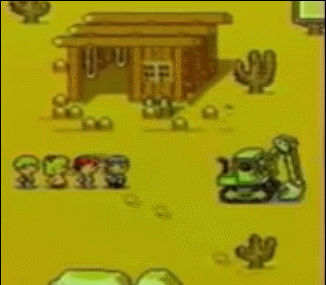
The scene in this preview clip is a little different from what was uncovered in the final game’s data, so it looks like we might have two separate snapshots of this unused scene now.
Character Names Revealed
According to the developers’ data files, many of the unnamed characters in MOTHER 2/EarthBound actually have names. Some of these names did get listed in official Japanese guides, but most of these have never revealed before:
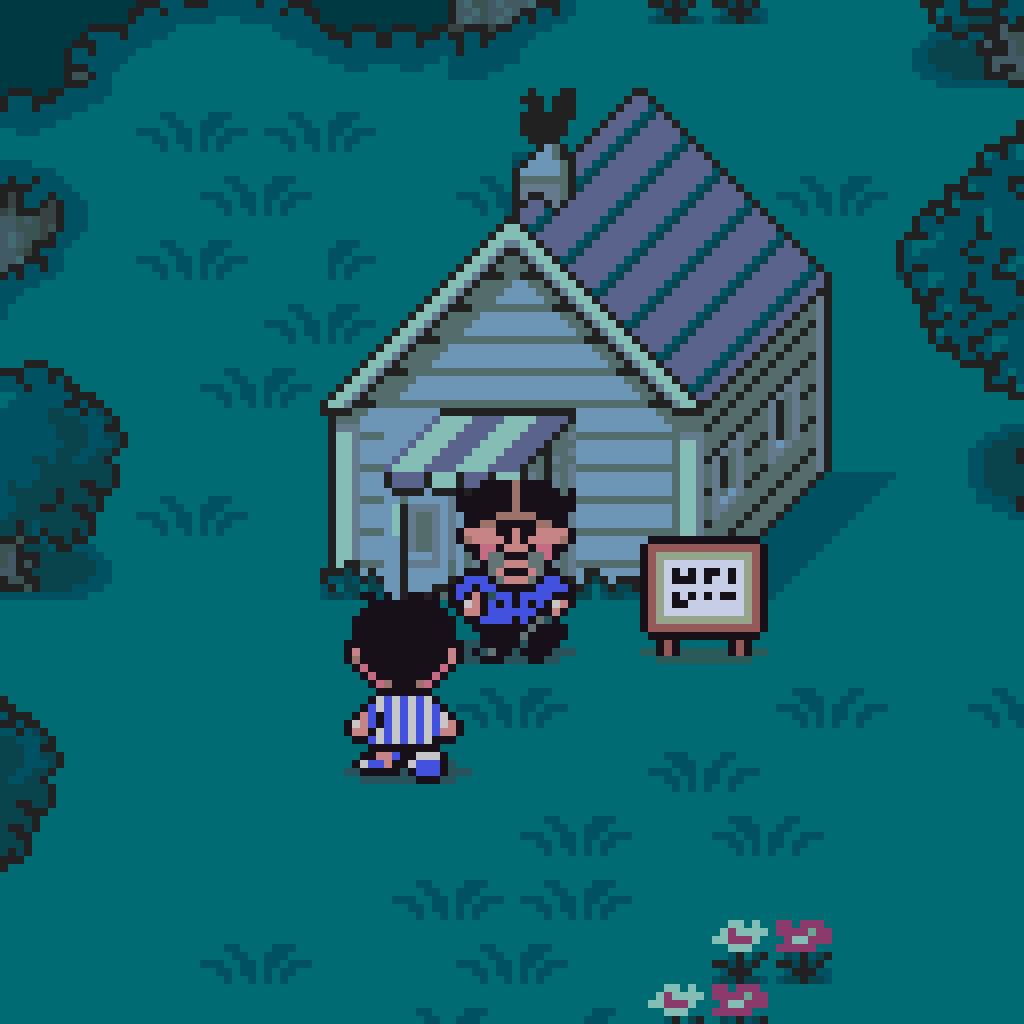
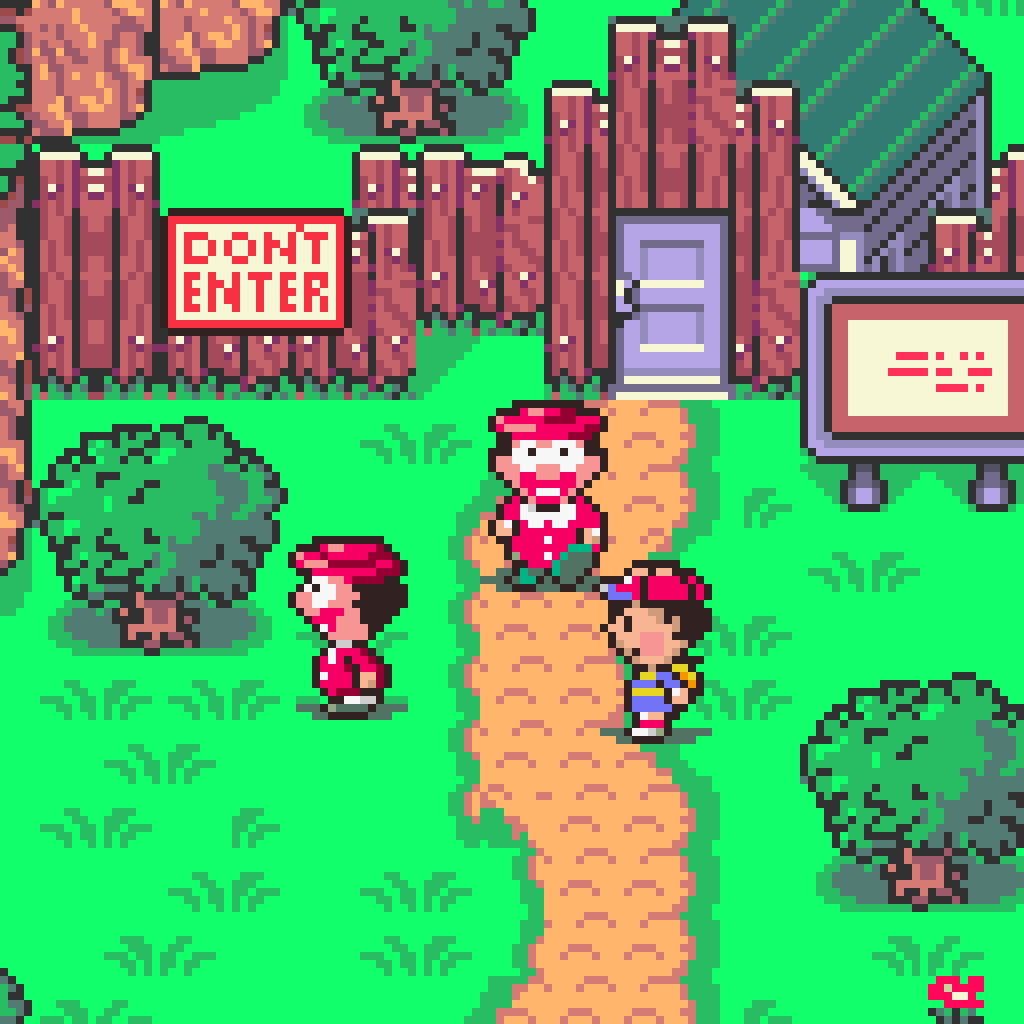
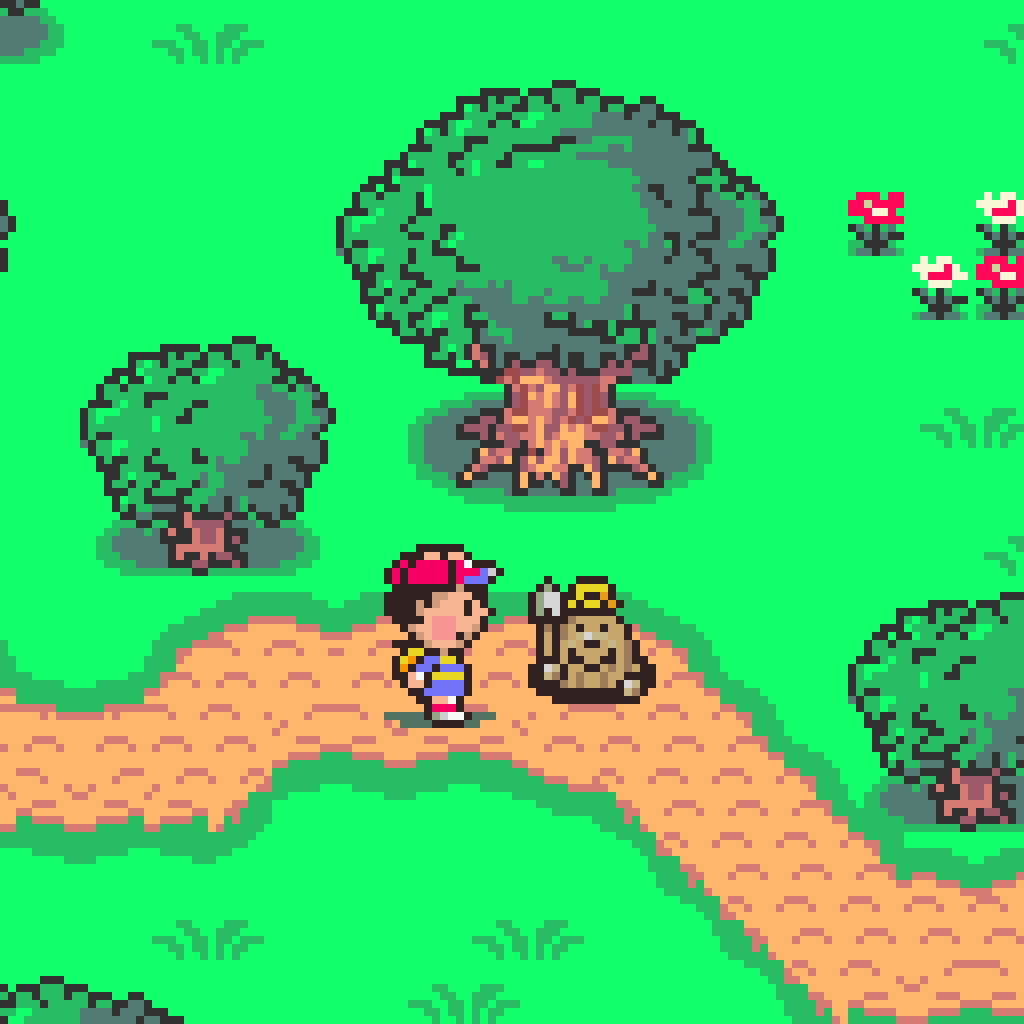
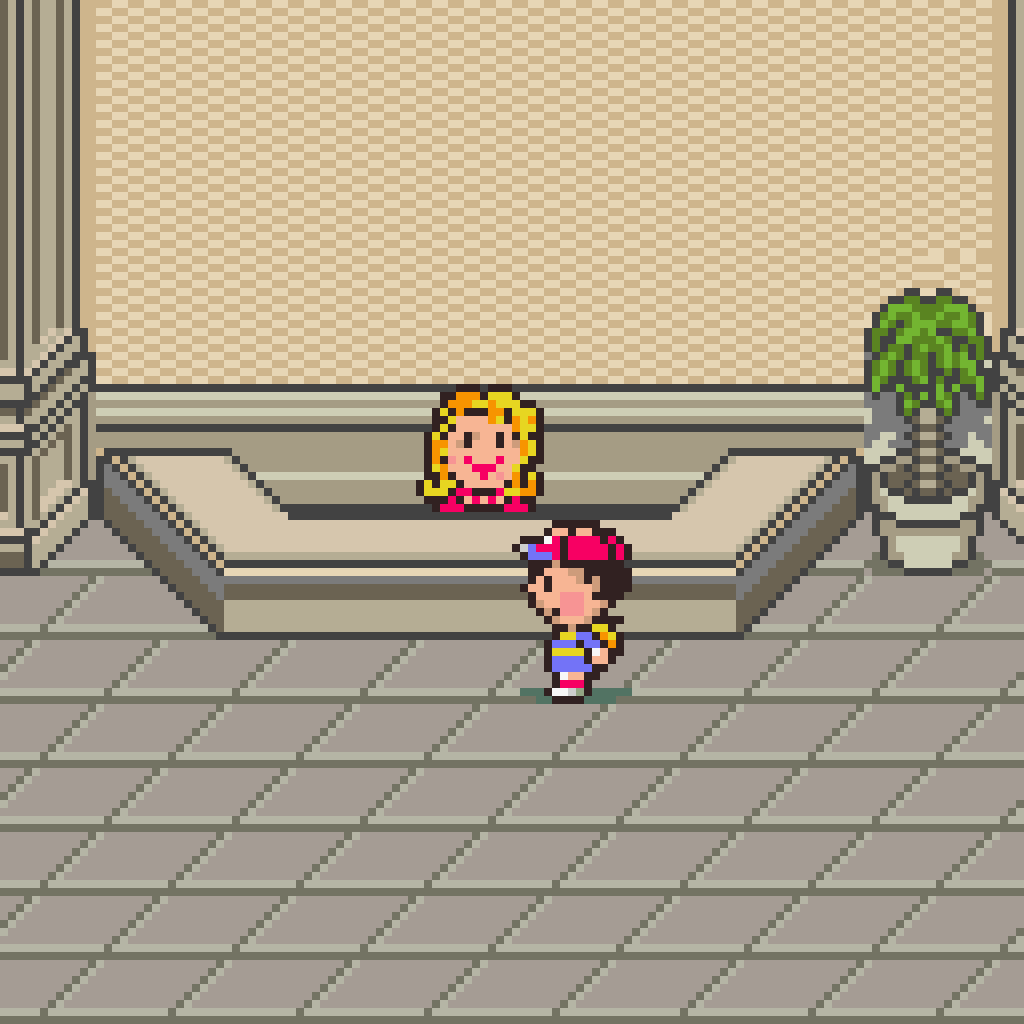
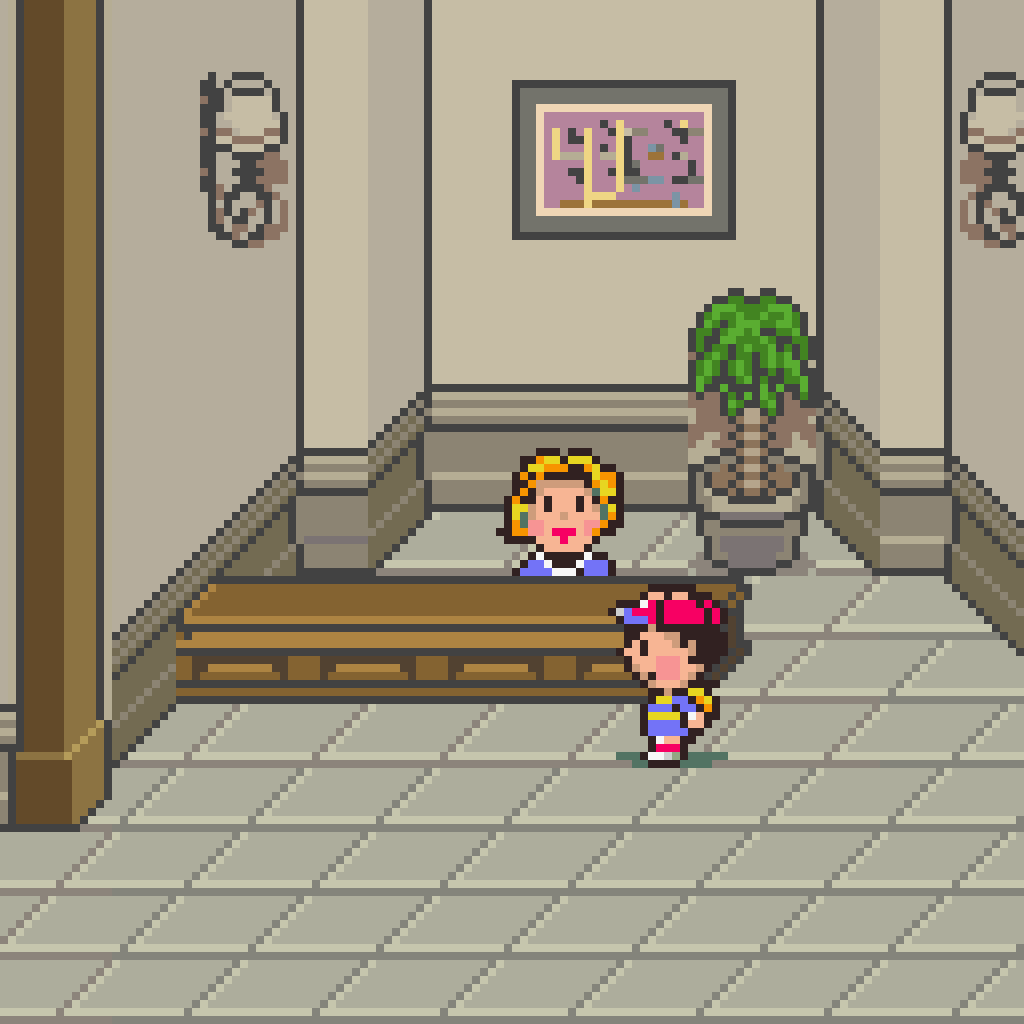
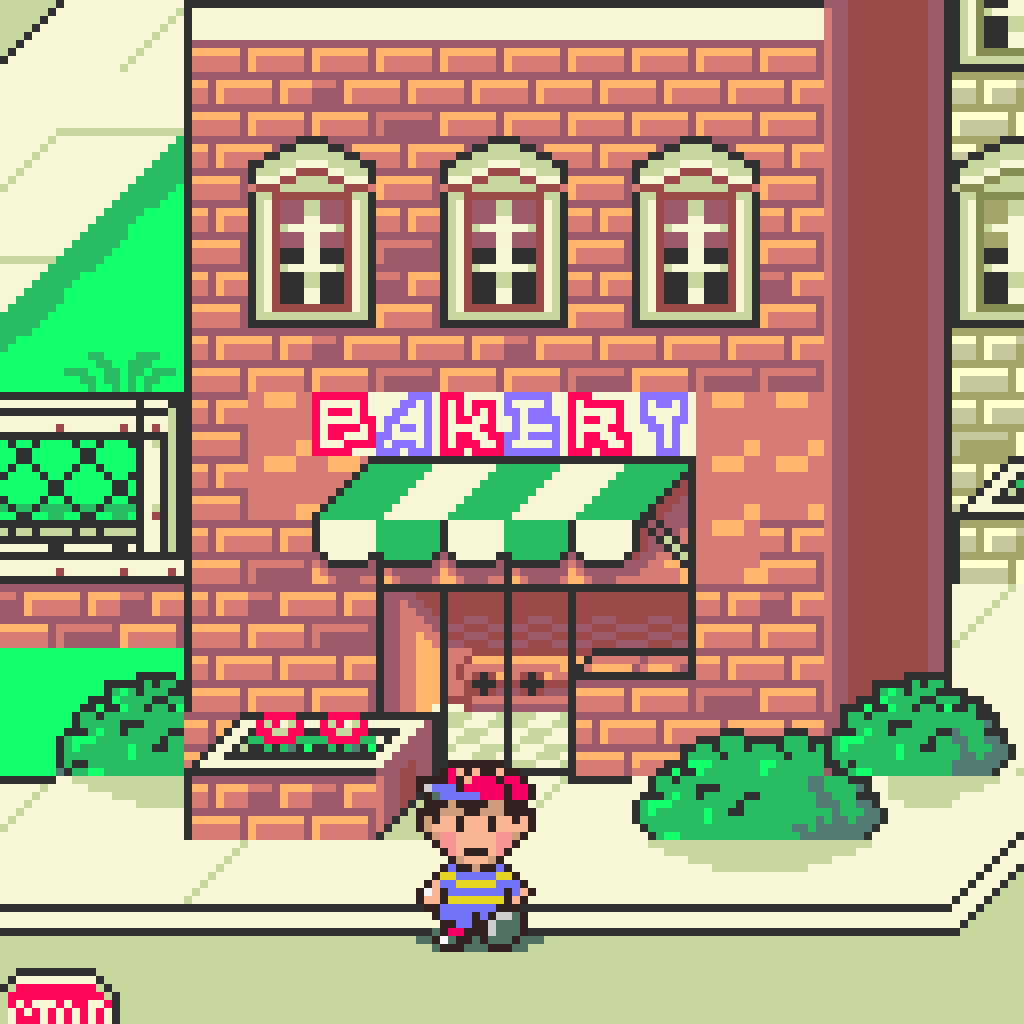
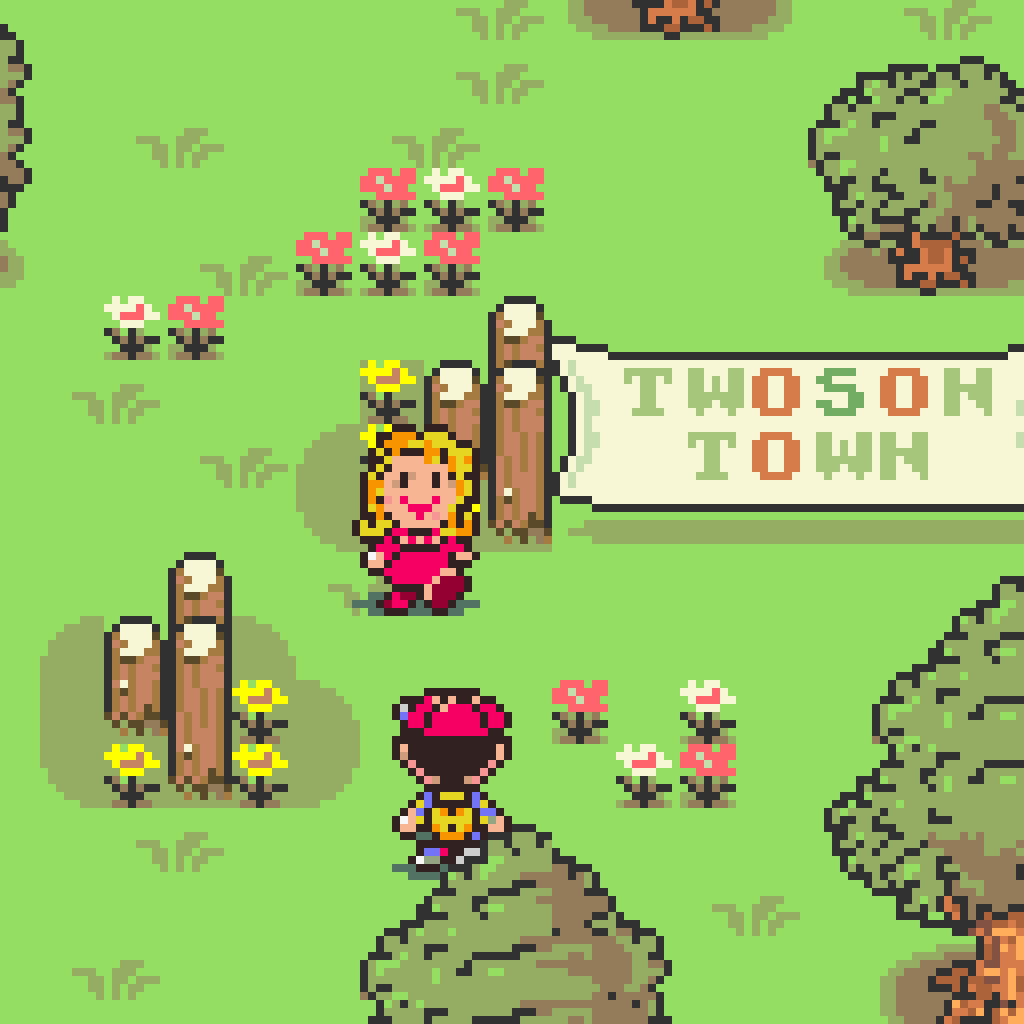
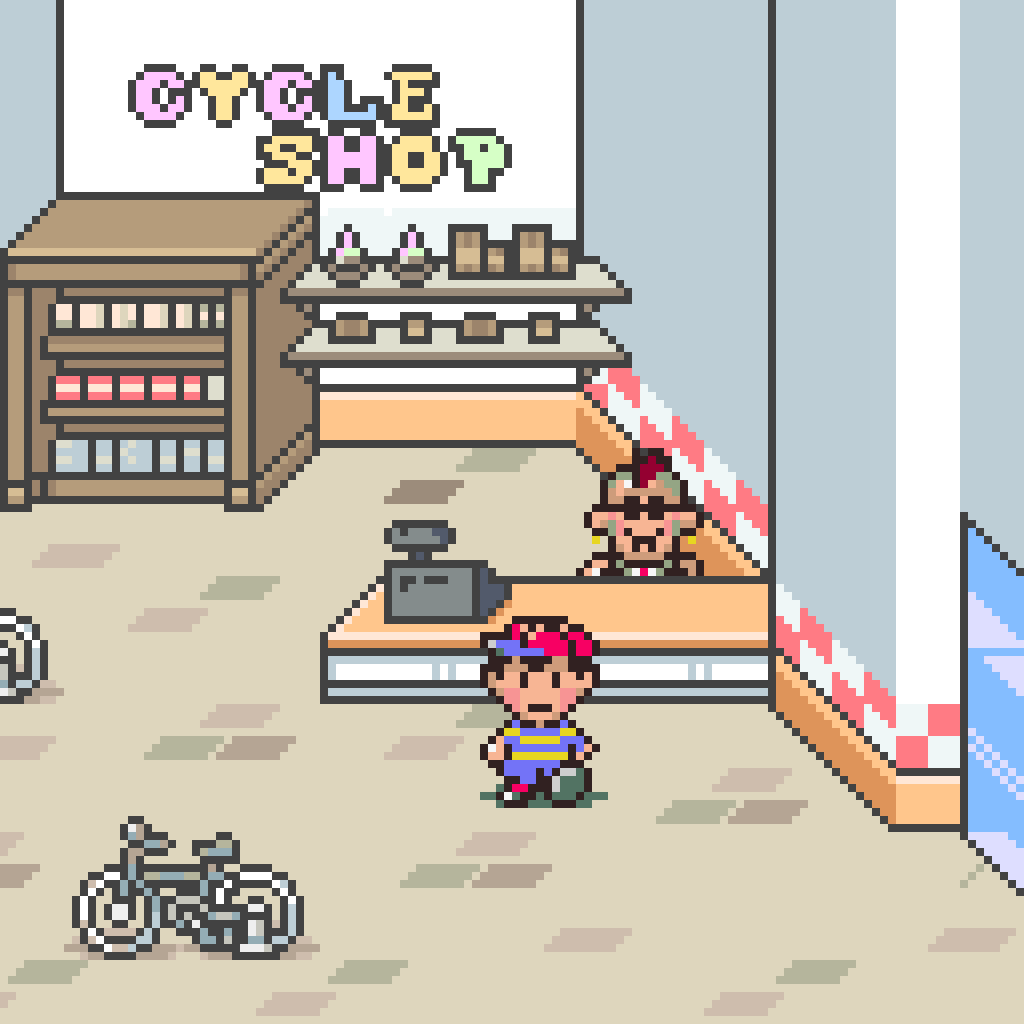
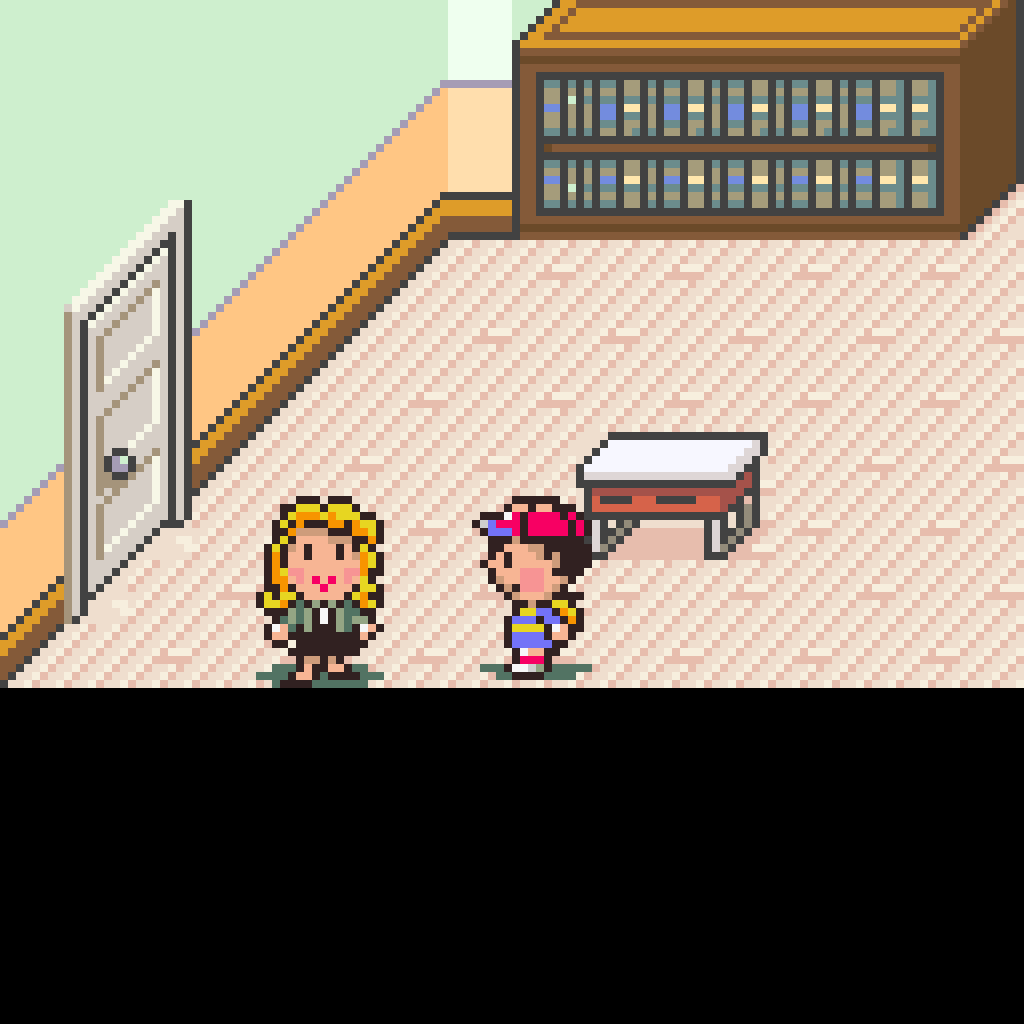
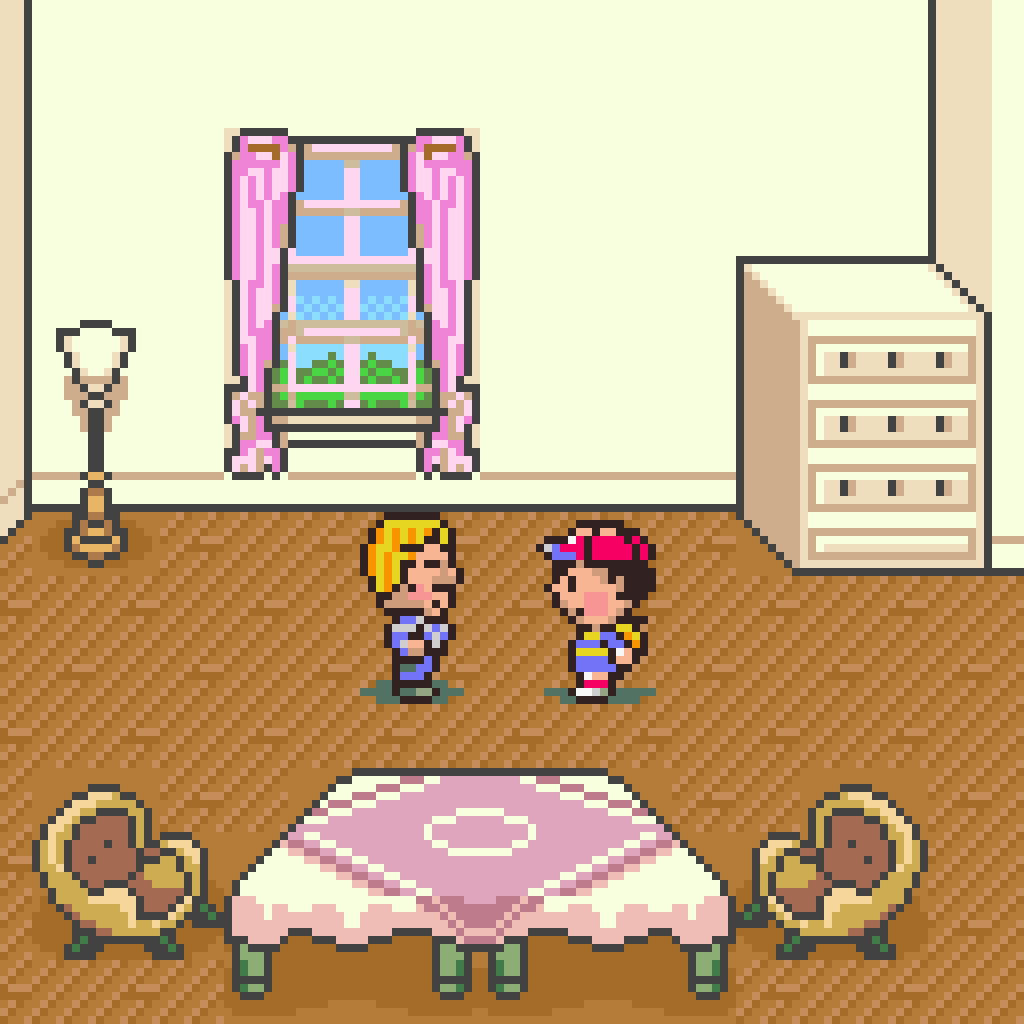
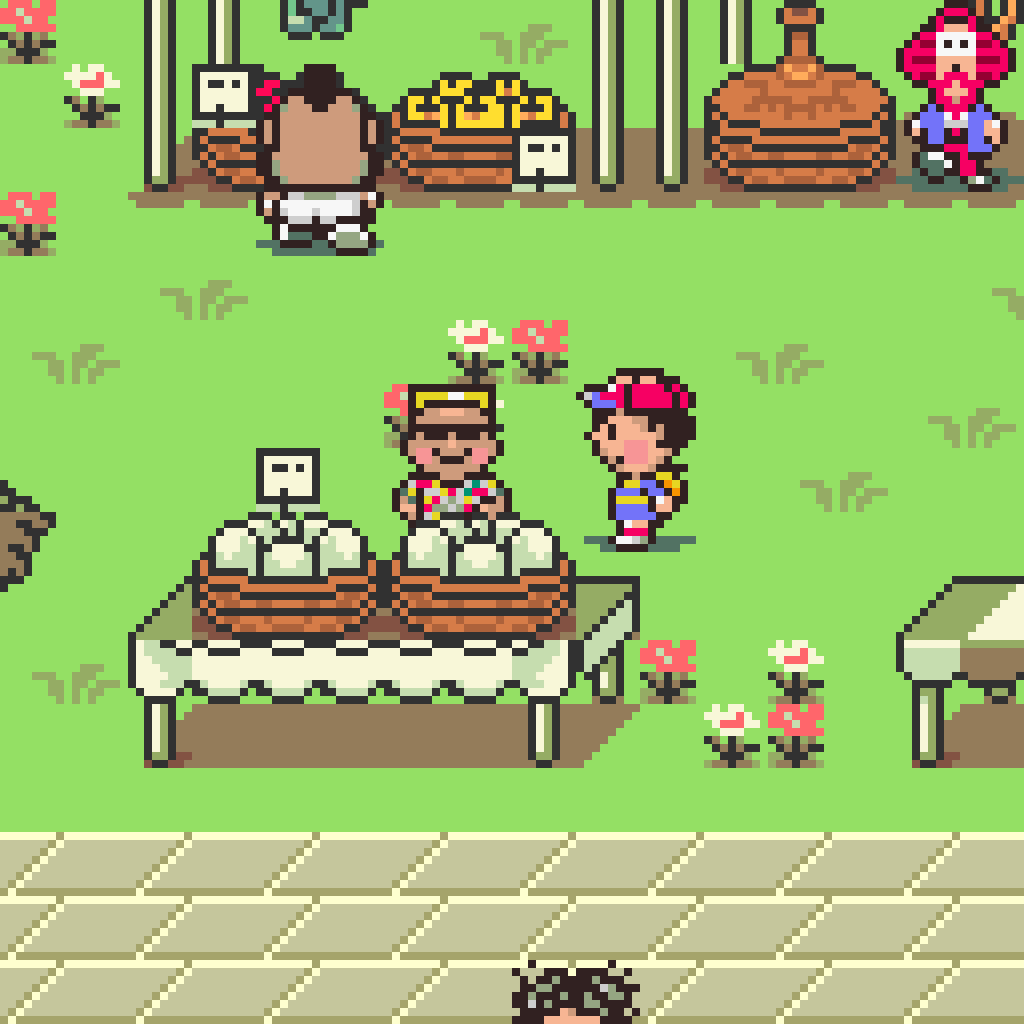
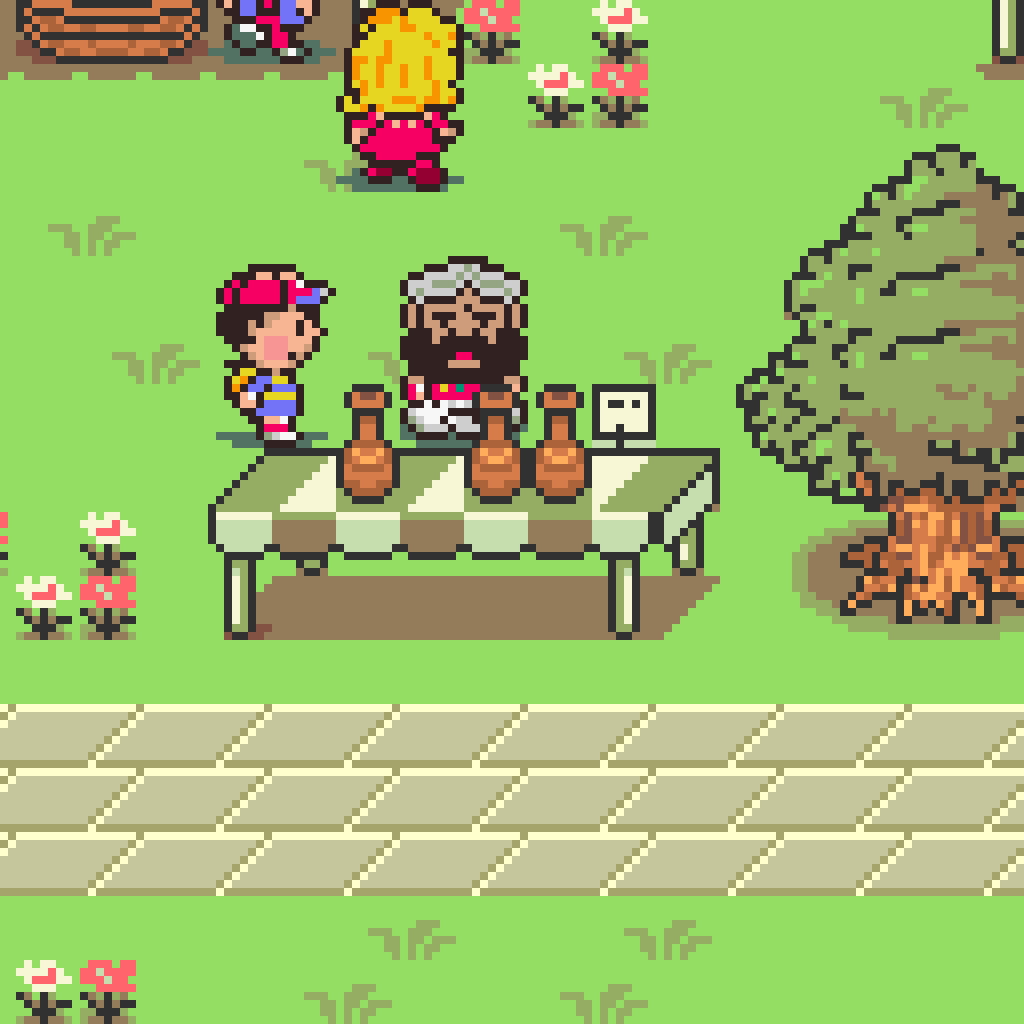
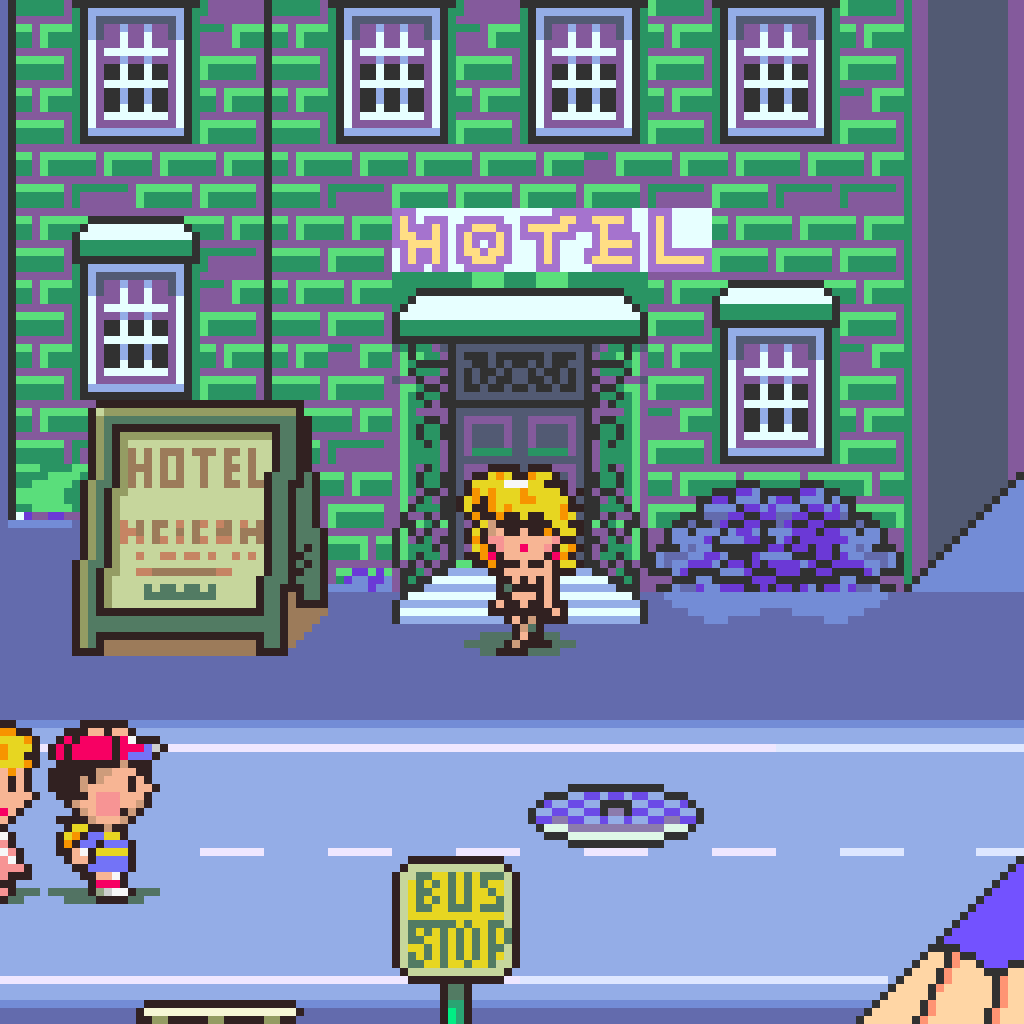
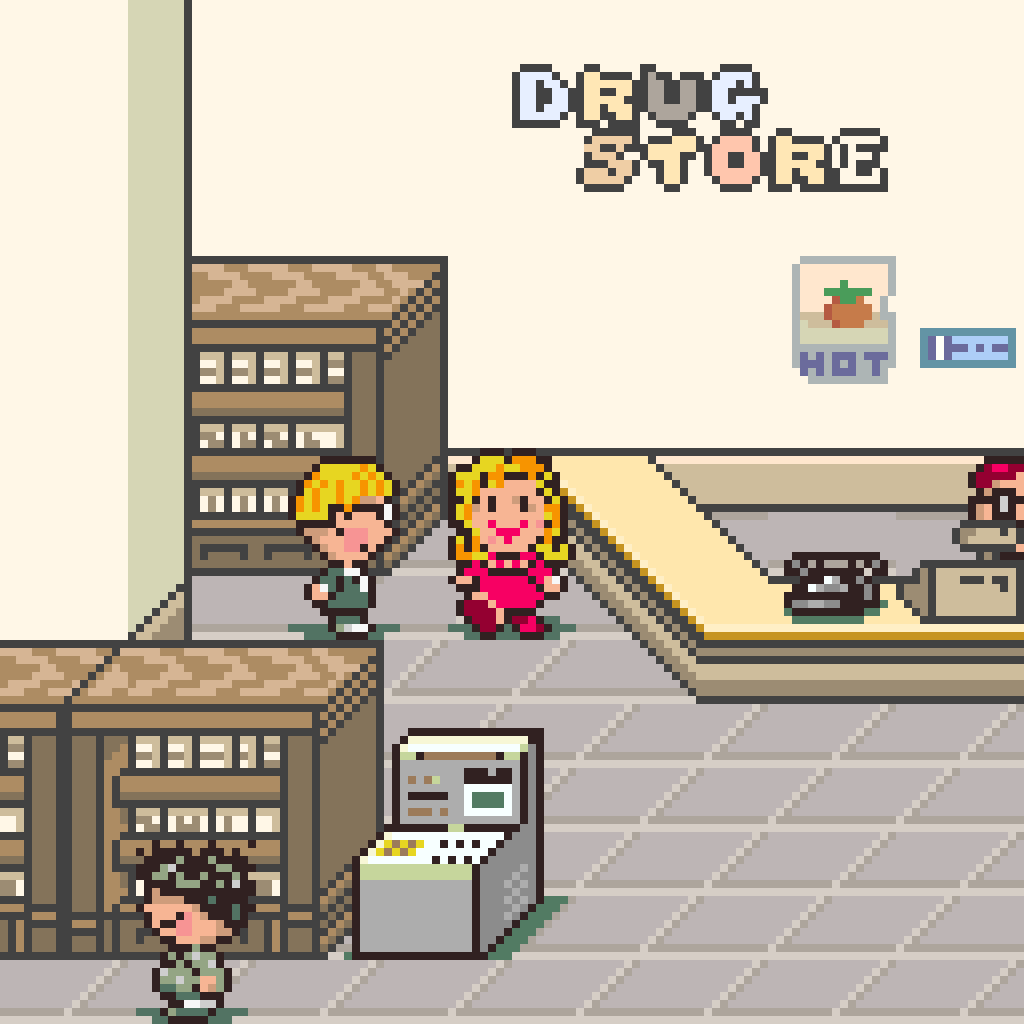
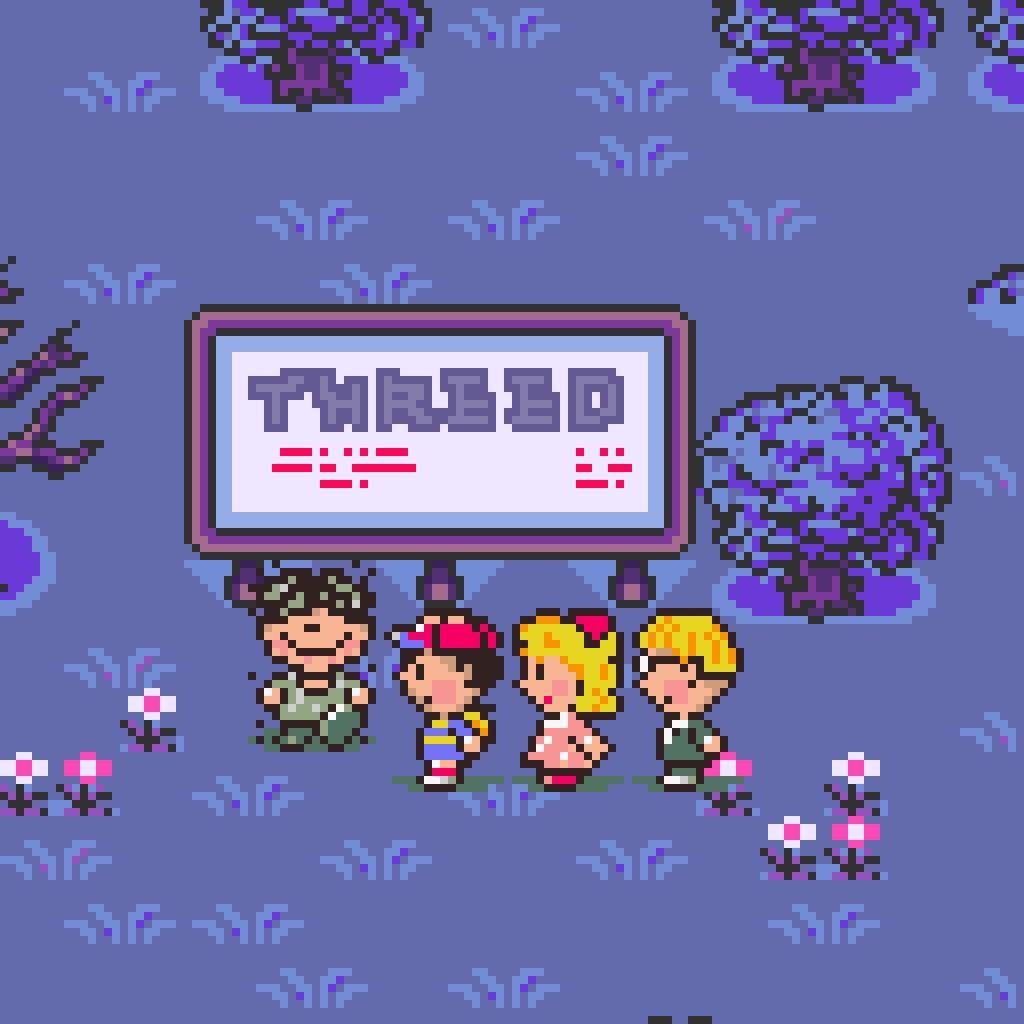
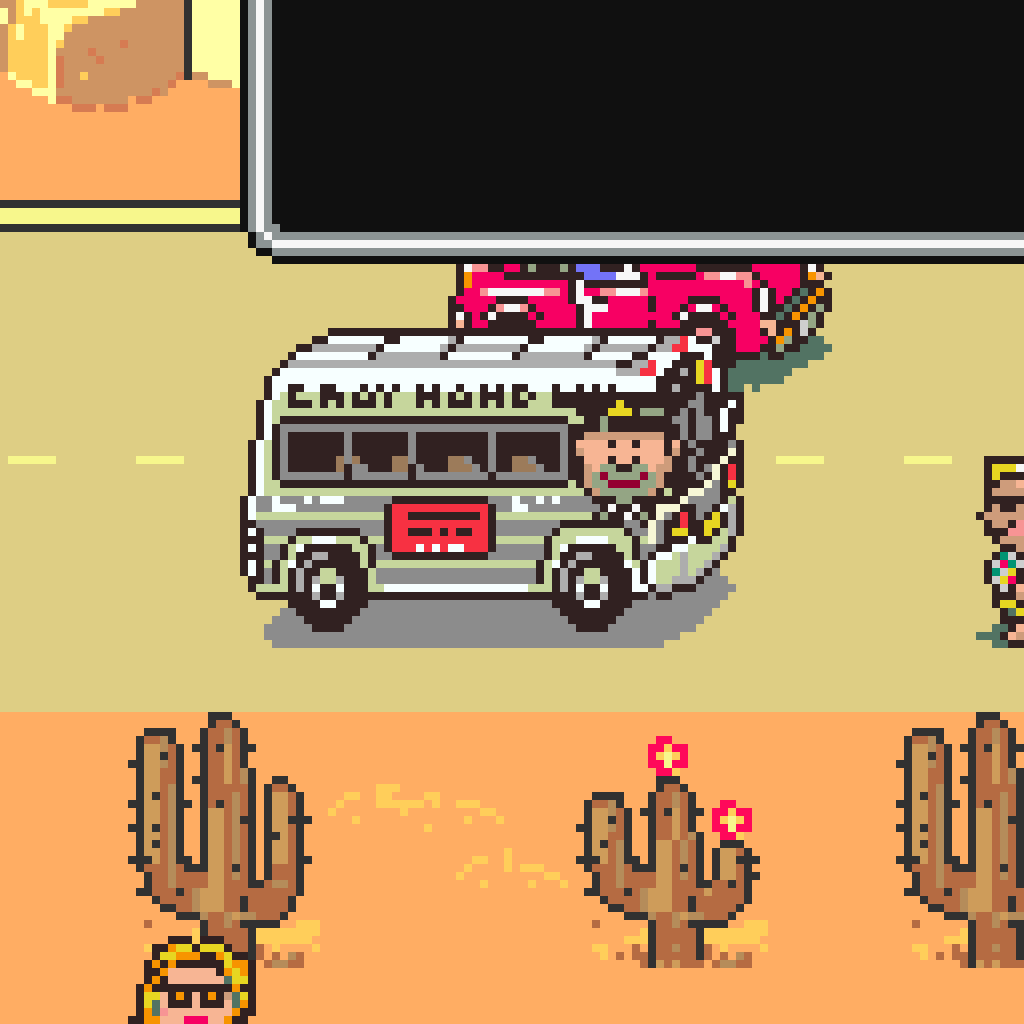
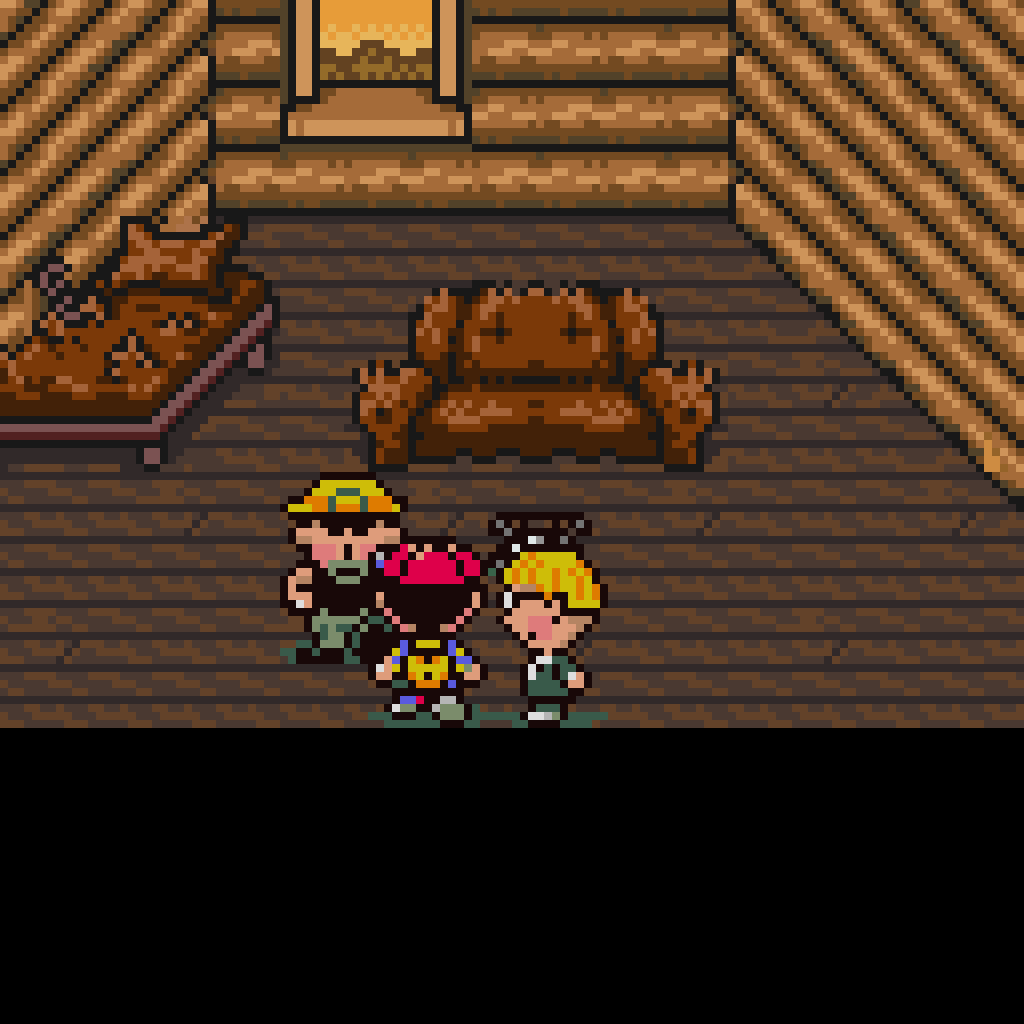

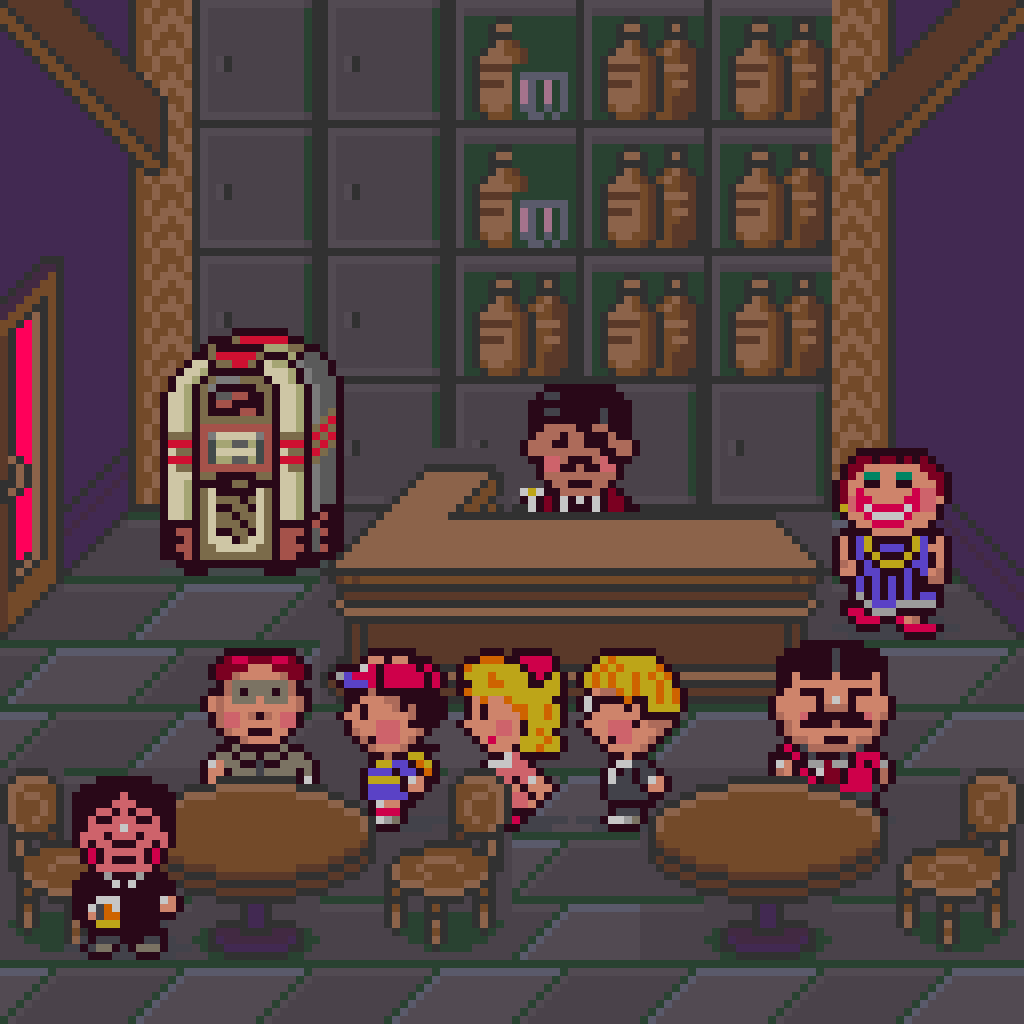
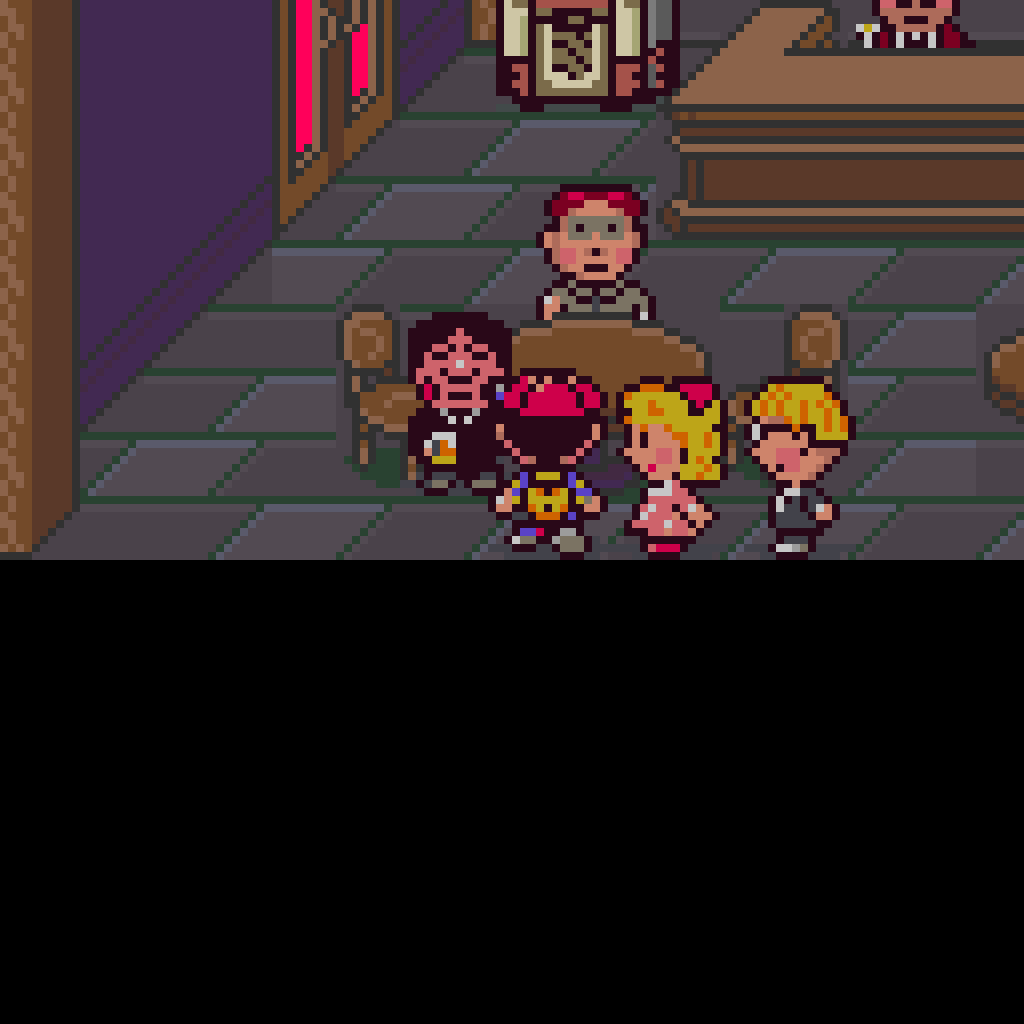
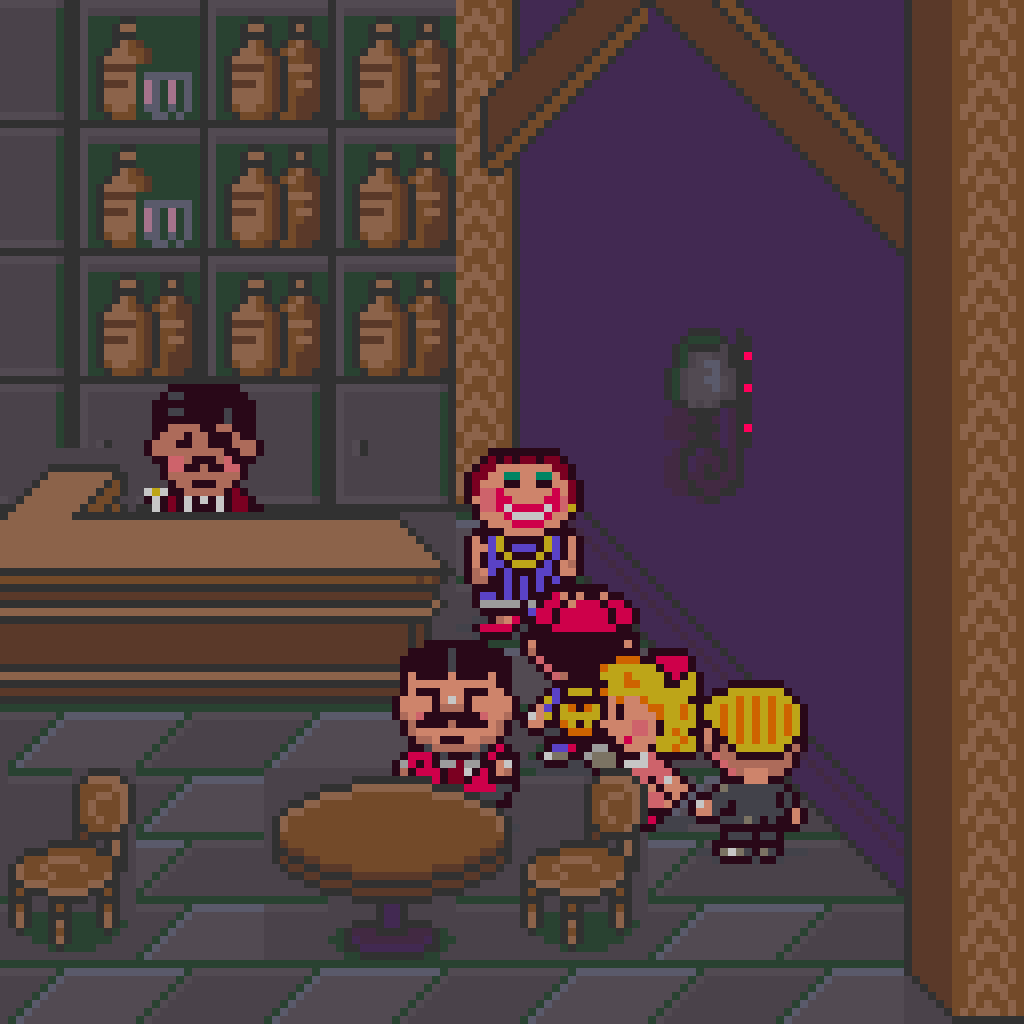
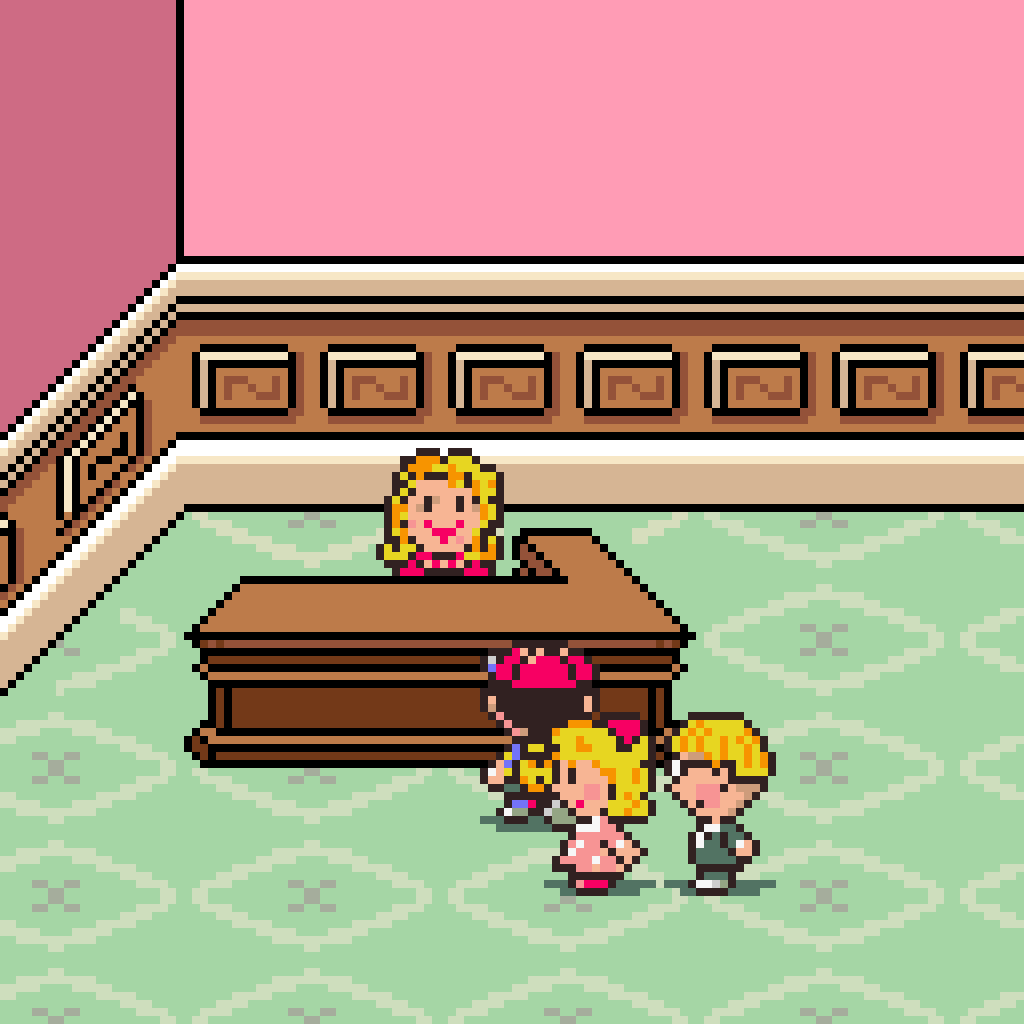
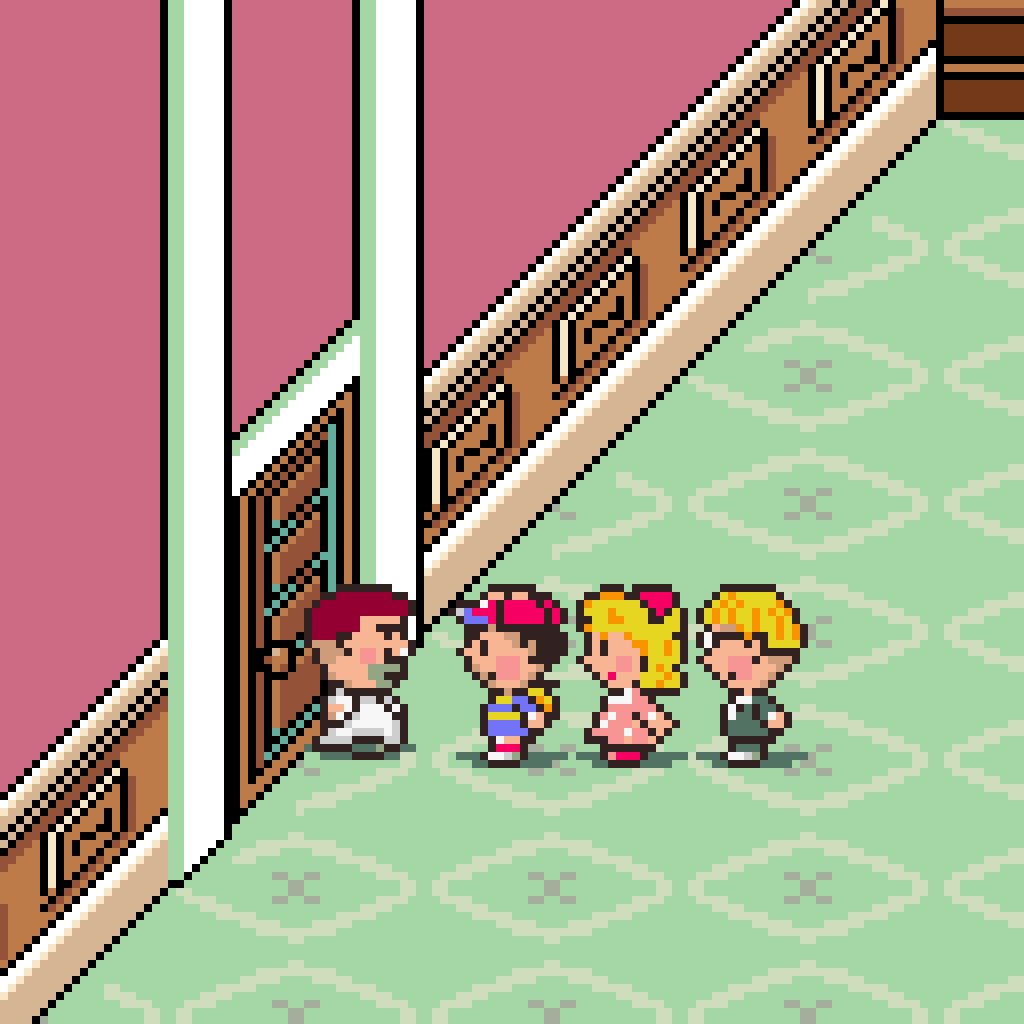
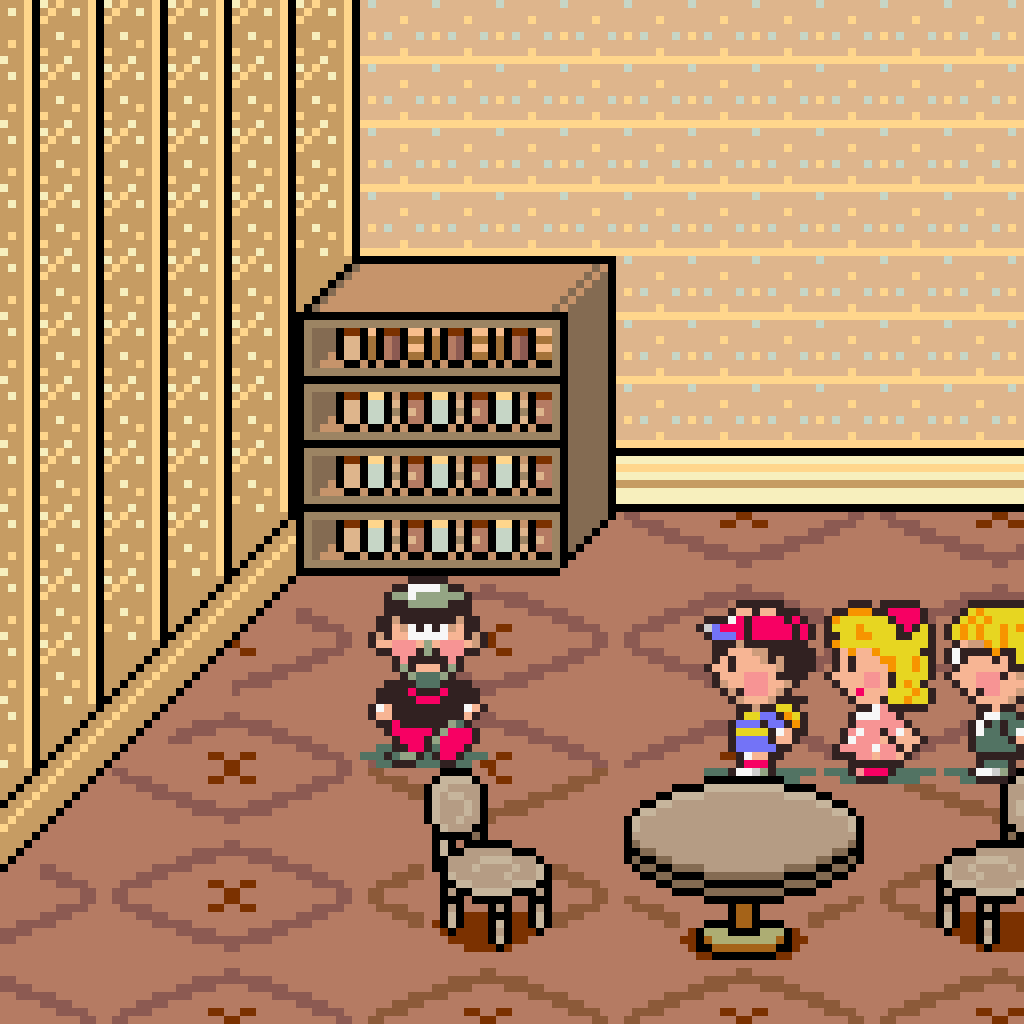
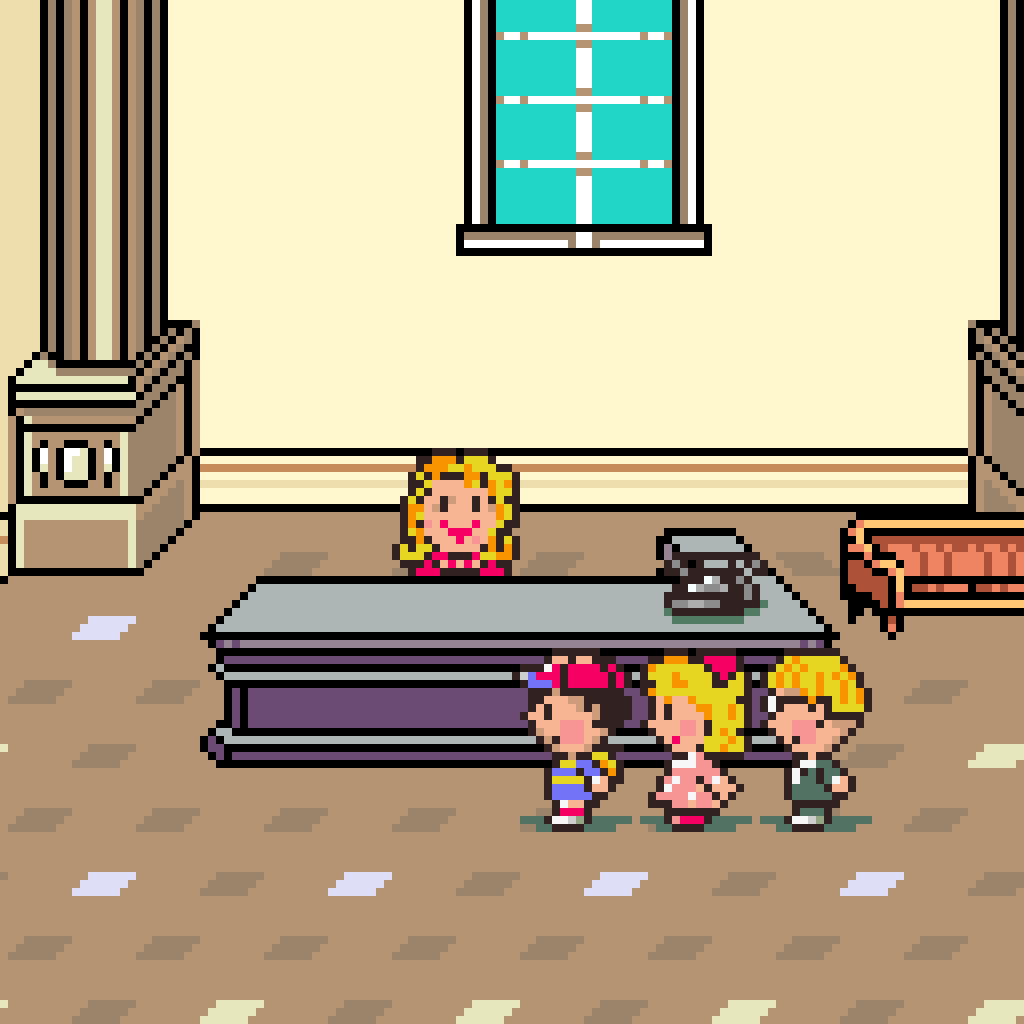
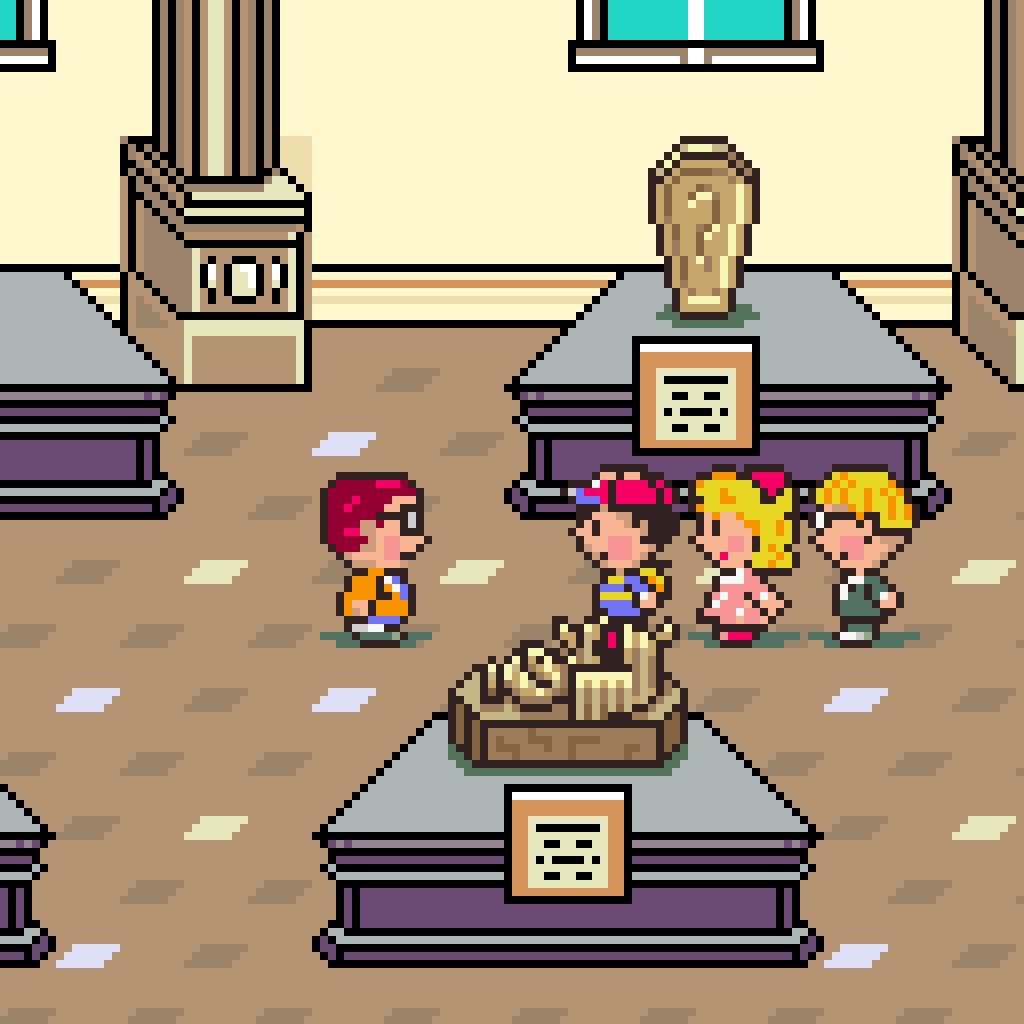
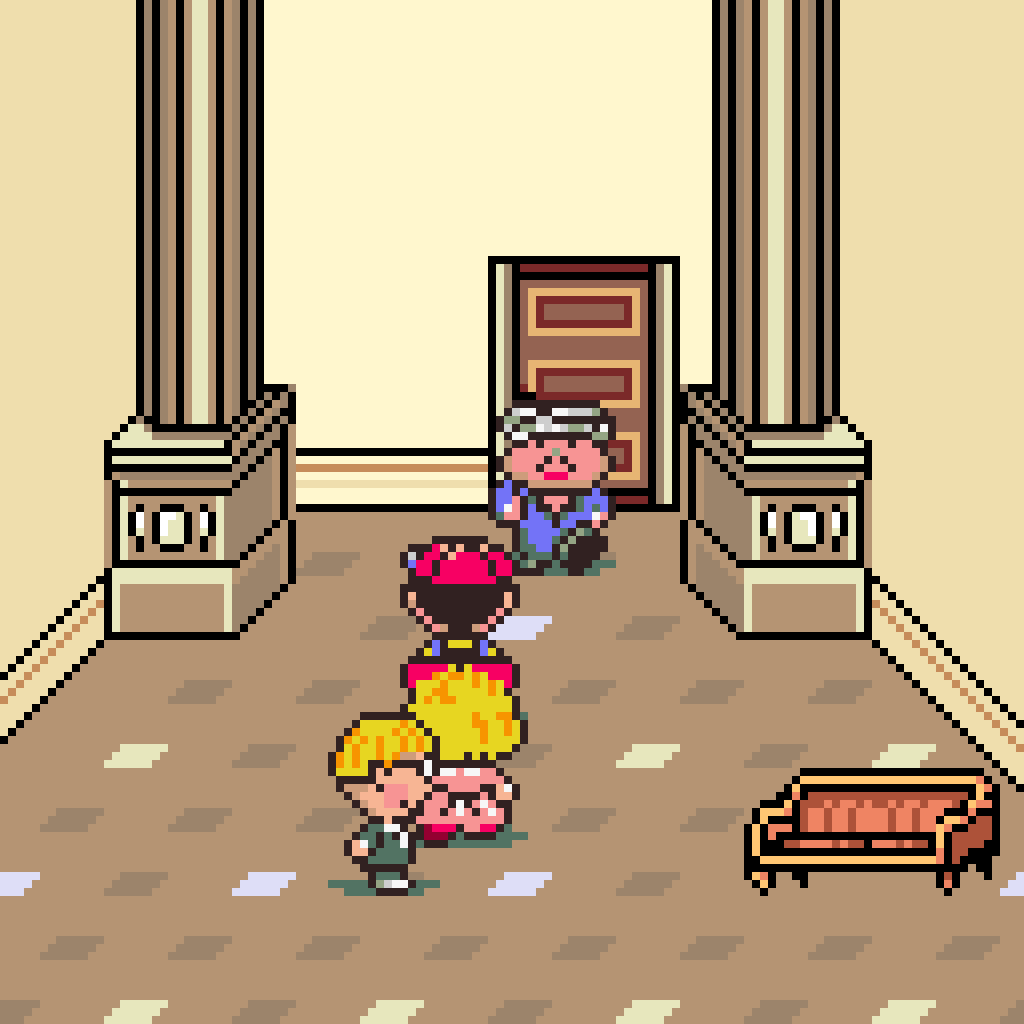
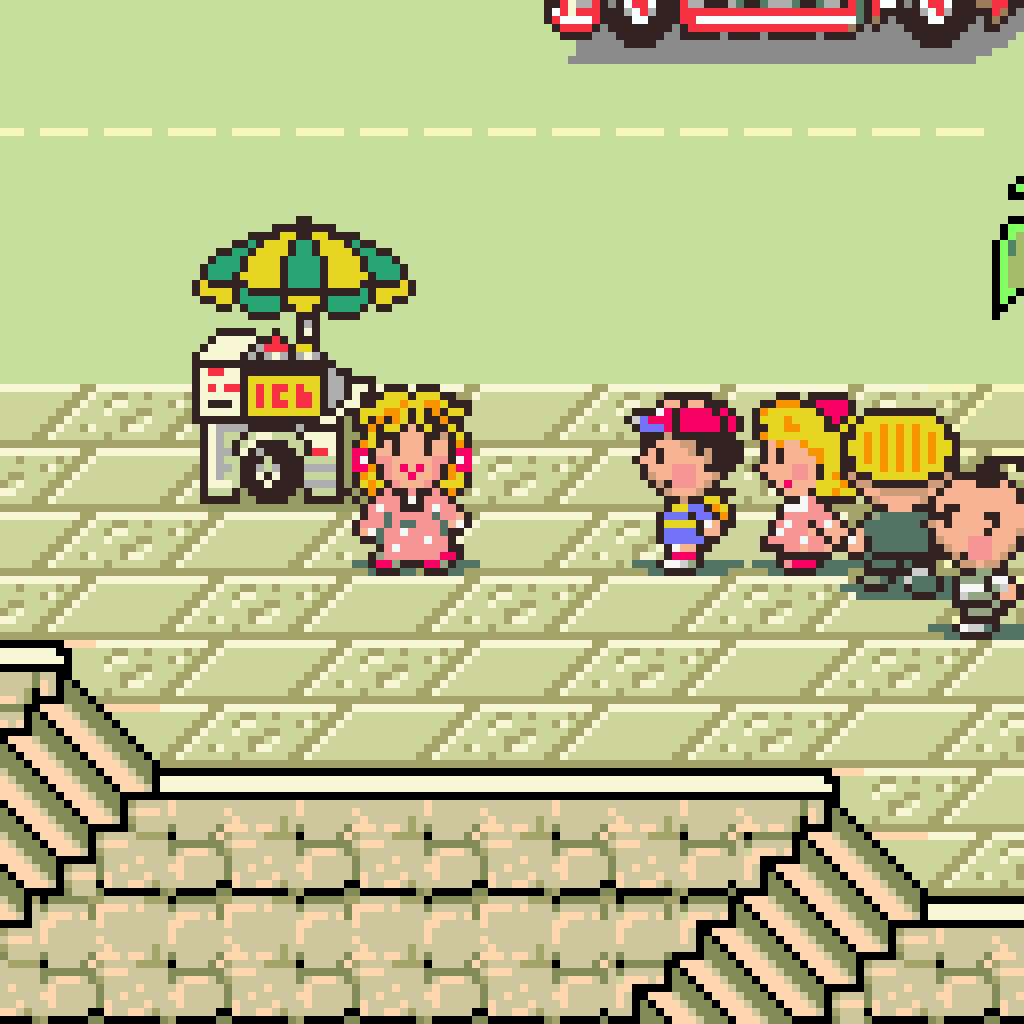
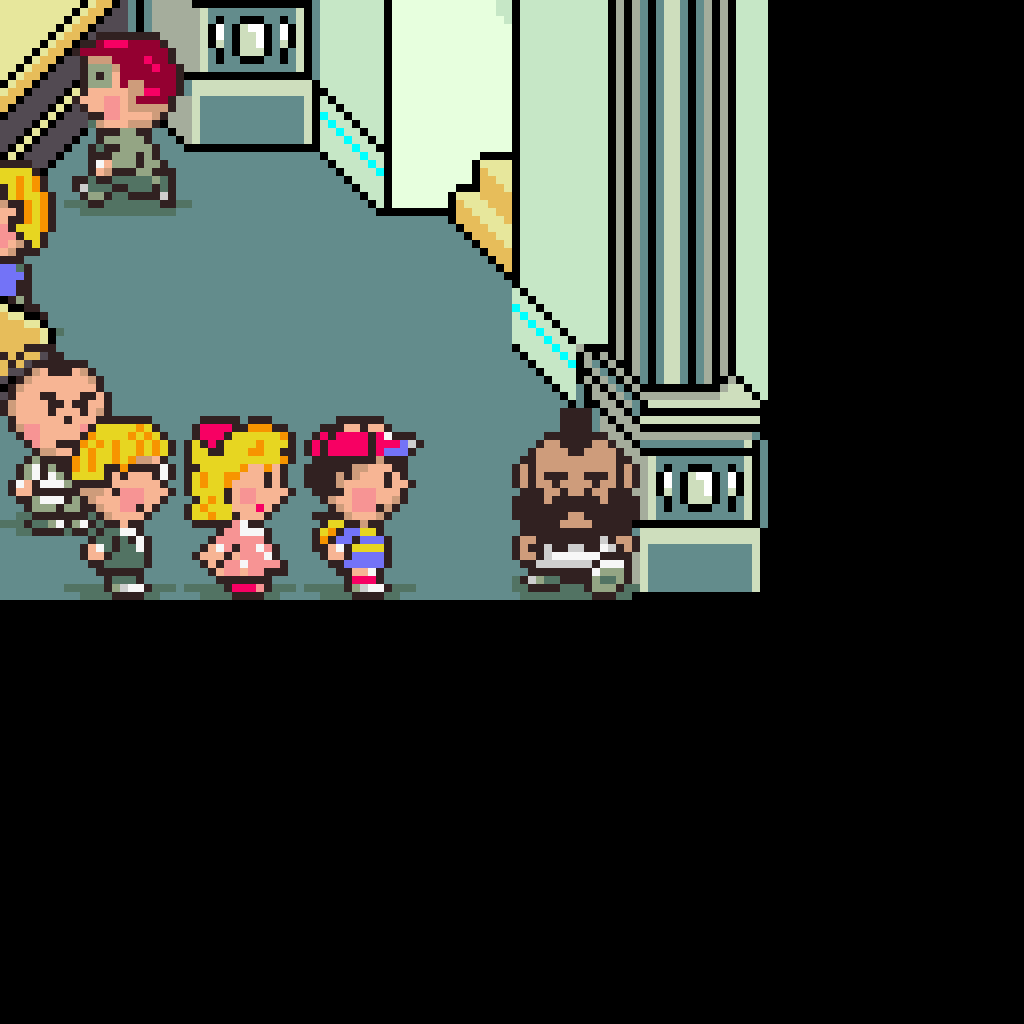
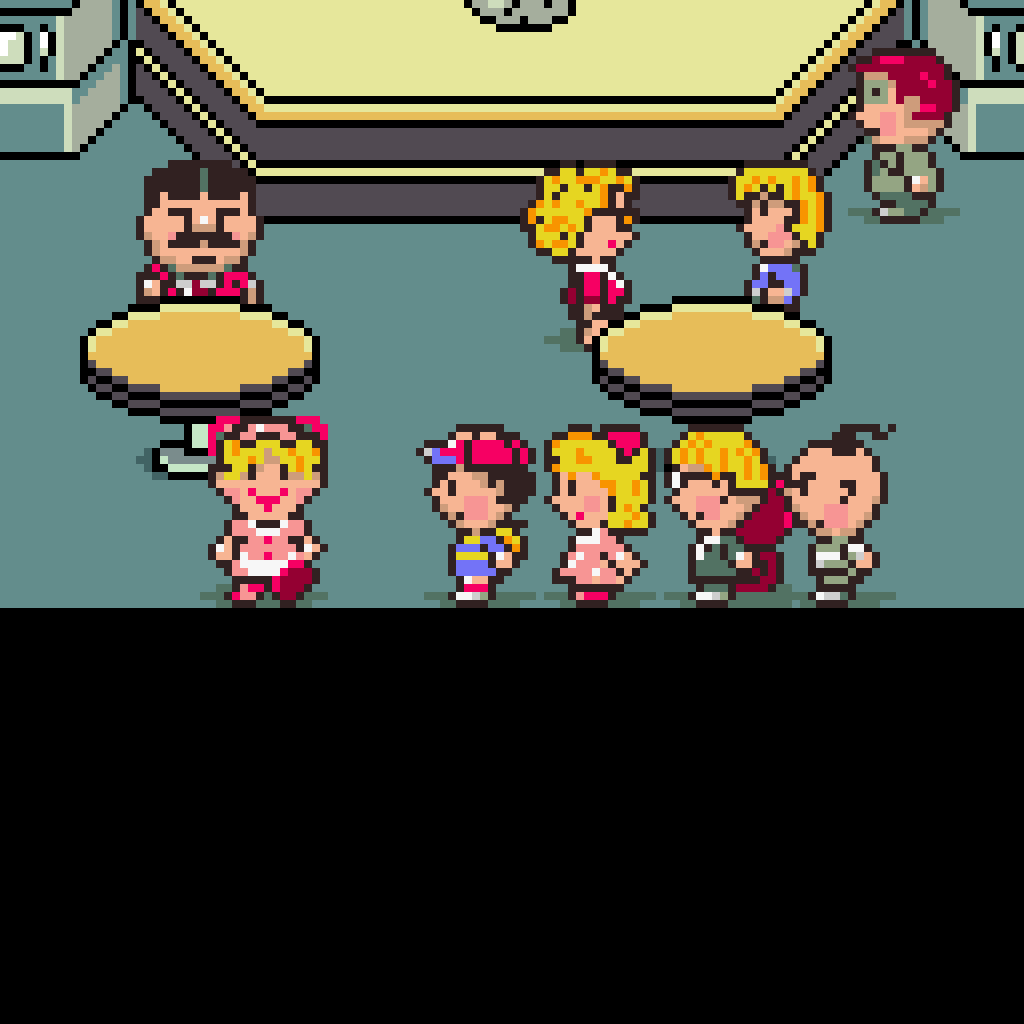
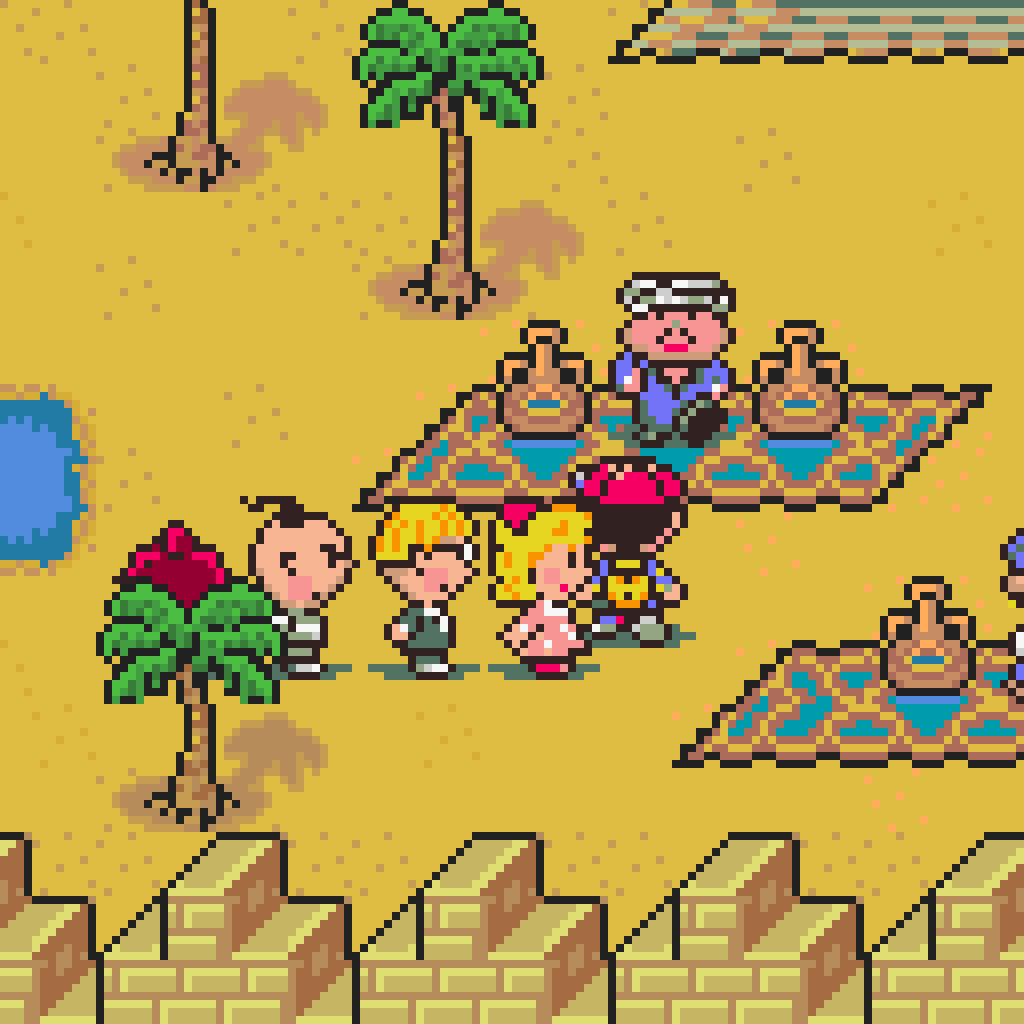
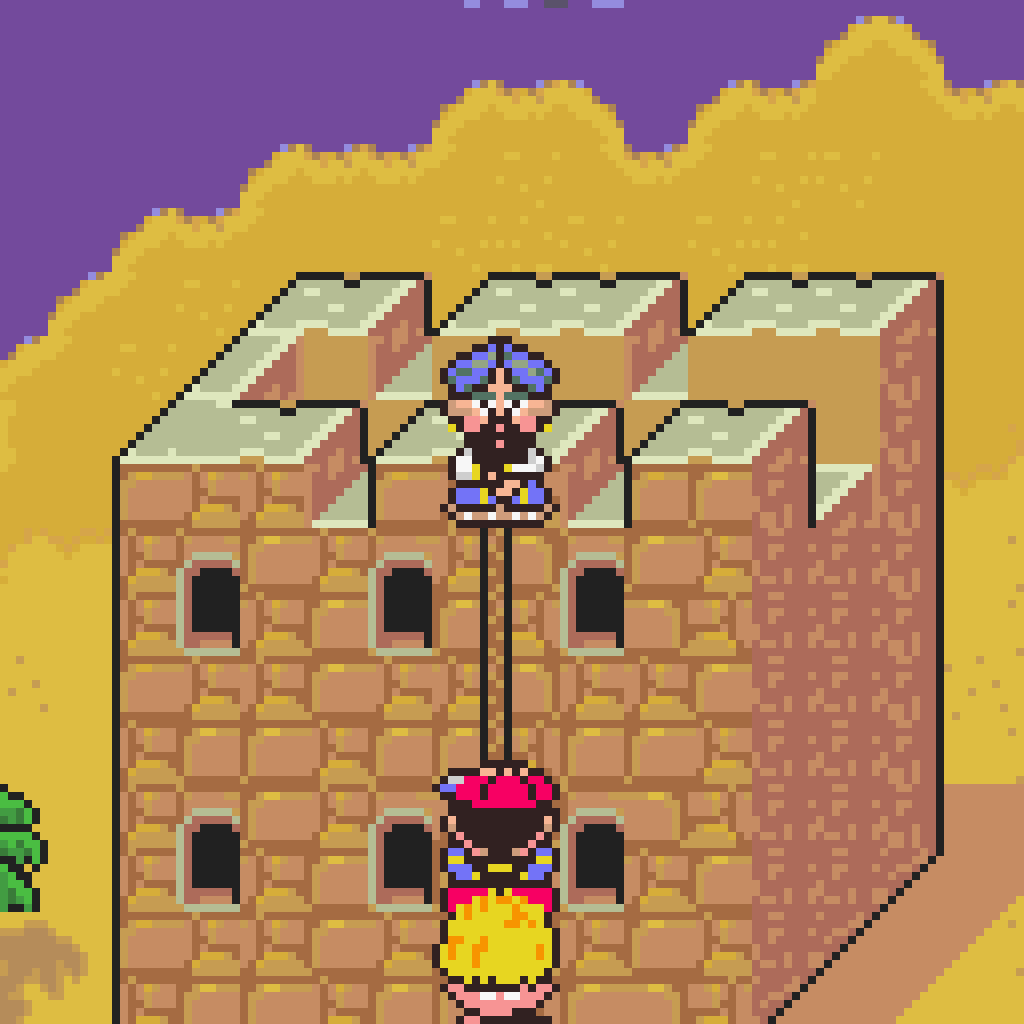
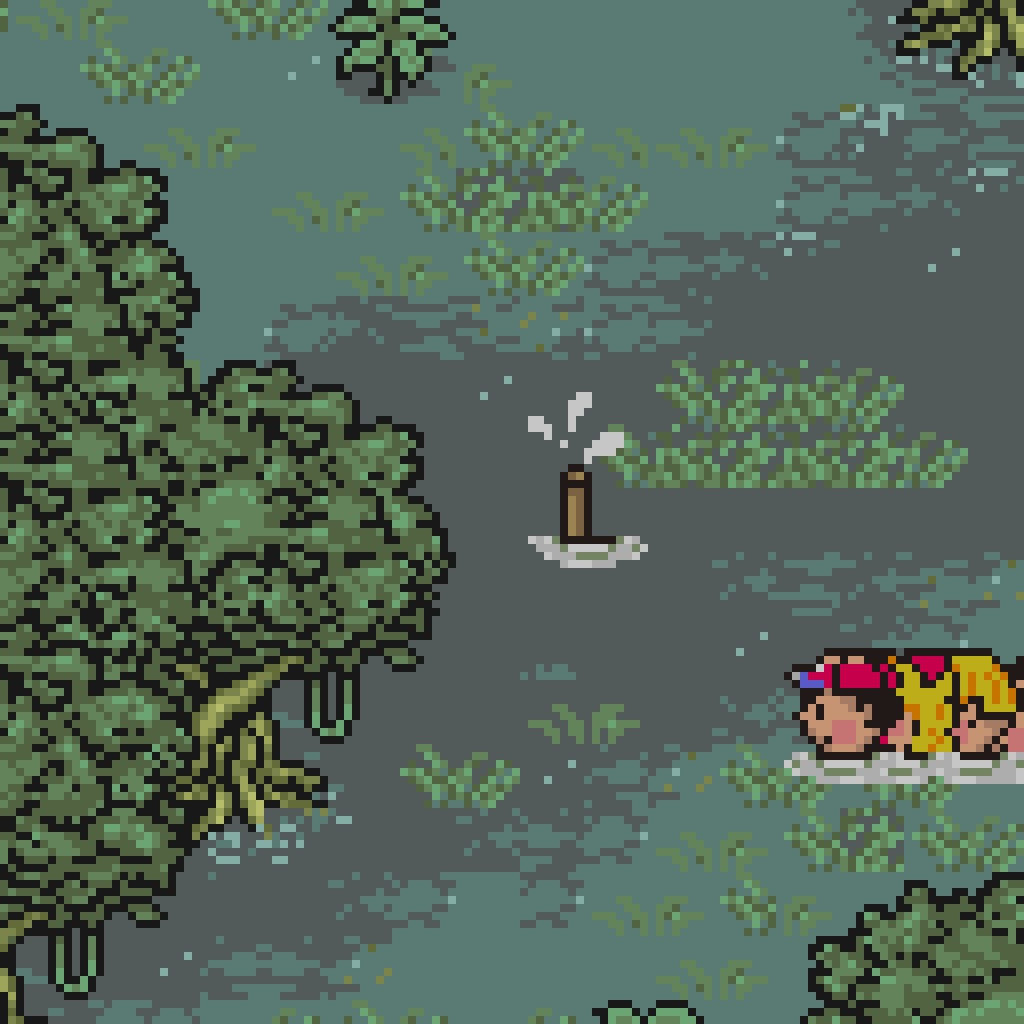
Of course, there are so many files and so many developer comments to wade through that I’m sure I missed a bunch more.
Pre-Release Text Discoveries
These game development files also offer some surprising bits of text that eventually changed before the game’s final release. Most of these finds are completely new and never seen before. Below are a few examples.
Twoson’s Name
In the first town of Onett, there’s a little girl who stands in front of a billboard and has a line of text related to billboards. Early in the game’s development, her line involved two jokes: Japanese wordplay and the fact that a little kid is testing an older kid’s reading skills:
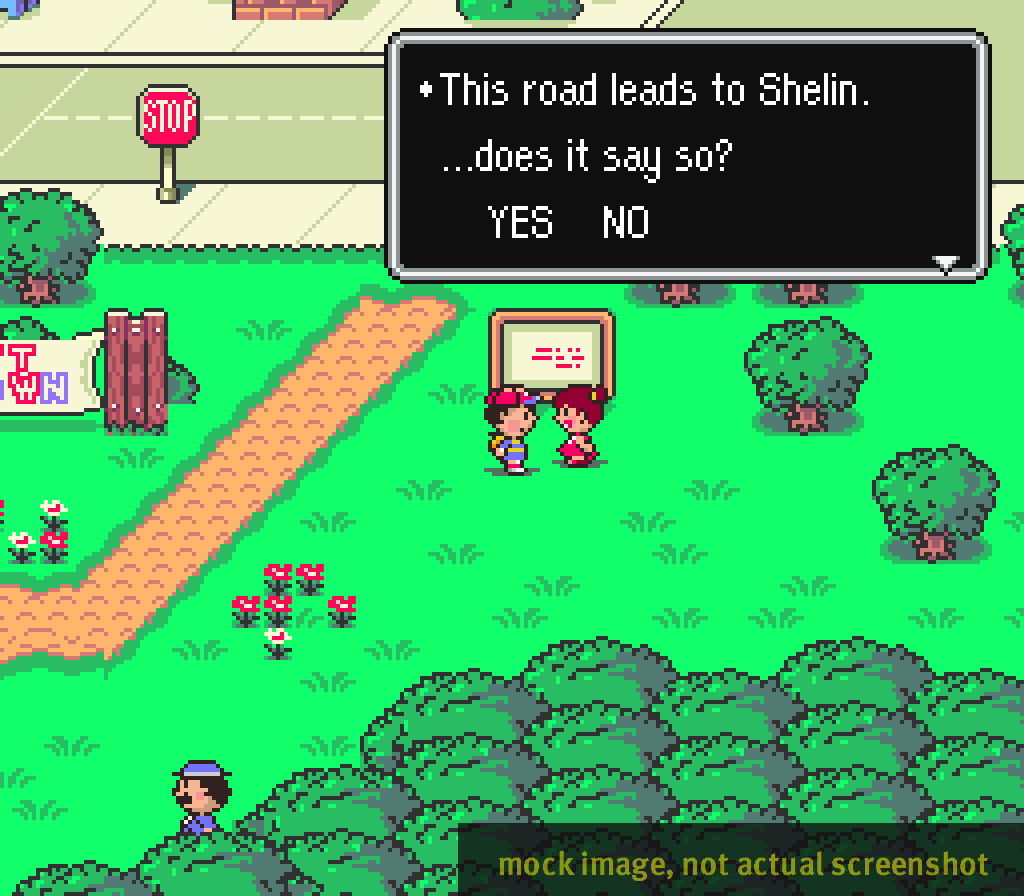
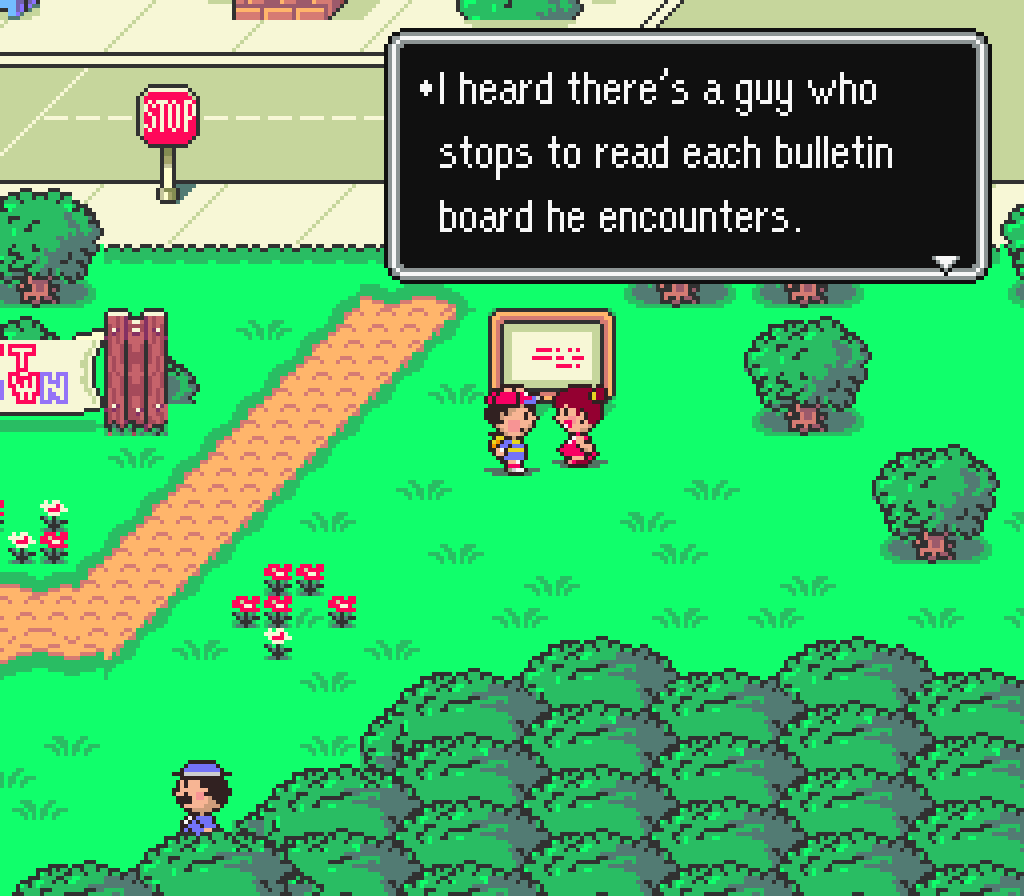
| Japanese text | Official translation |
|---|---|
| ◆このみち シーリンに つづく。 ‥‥って かいてあるんでしょ? <はい> <いいえ> | ・This road leads to Shelin. …does it say so? |
| If you say “yes” | |
| ◆「ツ」と「シ」‥‥それから ‥‥「ソ」と「リ」は よみまちがえない ようにね。 | ・Don’t confuse your p’s and q’s. Also, don’t mix up d and b. It’s easy to make mistakes when reading. |
| If you say “no” | |
| ◆ちゃんと よめたね。 | ・Could you read it OK? |
As we can see, someone actually translated this unused, pre-final line into English. Interestingly, it was also half-localized.
When you first start to learn how to read Japanese writing, ツ (tsu)and シ (shi) are easy to mix up, as are ソ (so) and リ (ri). So the joke here is that ツーソン (tsūson, “Twoson”) looks just like シーリン (shīrin, “Shelin”) if you’re not good at reading.
We can see that the English translation leaves the “Shelin” name unchanged, but it doesn’t make as much sense for a poor English reader to mistake “Twoson” for “Shelin”. Yet the following sentence has been localized to talk about mixing up similar-looking English letters.
Incidentally, the official English translation says “Could you read it OK?”, but this is a bit off. The little girl’s line is more like “Oh, you actually managed to read it.”, as if surprised. Even though this line didn’t make it into the final release, the final script does include “don’t you even know how to read?” jokes, just in other places in the game.
Sign Changes
According to the developers’ notes, the sign early in Peaceful Rest Valley is actually a fake placed there by Pokey, the game’s most annoying antagonist. What’s more, the sign used to say something different:
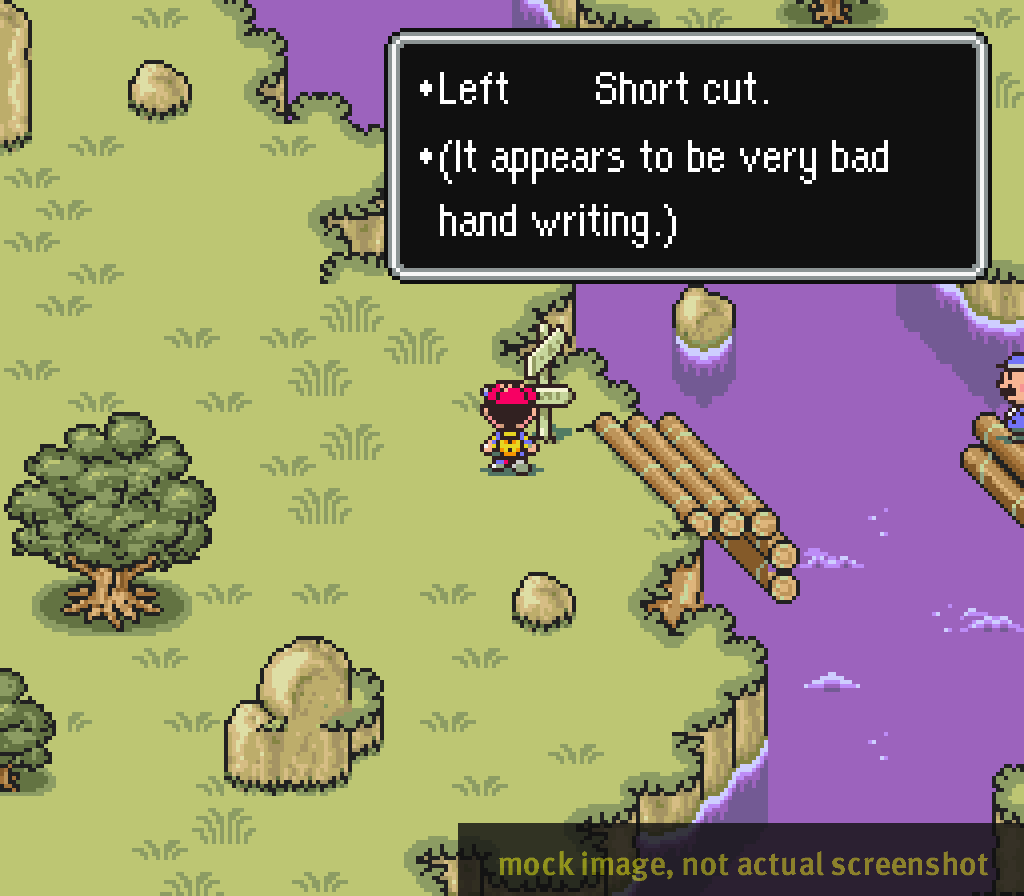
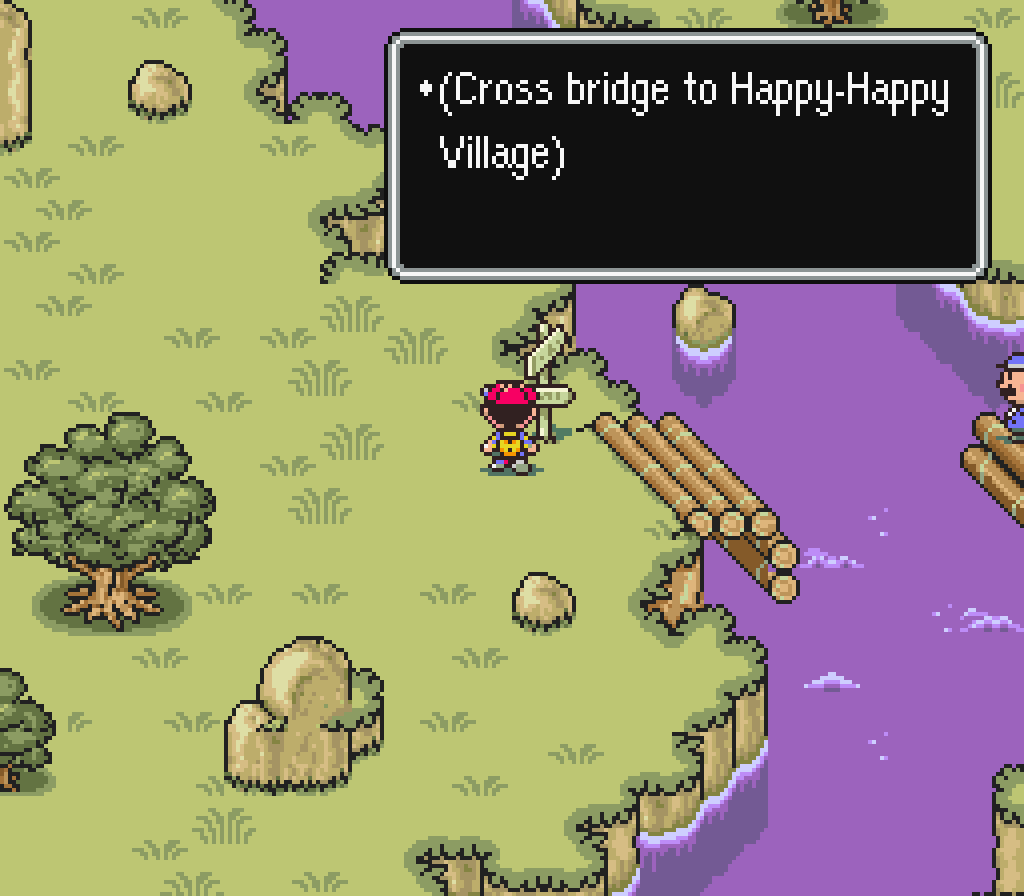
| Japanese text | Official translation |
|---|---|
| ◆ひだり ちかみちでございませ。 ◆(なにやら ずいぶん ヘタクソな もじだ) | ・Left Short cut. ・(It appears to be very bad hand writing.) |
There are two signs later in the game with similar jerk-ish messages from Pokey, so it sounds like it was meant to be a clear running gag, and that your first encounter with these messages was planned for much earlier in the game.
Speaking of which, a similar message in the town of Threed changed during the game’s development:
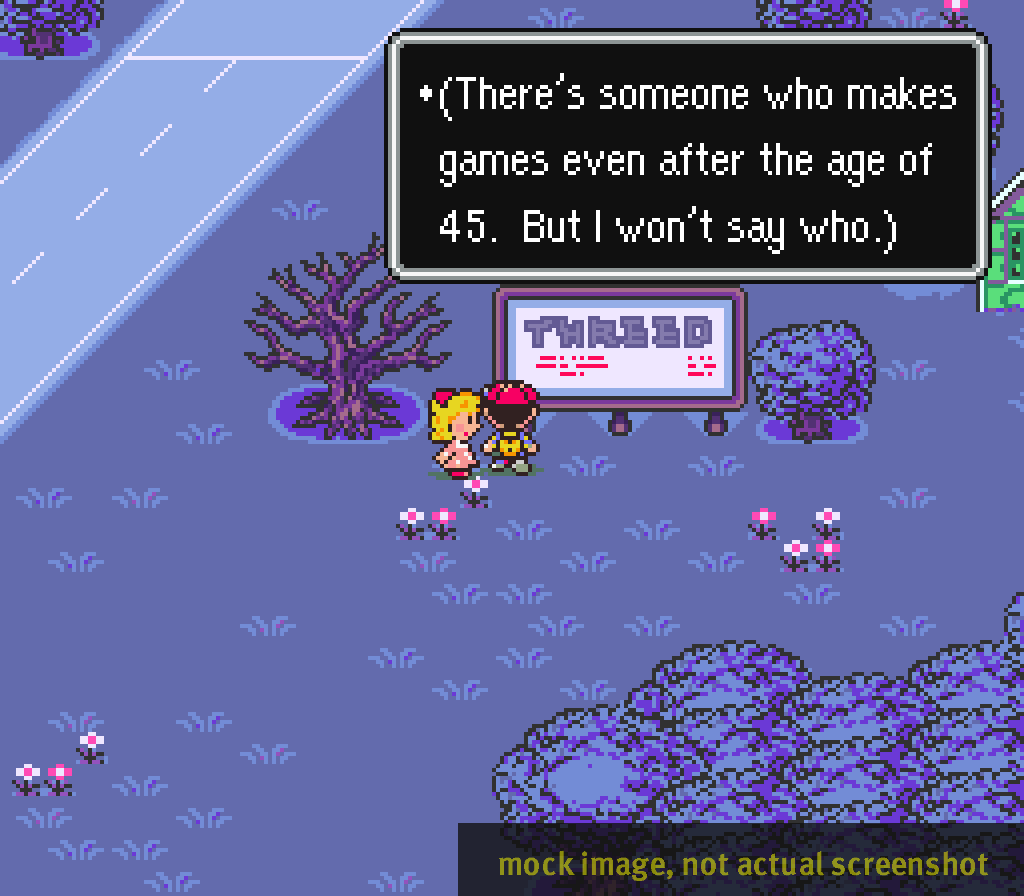
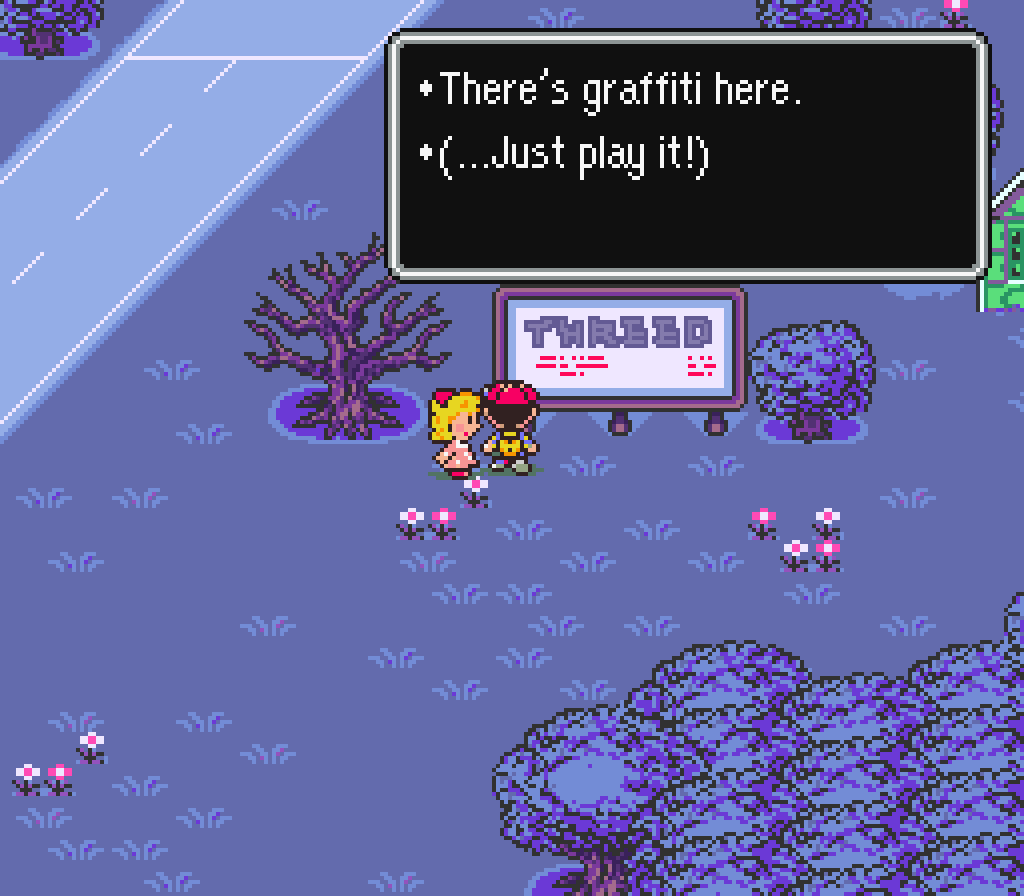
| Japanese text | English meaning |
|---|---|
| ◆(45さいを すぎても ゲームをつくっている ひとがいます。 ◆なまえは いいません) ◆かんばんには らくがきが されていた。 | ・(There’s someone who makes games even after the age of 45. ・But I won’t say who.) ・The sign has graffiti on it. |
The original graffiti message is referring to the series’ creator, Shigesato Itoi, who had just turned 45. In the final Japanese release, this was changed to the game’s Japanese slogan, “Grownups, kids, and even your sister”. In the final English release, this was changed to “Just play it!”.
References to Previous Game
The final script in MOTHER 2/EarthBound contains few (if any) direct references to the previous game in the series. But according to the development text files, there were some clear callbacks at some point. Below are two examples.
First, at one point in the game, a character named Orange Kid calls and asks if you know where Apple Kid is. Originally, Orange Kid wanted his copy of MOTHER 1/EarthBound Beginnings back:
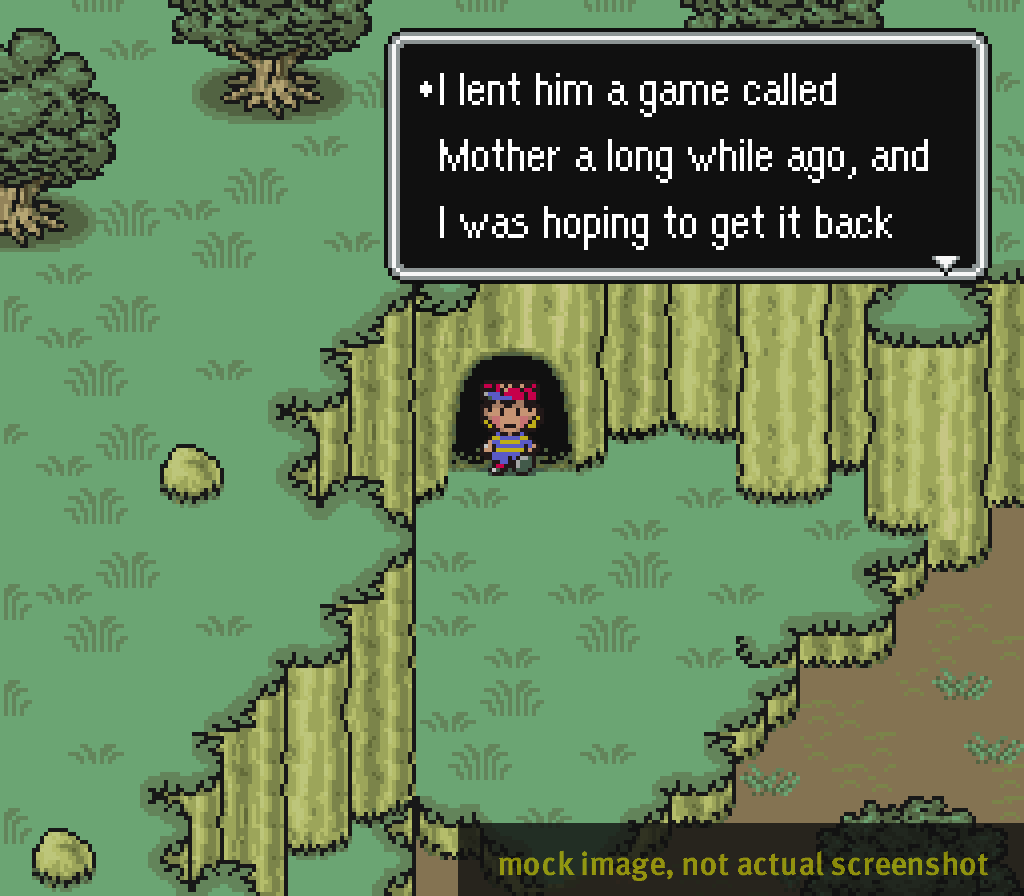
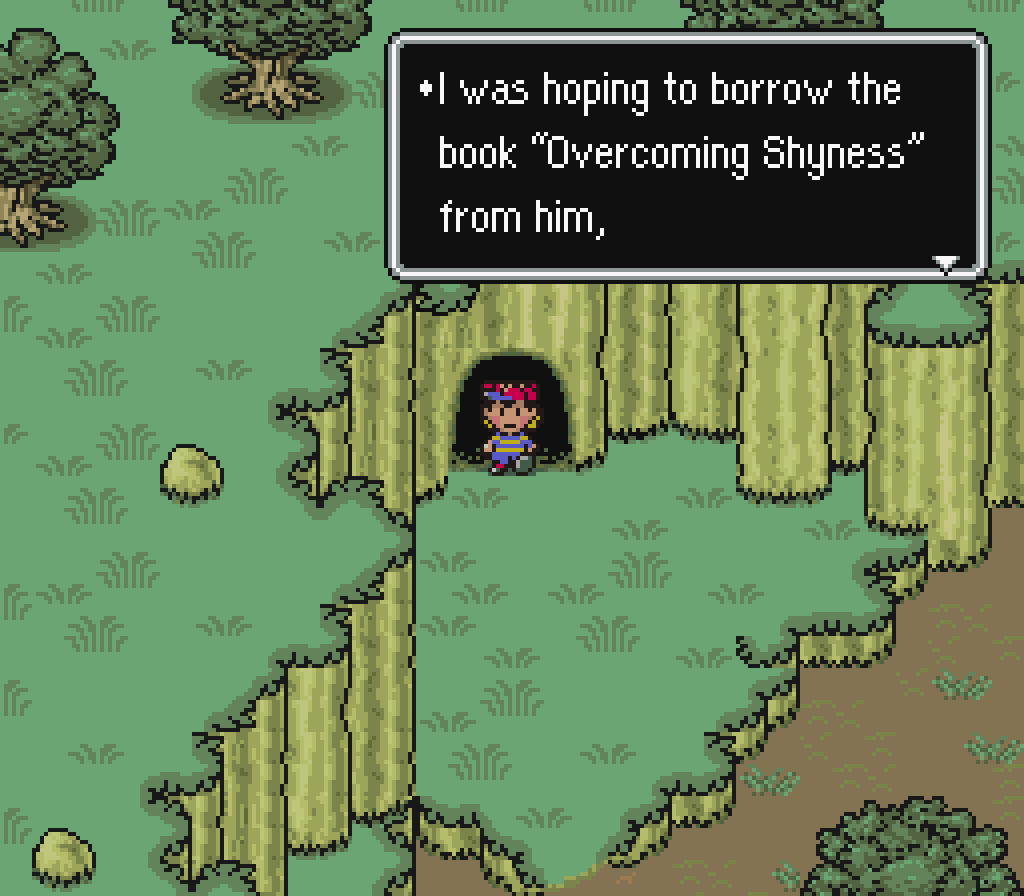
| Japanese text | English meaning |
| ◆むかしの「マザー」っていう ゲームソフトを かしてたんで かえしてもらおうと おもって‥‥ ◆じゃ そこには いないんですね。 しつれいしました。 ◆ガチャン ツーツーツー | ・A lent him a game called Mother a long while ago, and I was hoping to get it back from him… ・But I guess he’s not there, huh? Sorry to bother you. ・Click beep-beep-beep… |
In the final version of the script, Orange Kid instead wants to borrow a copy of the “Overcoming Shyness” book. In fact, according to the development files, it sounds like this whole “Overcoming Shyness” book event changed several times during the game’s development.
Next, at the end of the game, just before the final boss battle, Pokey originally made an indirect reference to the previous game:
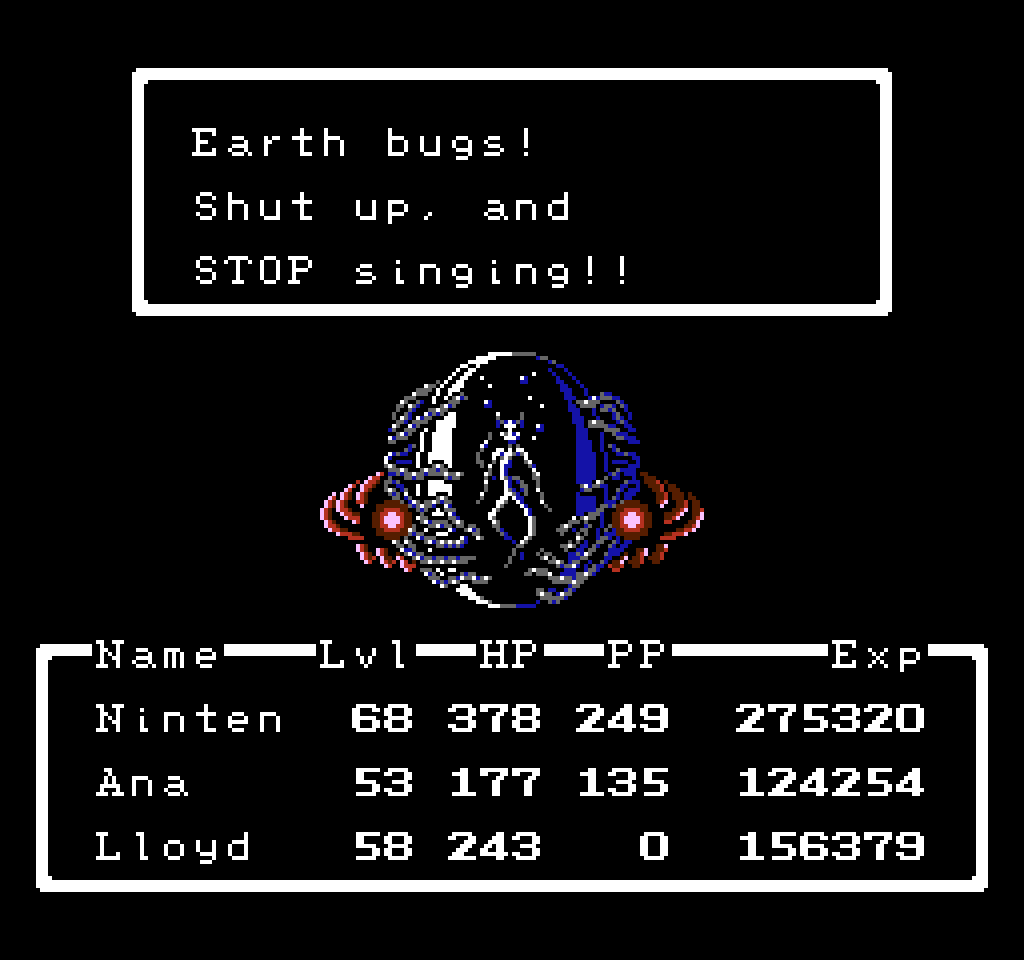
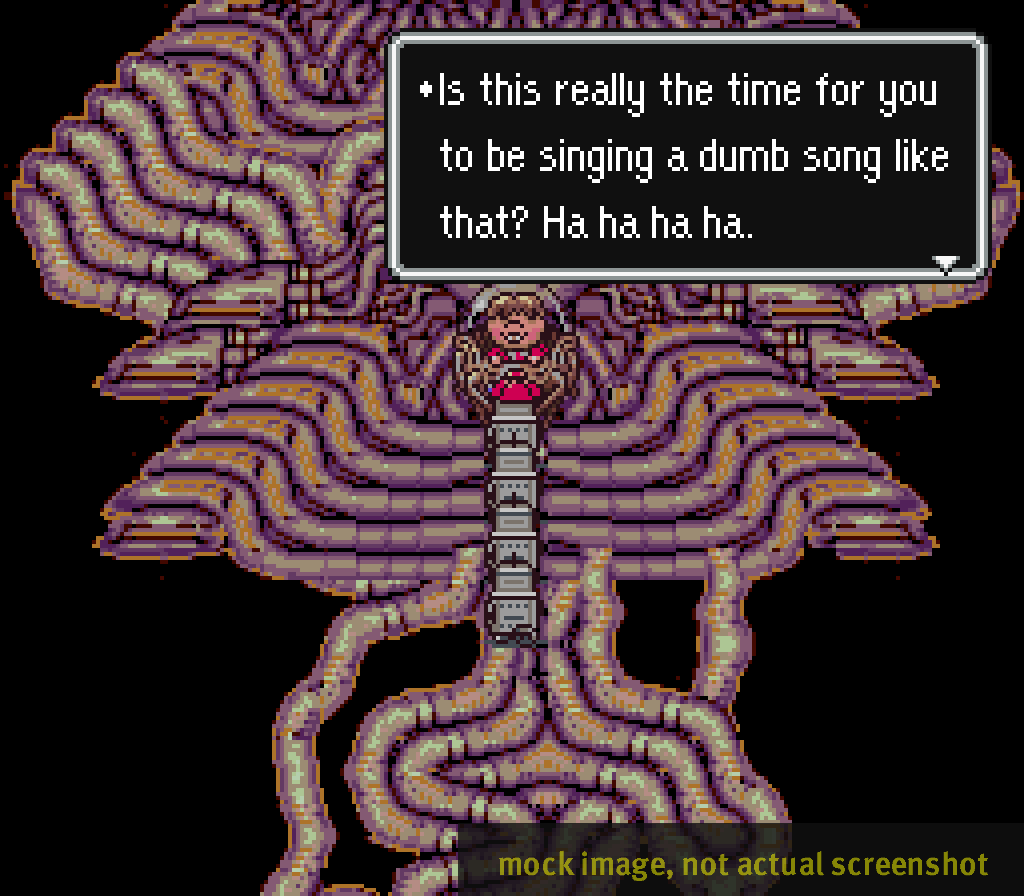
| Japanese text | English meaning |
|---|---|
| ◆そんな うたなんか うたってるばあいか? ハハハハ。 | ・Is this really the time for you to be singing a dumb song like that? Ha ha ha ha. |
In MOTHER 2/EarthBound, you collect fragments of a melody in an item called the Sound Stone. I assume that that’s the song being referred to here, but at no point in the final game do the characters ever sing, so I’m not sure how singing would’ve been accomplished in this scene. Perhaps your party could originally use the Sound Stone before the final battle?
Alternate Ending Text
At the very end of the game, there’s a surprise scene that sets up a potential sequel. In the final release, a letter from Pokey mysteriously shows up in the mailbox, even though it’s the middle of the night and even though there isn’t even a stamp on the envelope.
According to the development files, this final scene had some slightly different text:

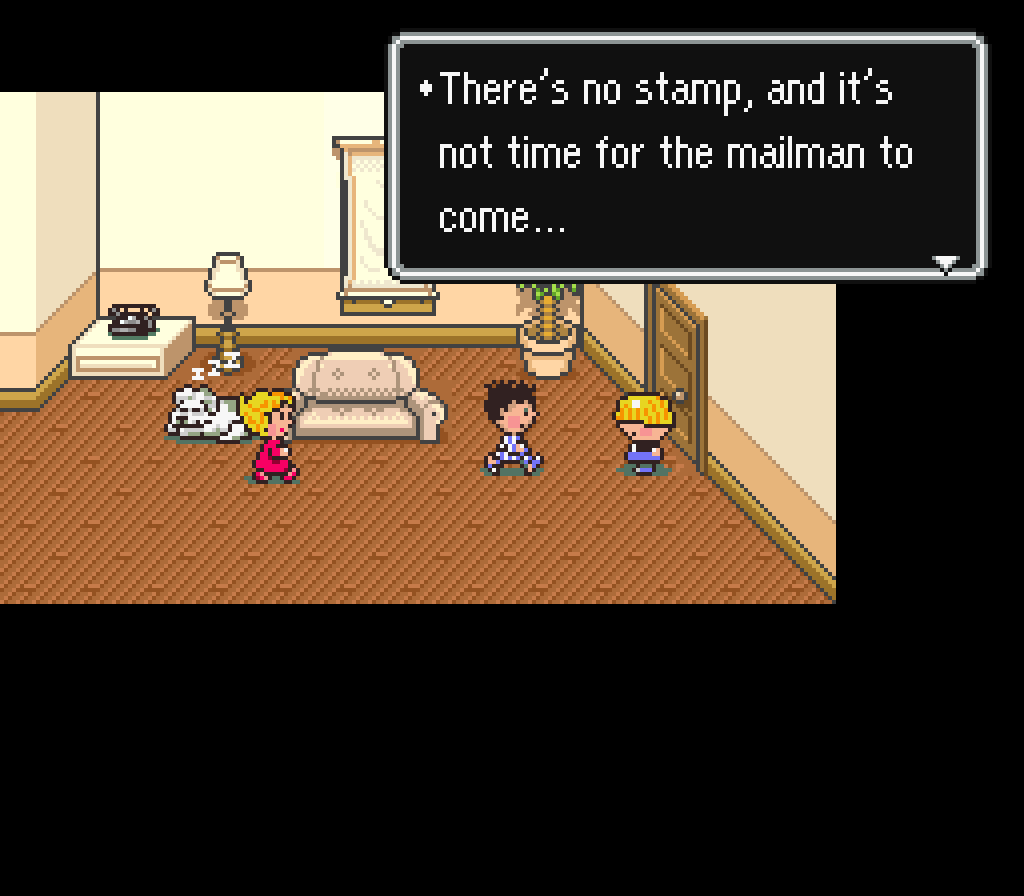
| Japanese text | English meaning |
|---|---|
| ◆とつぜん トカゲが たずねてきて ◆ポーキーにいちゃんの てがみを おいてったんだ。 ◆「ここまで おいで! おしりペンペーン」‥‥だって。 ◆‥‥どこにいるんだろう? | ・A lizard suddenly stopped by and left a letter from Pokey. ・It says, “Come and get me! Spankety-spankety!” ・I wonder where he could be…? |
Who or what is this lizard? I don’t really know, but perhaps the series creator had something in mind that never made it into the sequel released a decade later.
English Text Discoveries
Because these files are from when EarthBound’s English localization was still underway, we can see that many of the English lines are still in an unfinished state. Below are some noteworthy in-progress lines, side-by-side with their final counterparts.
Delayed Release
MOTHER 2 was notoriously stuck in development hell and was almost cancelled at one point. The game suffered major setbacks and delays, and a character in the Japanese script even mentions this.
This character’s line, including the part about the delay, was fully translated for the English version at one point.
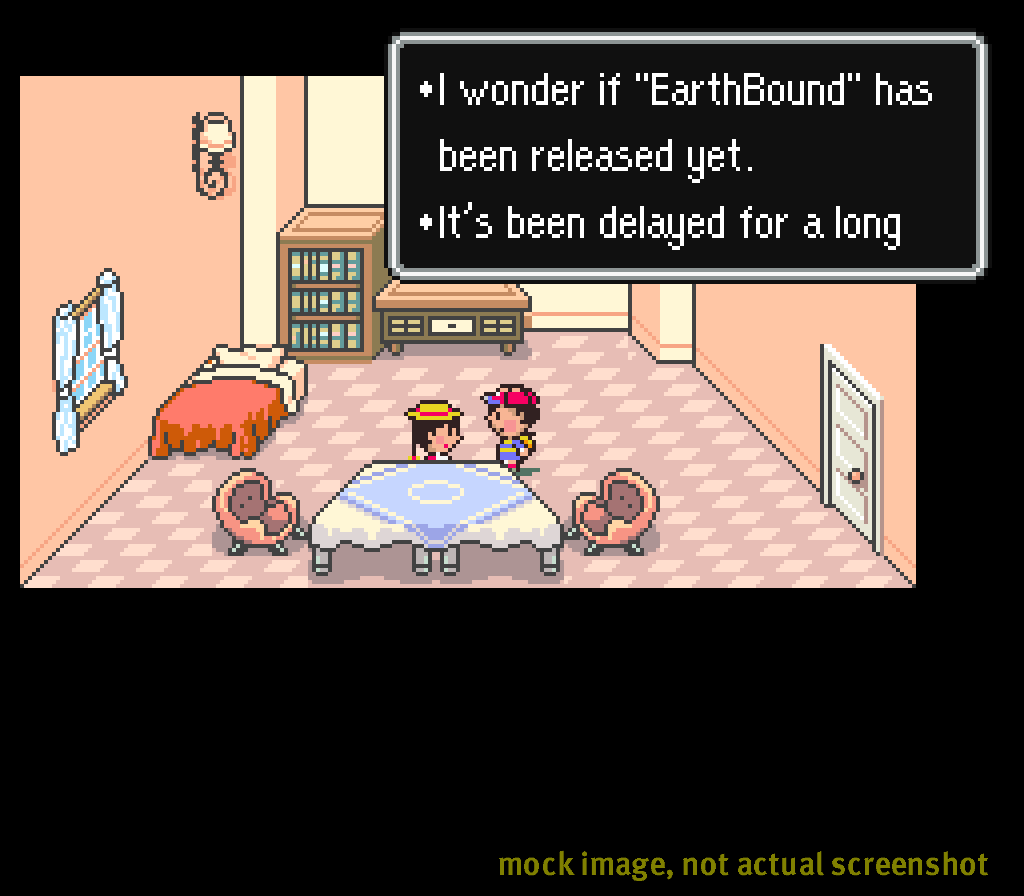
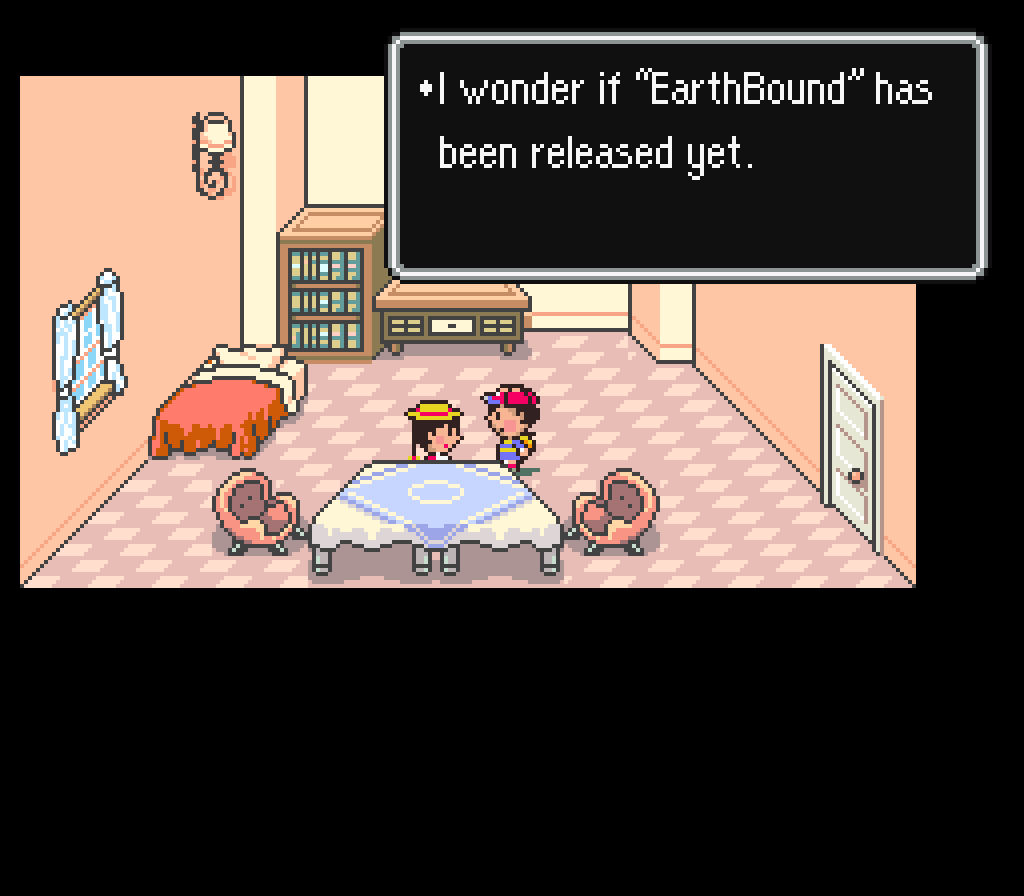
The full original English translation was:
・I wonder if “EarthBound” has been released yet.
・It’s been delayed for a long time.
As we can see, the part about the delay was removed from the line before EarthBound’s release, presumably because EarthBound never suffered from the same major delays that MOTHER 2 did.
Wrong Directions
A character in Onett explains where the local hotel is located. But this explanation originally had a mistake in it: “west” was mistranslated as “east”.
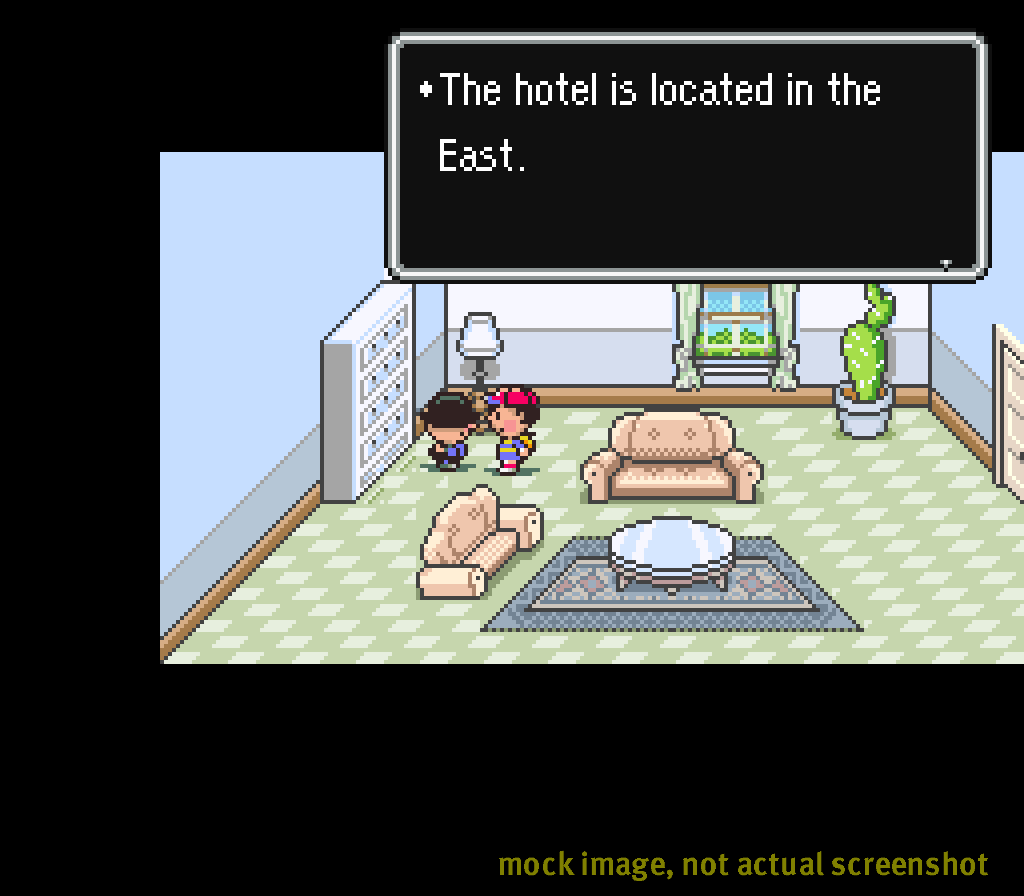
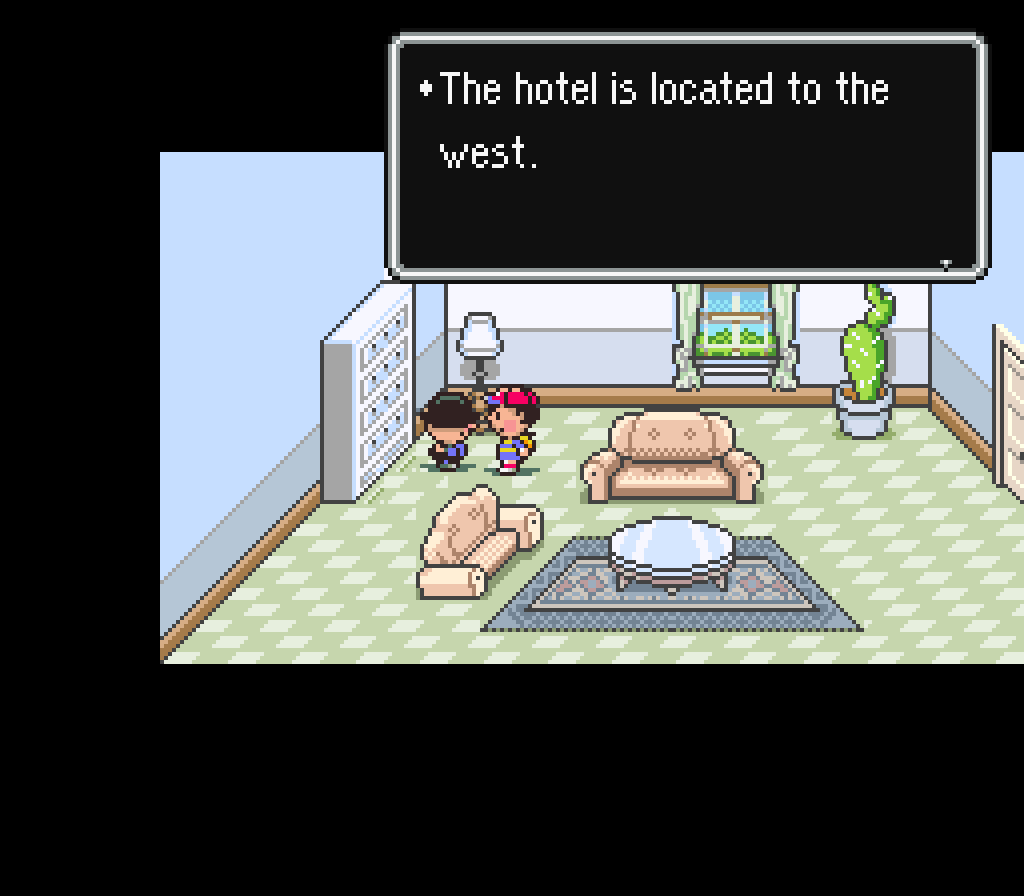
The full original line was:
・The hotel is located in the East.
・I’m sad ’cause I only got this short message.
I think this mistake was only caught because of the obvious factual error. I feel it probably slipped through the initial translation stage but was luckily caught during a play-testing session later on.
Pencil Problems
Throughout the Japanese game, several metal octopus statues block your way. In the English version, these octopus statues were famously changed into metal pencil statues:
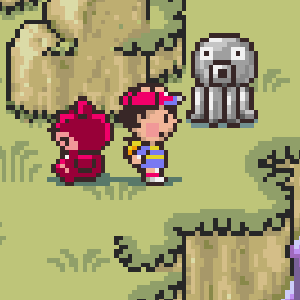
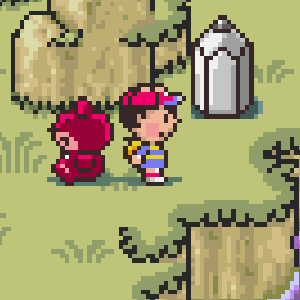
This change required the English script to be updated too, and based on these development files, it looks like the translators did a simple search-and-replace at first. This led to some grammar and logic problems, however:
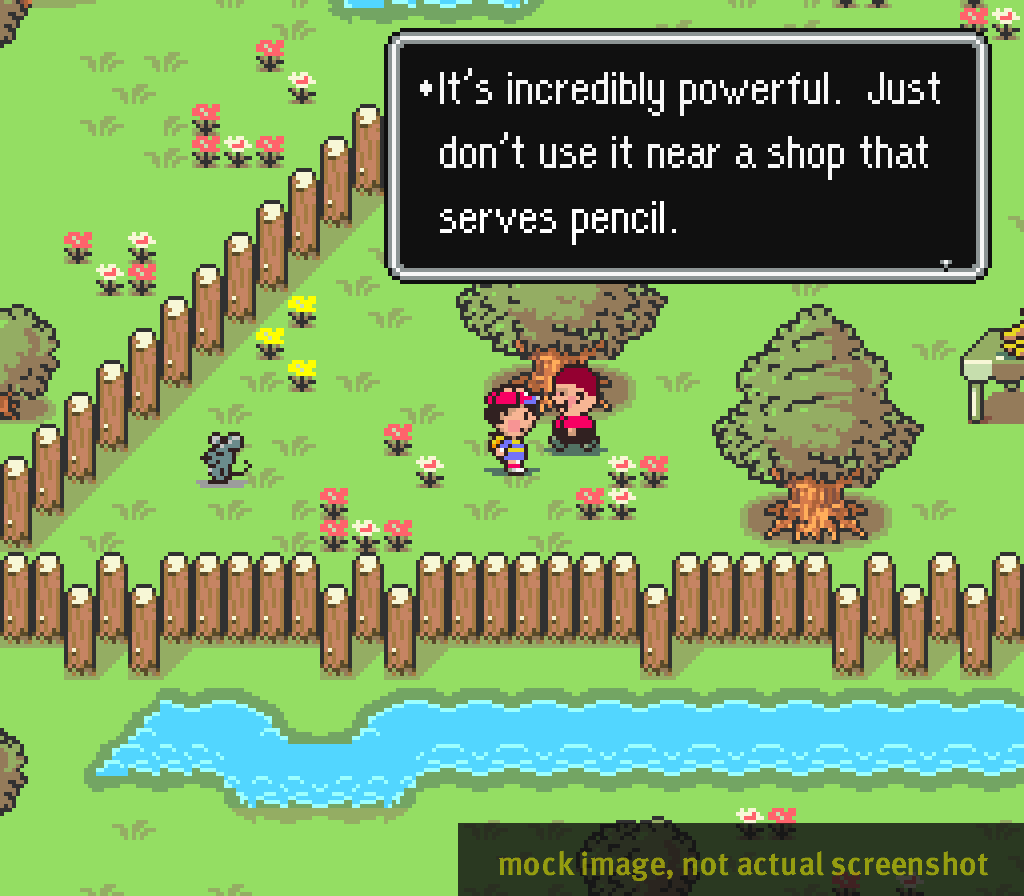
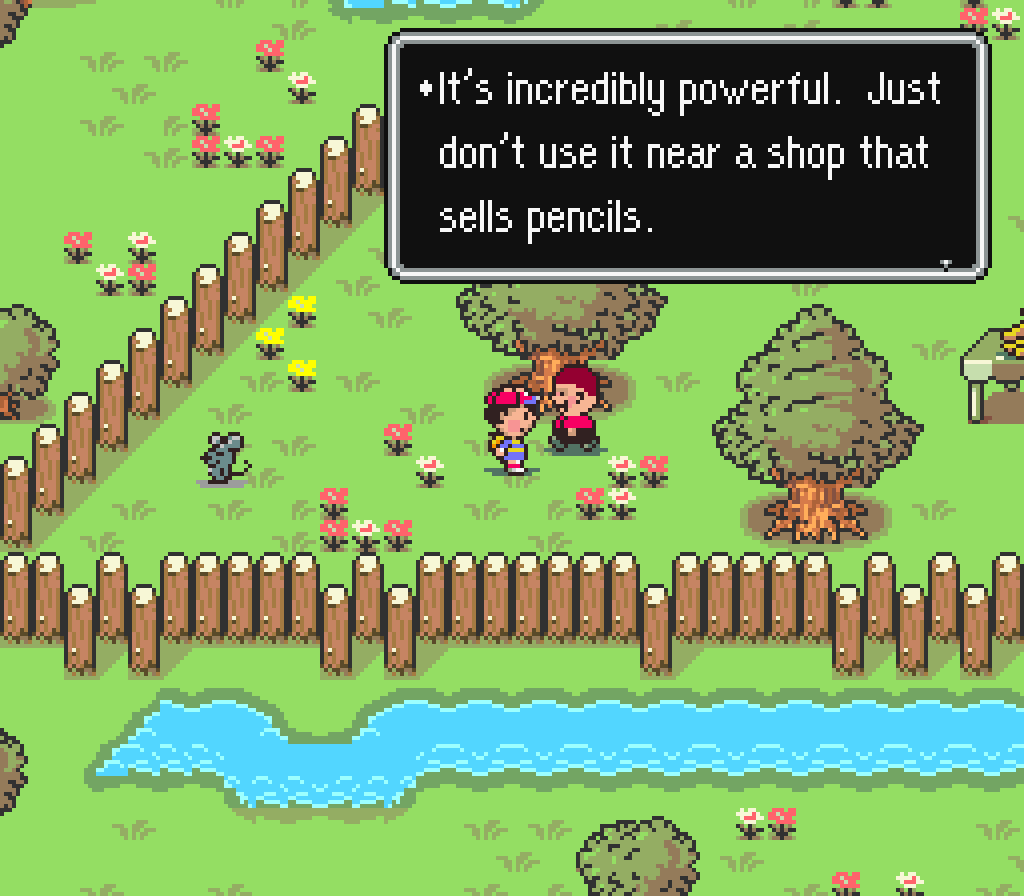
The full, pre-final English line was:
・This machine will eradicate all pencil-shaped figures in just one second.
・It’s incredibly powerful. Just don’t use it near a shop that serves pencil.
Some similar octopus-to-pencil issues included:
・It makes something blocking your way
・that looks like an pencil disappear in just a second.
・(For some weird reason,
・an pencil-shaped iron statue is blocking the path.)
All in all, this is a great example of how changing one thing in a localization can make unexpected issues pop elsewhere, kind of like a game of whack-a-mole.
Attractive Zombie
A man in Threed comments on a strange-looking woman standing in front of the hotel. Long ago, I wrote about how this changed between the Japanese and English scripts, but now we can see that English line was the same as the Japanese line at one point:


For comparison, here are the full lines from the pre-final and final English scripts:
| Pre-final translation | Final translation |
|---|---|
| ・Take a look at that chick in front of the hotel. | •Take a look at that chick in front of the hotel. |
| ・Except for the complexion, she is one hot babe! | •Regardless of some of the people I’ve seen her hanging out with, |
| ——— | •I think I’d like to spend some time with her! |
I can only assume the English line was changed due to Nintendo of America’s content policies at the time. Maybe someone felt the “hot babe” thing was inappropriate here?
Booze Talk
Nintendo of America’s content policies in the 1990s disallowed references to drugs, smoking, and alcohol, so many localized games from the era had alcohol replaced with coffee, soda, and the like. EarthBound was heavily affected by these policies, but I did find one drinking reference intact in the pre-final script.
In this scene, an important character is found on the the ground in a back alley. Onlookers comment on the situation, including this one:
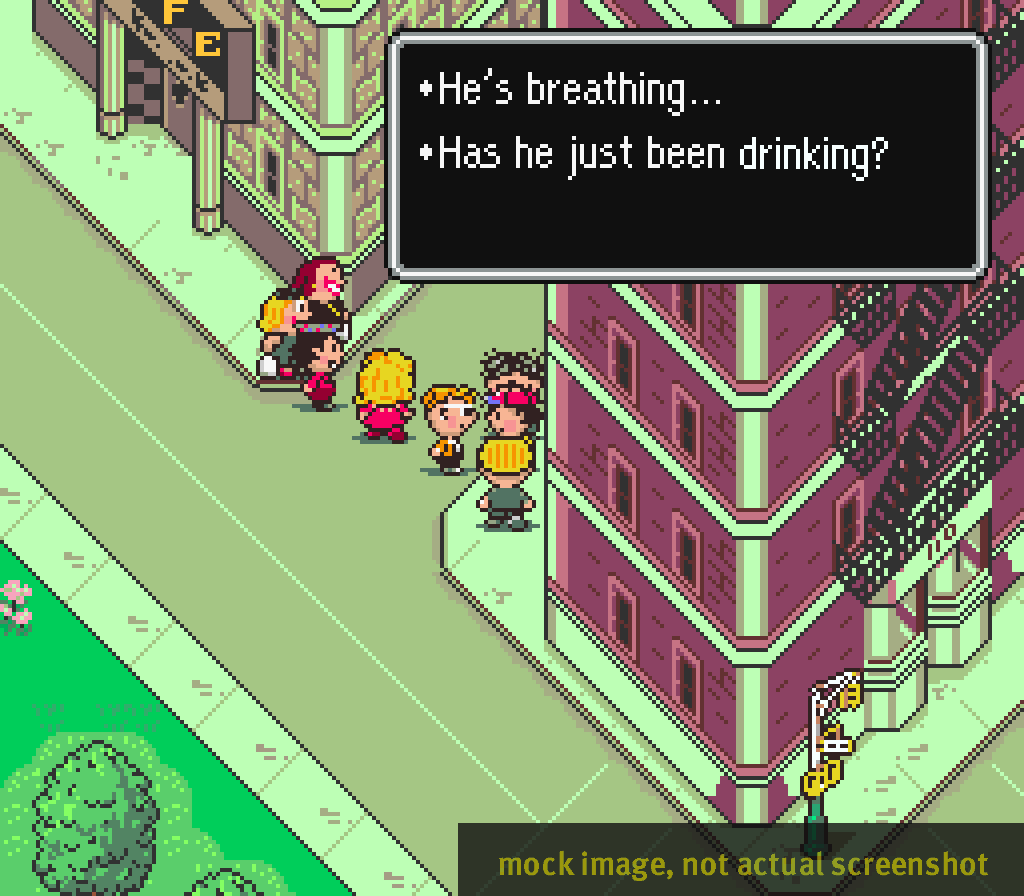
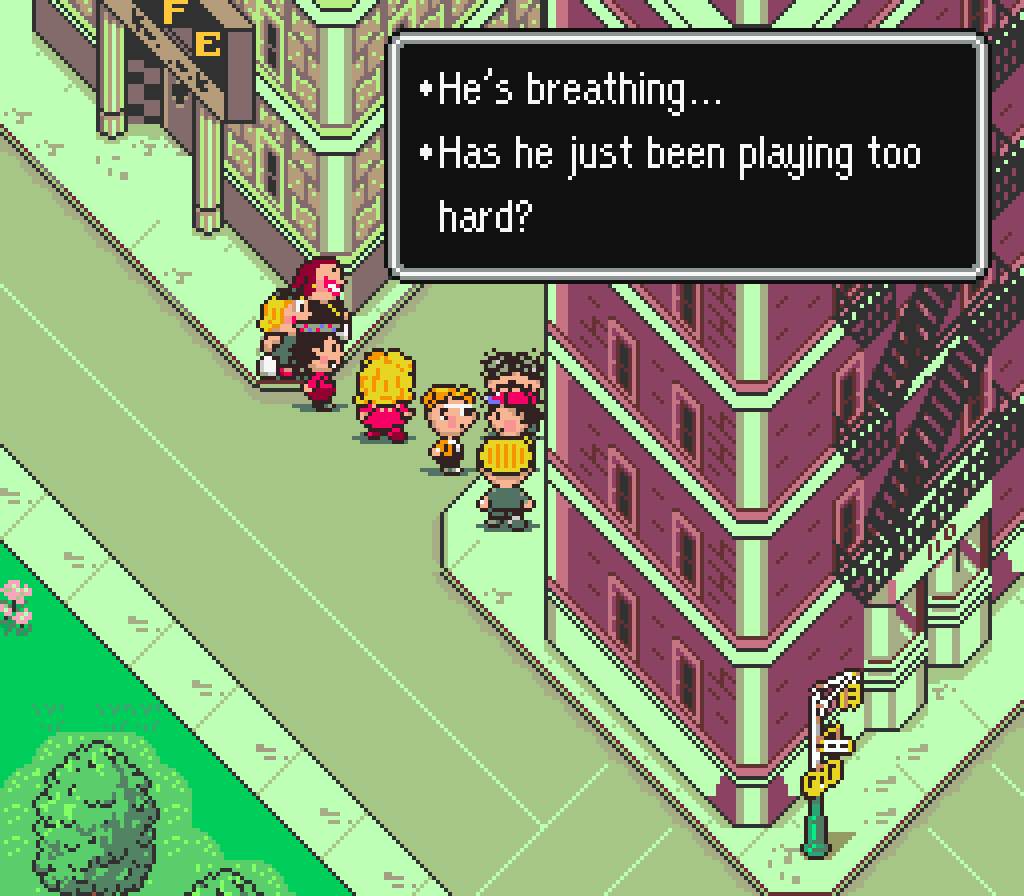
Notes from Developers & Translators
The development files contain the game’s script and related event coding, but that’s not all. The files also contain comments between staff members, as well as information that answers questions that fans have had for decades. I’ve listed a few interesting examples below.
Localization Notes
First, here are some notes from the game’s Japanese staff, explaining various things about the text to the staff at Nintendo of America:
We say “pank” for “flat tire.”
”U fufufu…” is laugh …
”take a shower” is better for American teeens? Also, is it better to say “I’m a little stink.”?
I’m not sure about spelling of groopy. Also, groopy may be slightly different in the US. and Japan. Let’s discuss.
Do you know Paul Mouria? He’s famous in Japan, who makes easy-listening music.
He’s hip. He mixes English and Japanese when he talks.
Just ask me.
Most of these notes are about things I’ve already documented long ago, but it’s cool seeing the original localization process at work like this.
Translation Troubles
Japanese-to-English game translation can be tough, and even nearly impossible in some cases. A few difficult lines in EarthBound resulted in these short translation notes:
*(no verb. cannot translate.yuka)
(*-cannot translate.too short:yuka)
*kun(no translation:yuka)
If you know Japanese, imagine trying to translate something like “を” by itself. Game translation is full of such challenges.
Polite Apologies
One developer left an in-game apology note as a placeholder line for some Escargo Express stuff:
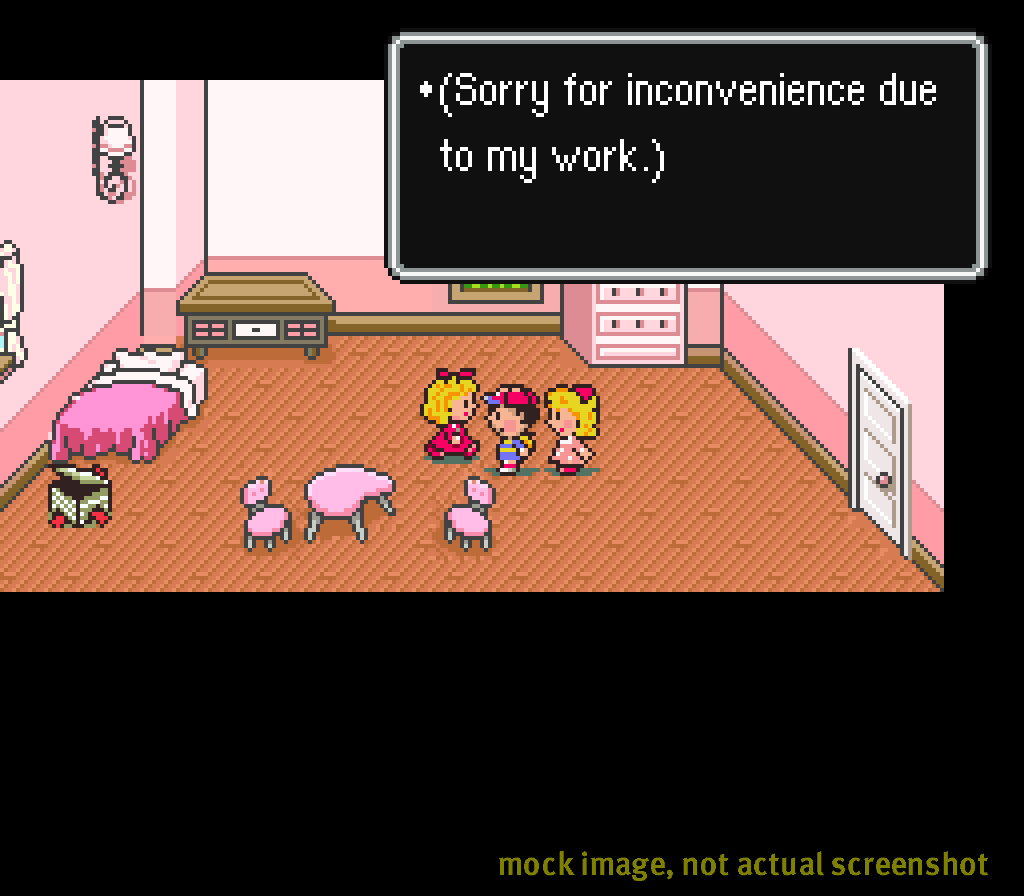
Beverage Narrator
There are two unusual scenes in MOTHER 2/EarthBound in which some unstated person or character recaps the heroes’ journey, explains what’s next in the game, and then offers the heroes encouragement.


Fans have always wondered who’s talking during these scenes. Is it the Mr. Saturn and the Tenda elder? Is it Ness from the future?
Here’s what the developer notes have to say about it:
| Japanese dev note | English meaning |
|---|---|
| ★糸井さんからプレイヤーに向けてのねぎらいの言葉。 | ★ A message of appreciation from Mr. Itoi to the player. |
So there it is – mystery solved. Shigesato Itoi is the person talking in the coffee and tea scenes.
Bubble Monkey Walk
At one point in the game, a gum-chewing monkey follows you around. But occasionally it’ll stop, look around, and then hurry back to you:
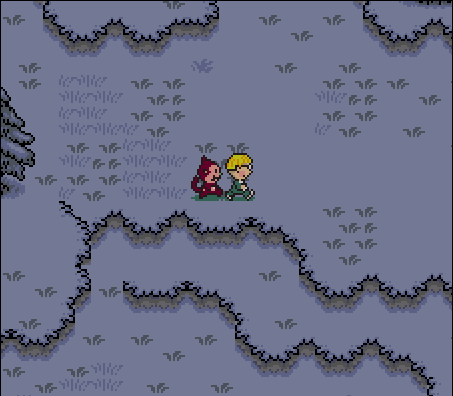
According to some early developer notes, the monkey was going to behave slightly differently. Here’s a translation:
★Whenever there’s a banana or an apple on the ground nearby, the Balloon Monkey will go over to it (is this possible?) and eat it.
My guess is that the final distracted animation was an easier-to-implement compromise of sorts, or maybe it just didn’t make sense for apples and bananas to be lying on the ground in such a wintry location.
Finding a Workaround
Throughout much of the game, a researcher in a big museum blocks a door for no apparent reason. Once you finally get through the door, you find a room that’s completely empty, except – for some reason – an open manhole that leads into the sewers. It turns out this odd layout was a solution to an art or graphics problem:
Moving the manhole cover move will be difficult to do graphically, so (after talking with Ōyama) we’ve currently changed it so a door in front of the manhole is what opens instead.
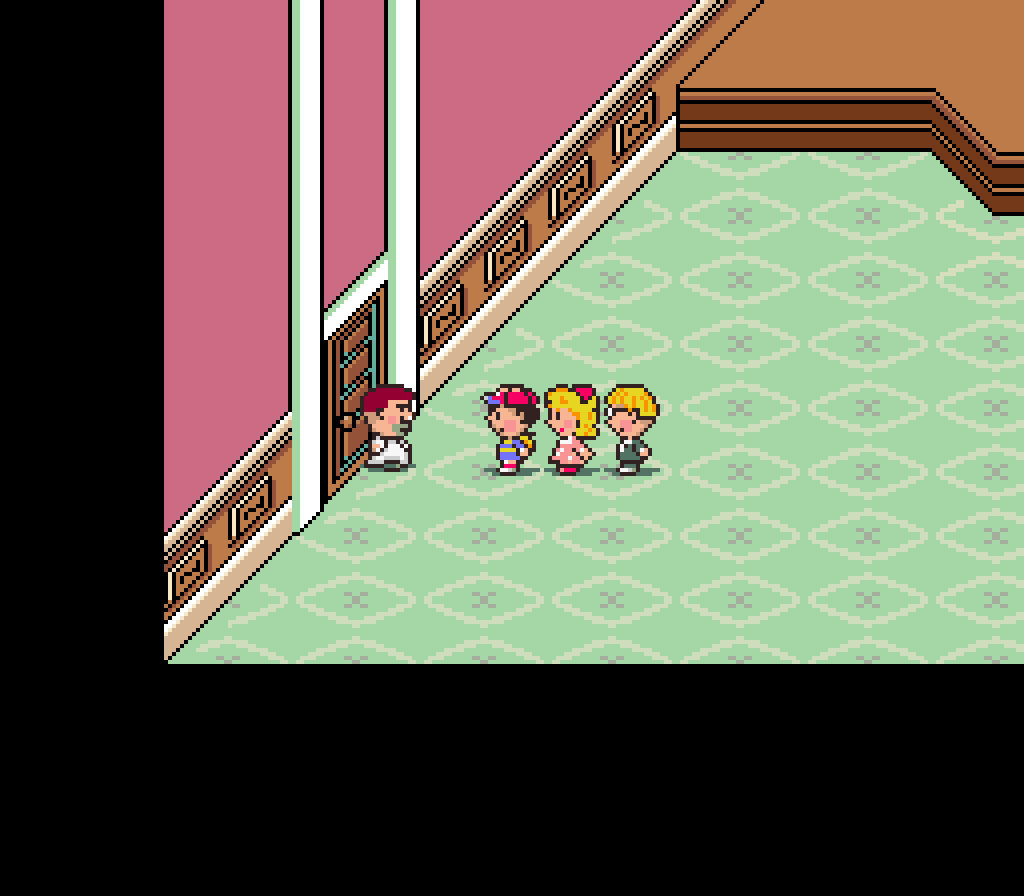
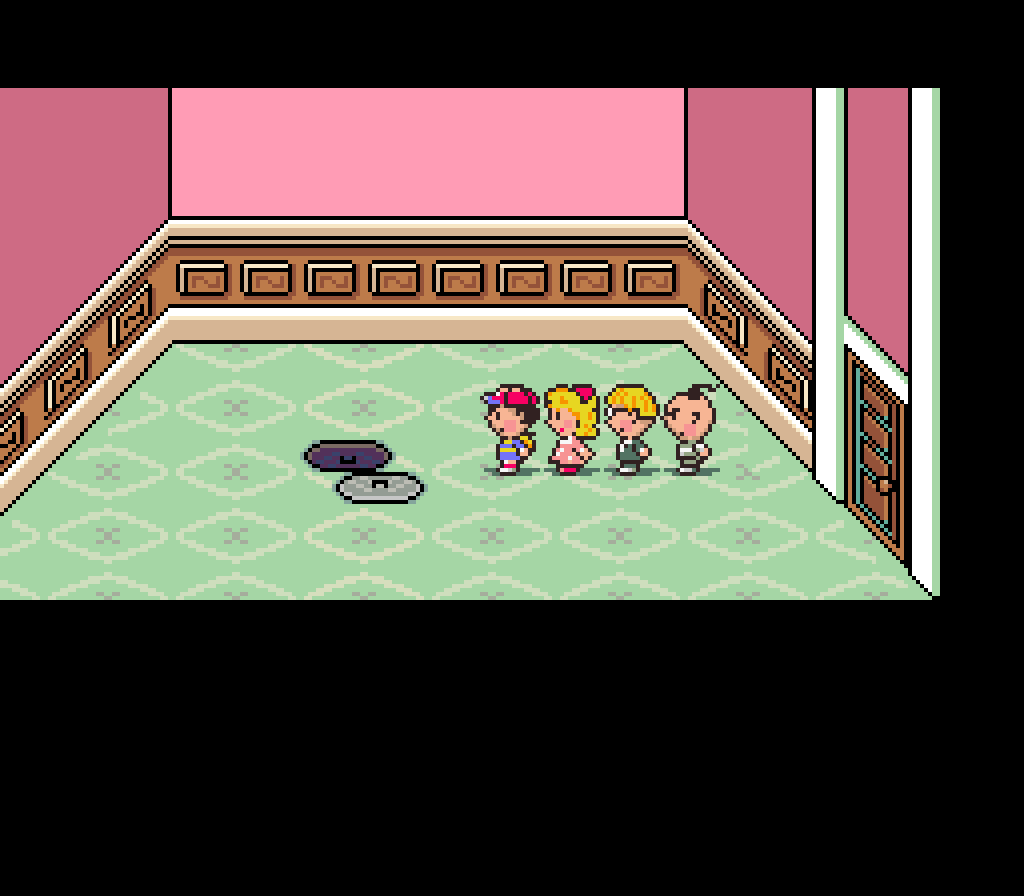
Winter CES 1995 Demo
For years, I thought that EarthBound first debuted at the E3 event in 1995. Magazines mentioned it at E3 1995, and we even have some rare photos of it being shown at E3 1995. But it turns out that it actually debuted many months earlier, at the Winter CES in January of 1995.
This was half a year before EarthBound’s release, so there wasn’t much to show off yet. From what I’ve heard, EarthBound was mostly in a broken, barely playable state until weeks before the game’s release in June 1995. Even so, a demo version of EarthBound was apparently playable at this CES event.
Details are still very sparse about the CES demo, but luckily these old development files still contained some text and information about it:
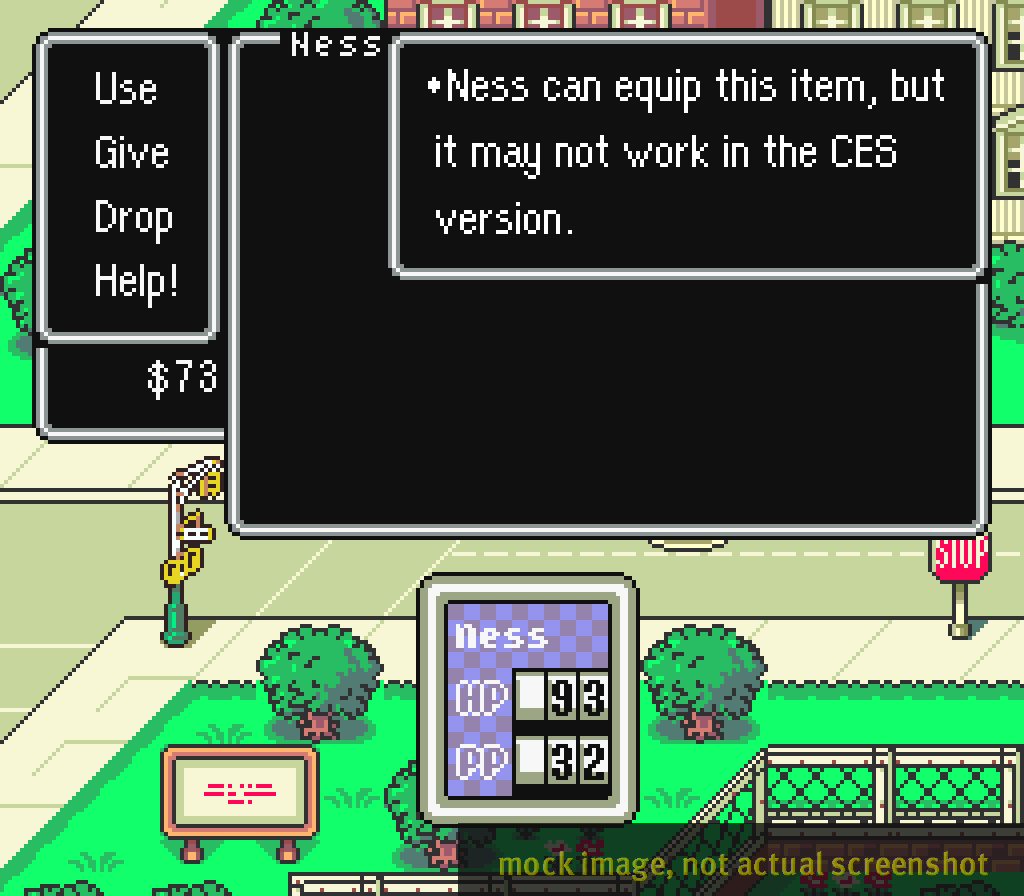
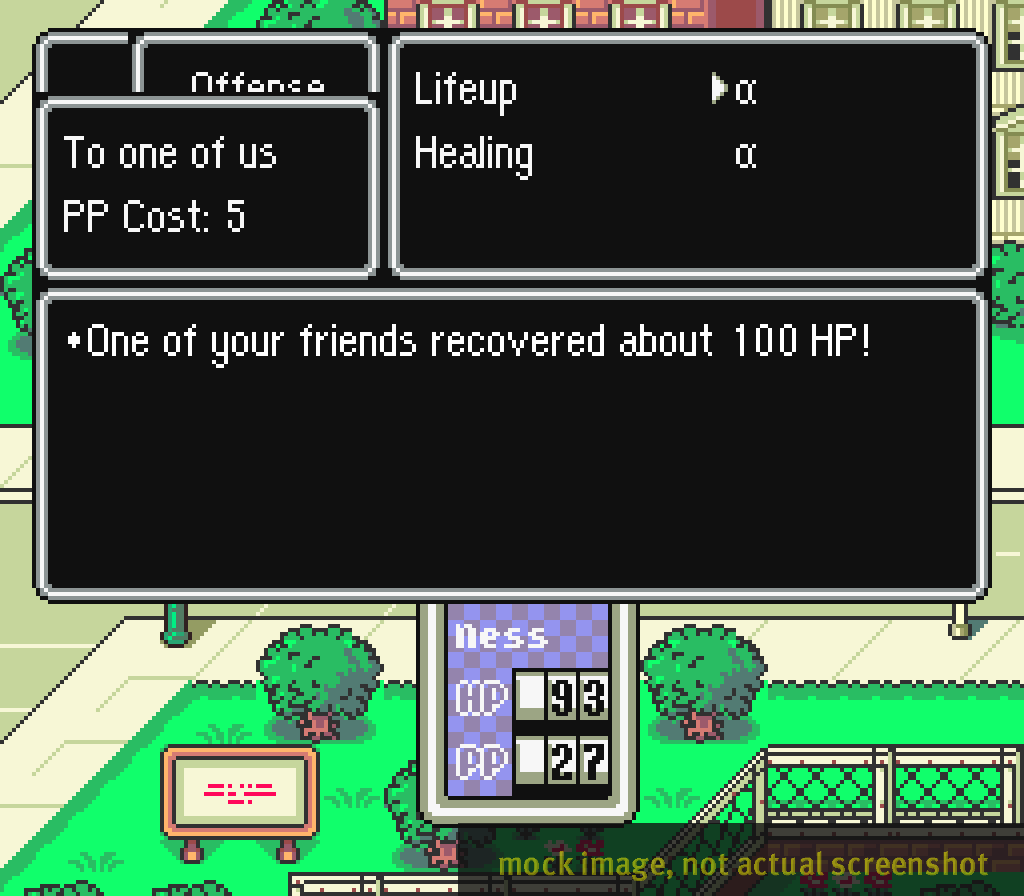
– note that this skill description was mistranslated as a “skill was just used” message
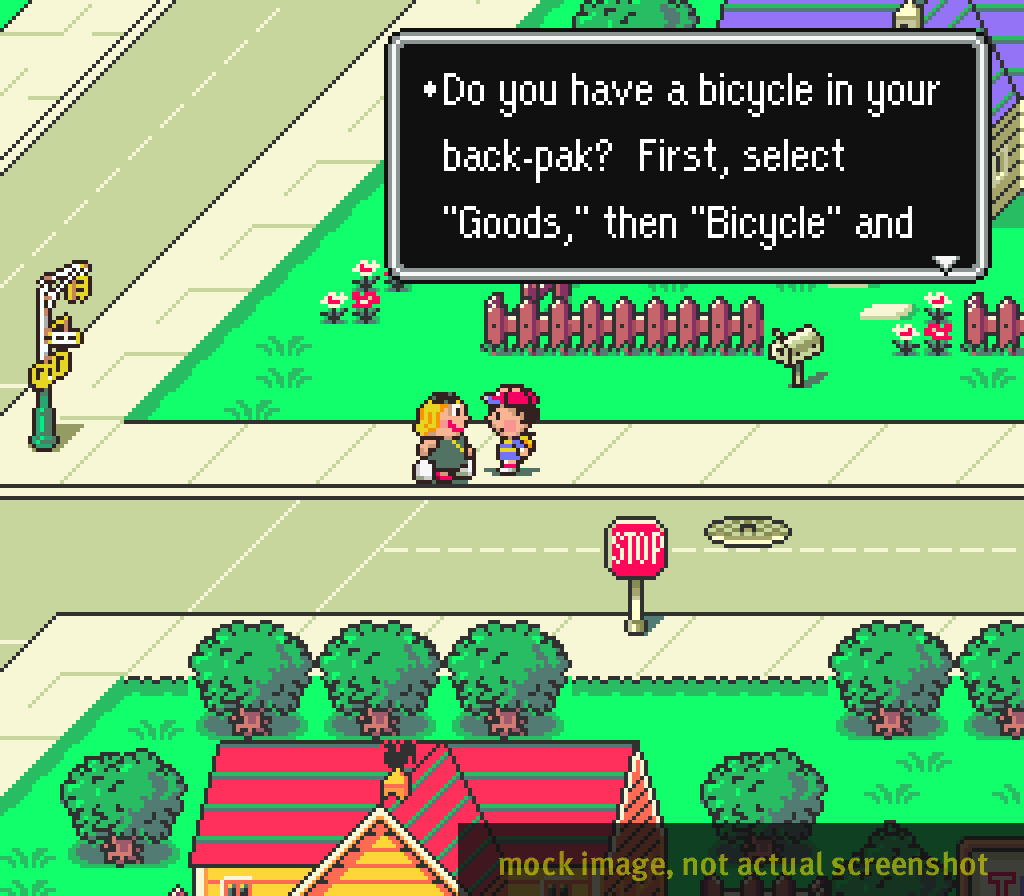
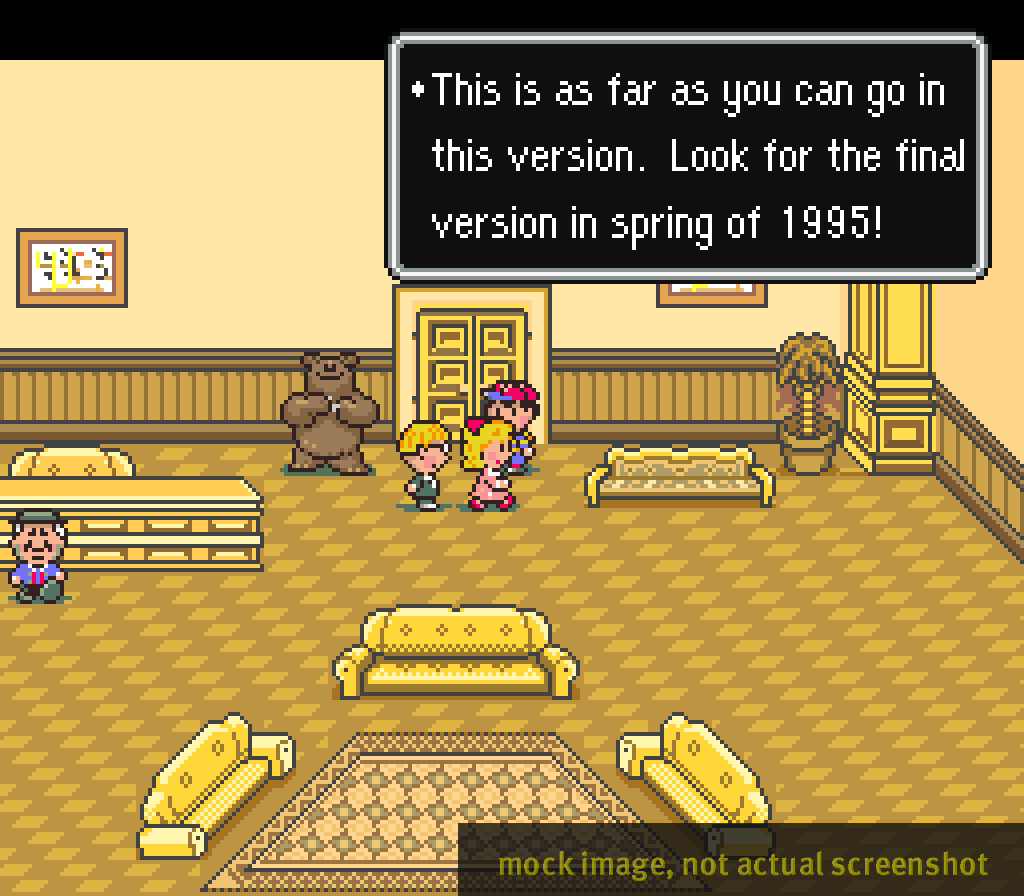
wouldn’t be released until the summer of 1995
Oh, how I’d love to see this demo in action someday! It could lead to even more fascinating discoveries, and I’d be interested to see what all the characters, enemies, and items were called at that early point in the localization’s development.
Final Thoughts
Again, everything here is just a fraction of the stuff that’s been uncovered in these old EarthBound development/localization files. Of course, there’s lots of mundane information to wade through, but there are many other discoveries just as interested as what I’ve listed here. I bet I could fill an entire new book with stuff I’ve found in these files.
Anyway, when I think about it now, I’ve been running EarthBound sites and working on EarthBound projects for the past twenty years. Yet, even after all this time, there’s one thought I keep returning to: I can’t believe we’re still discovering so much about this old game from 25 years ago!

